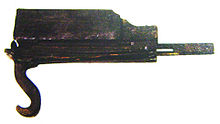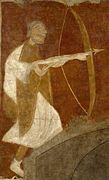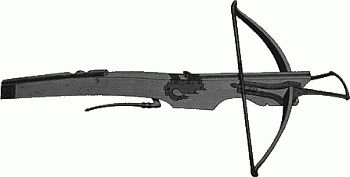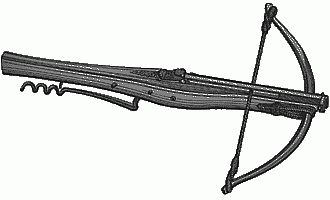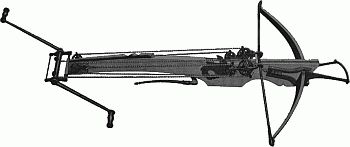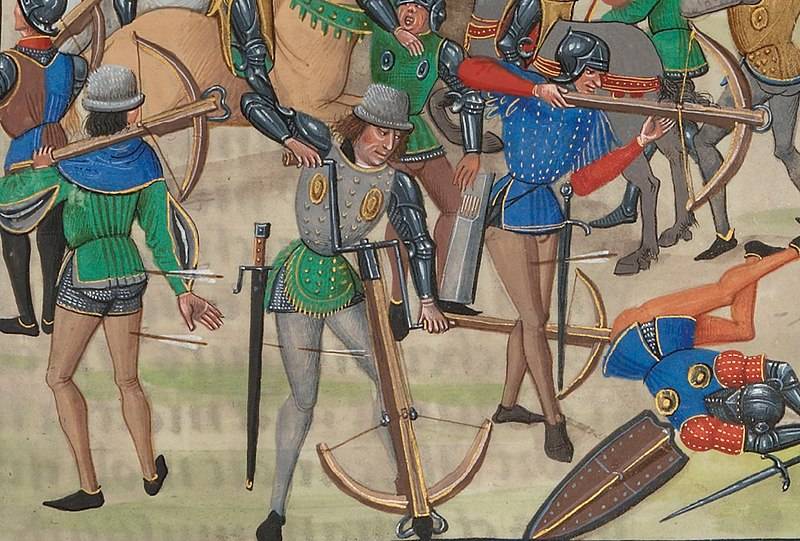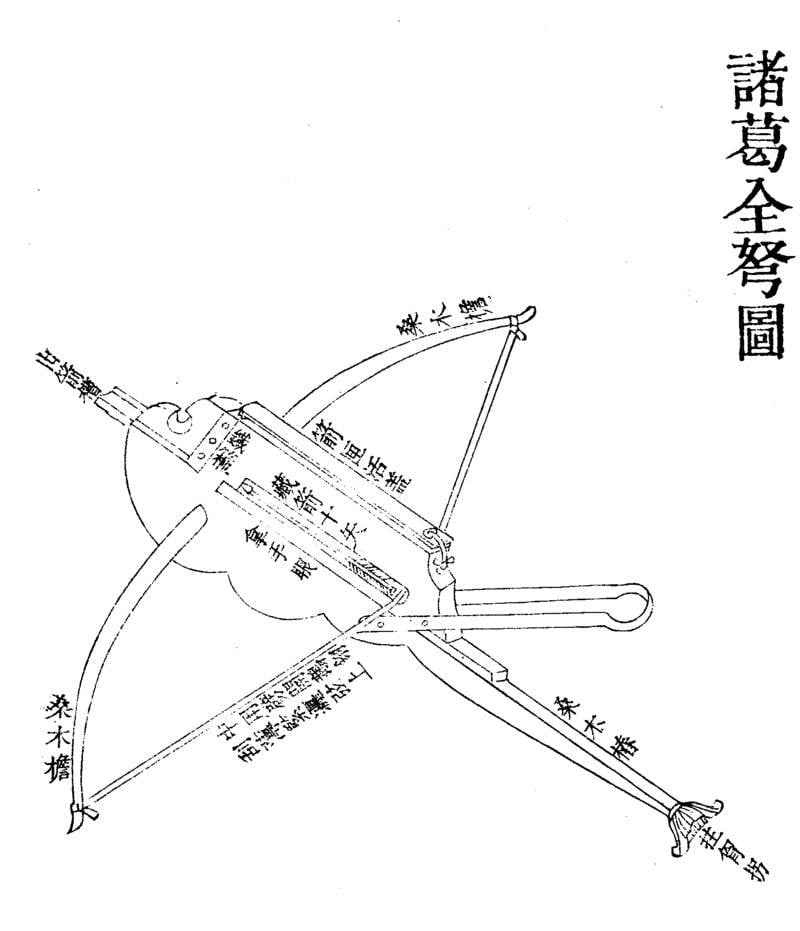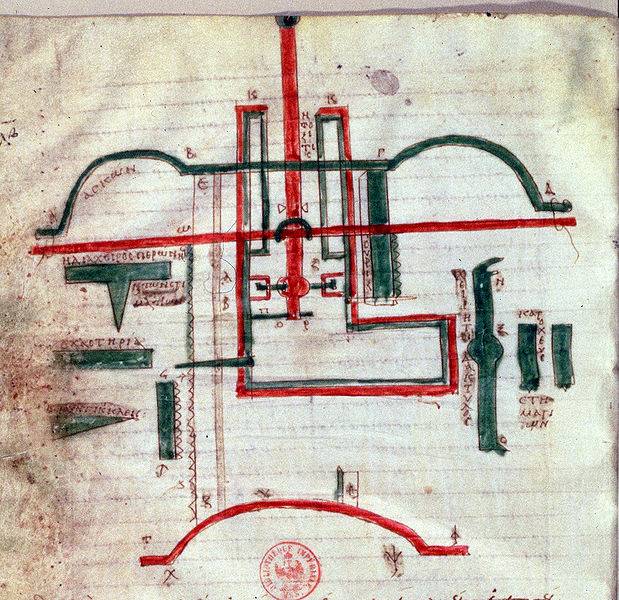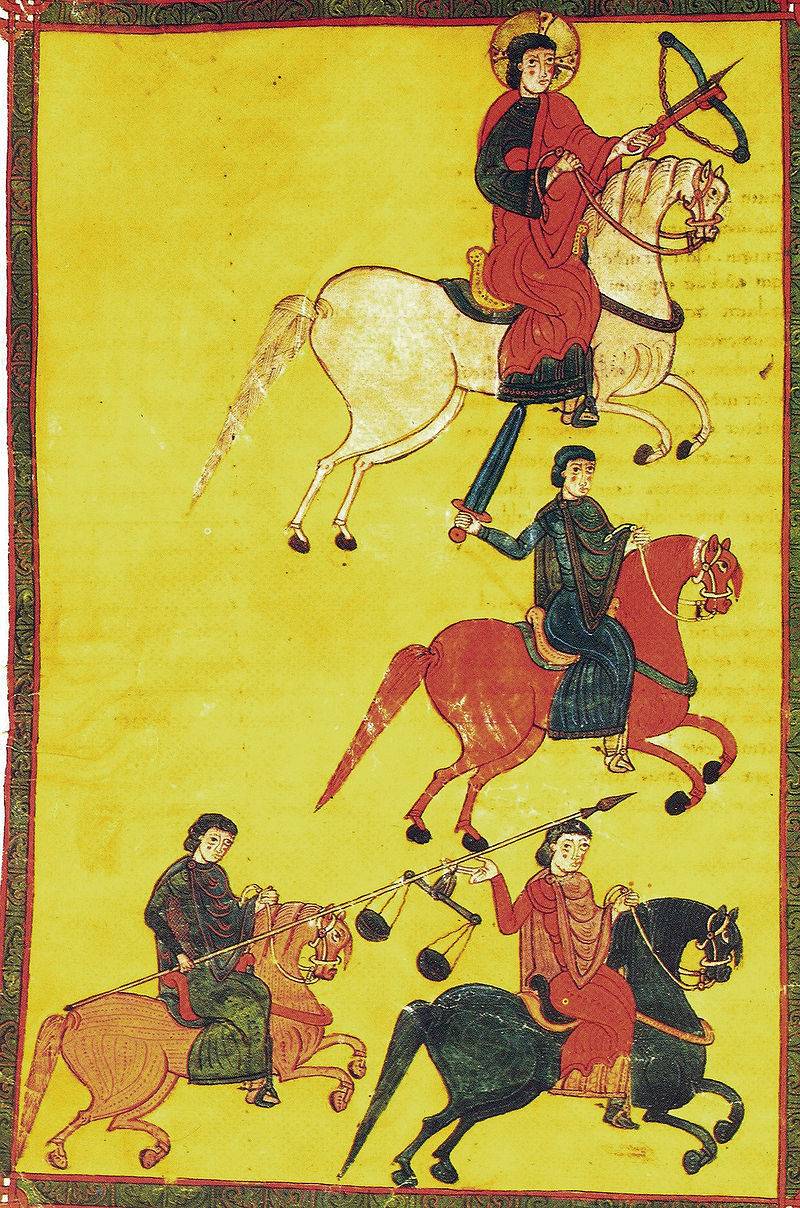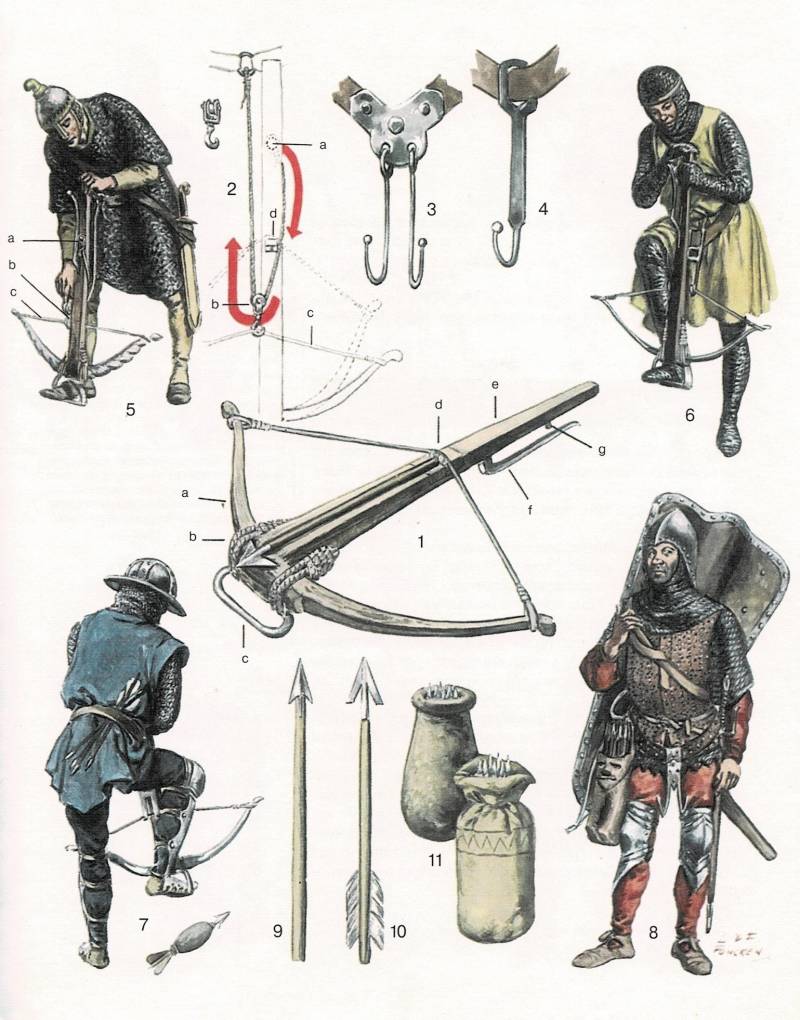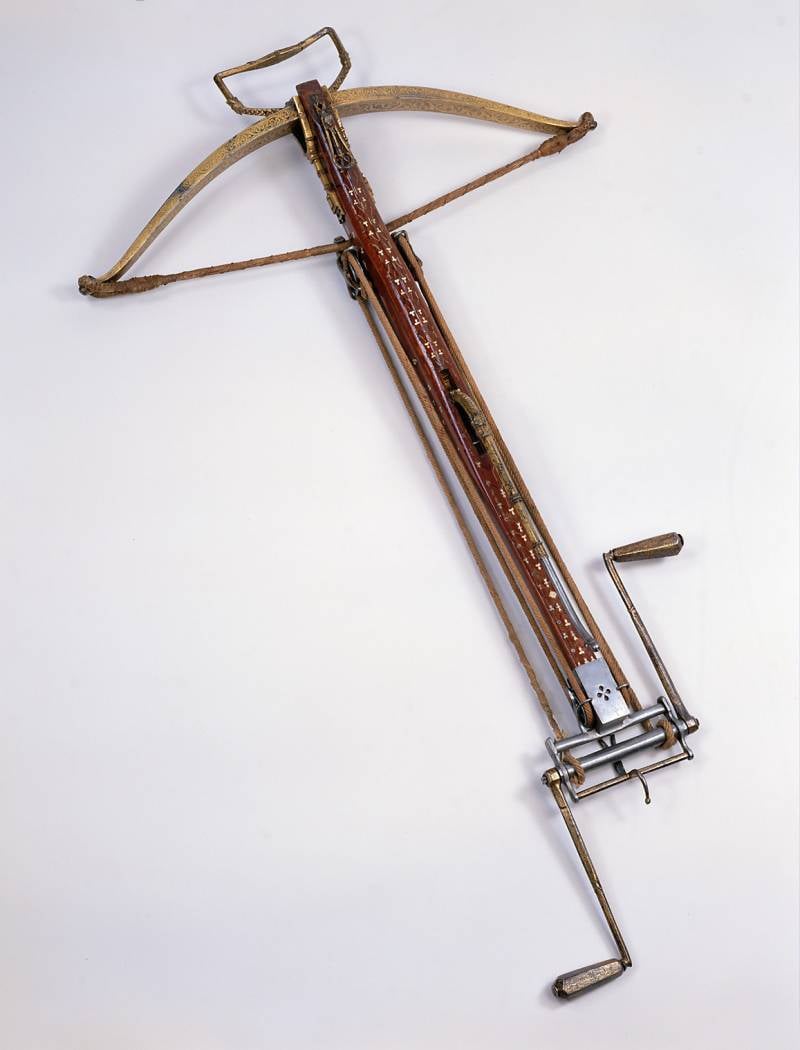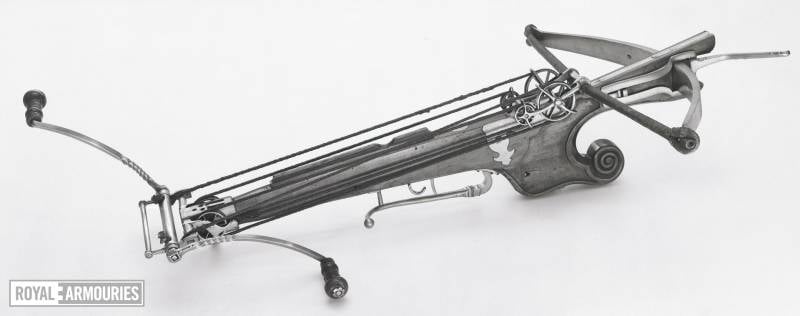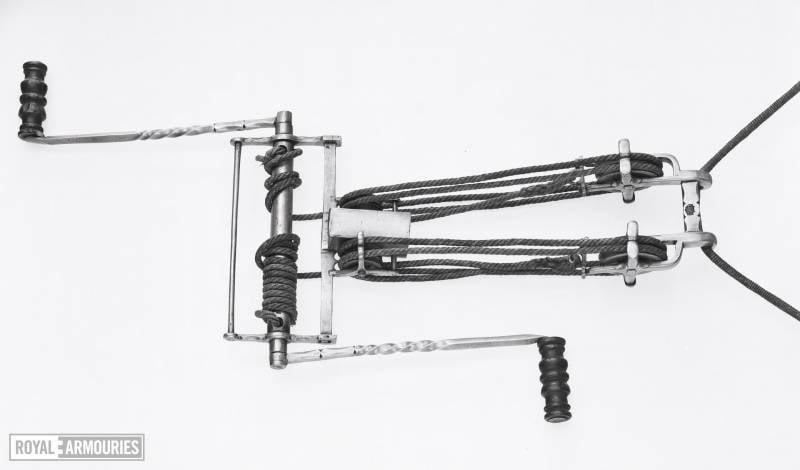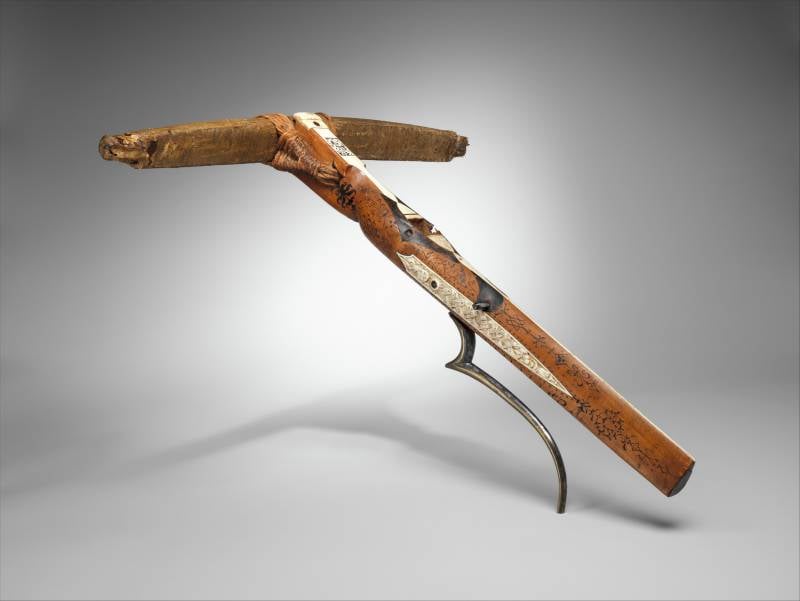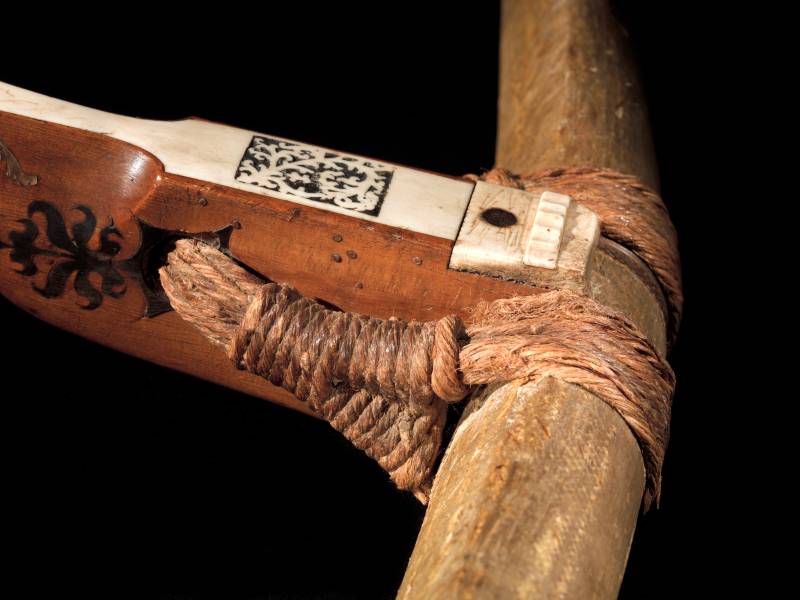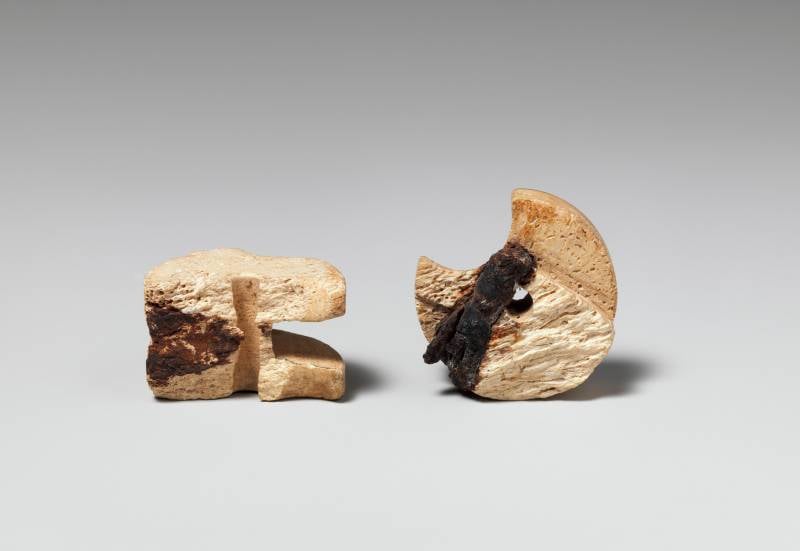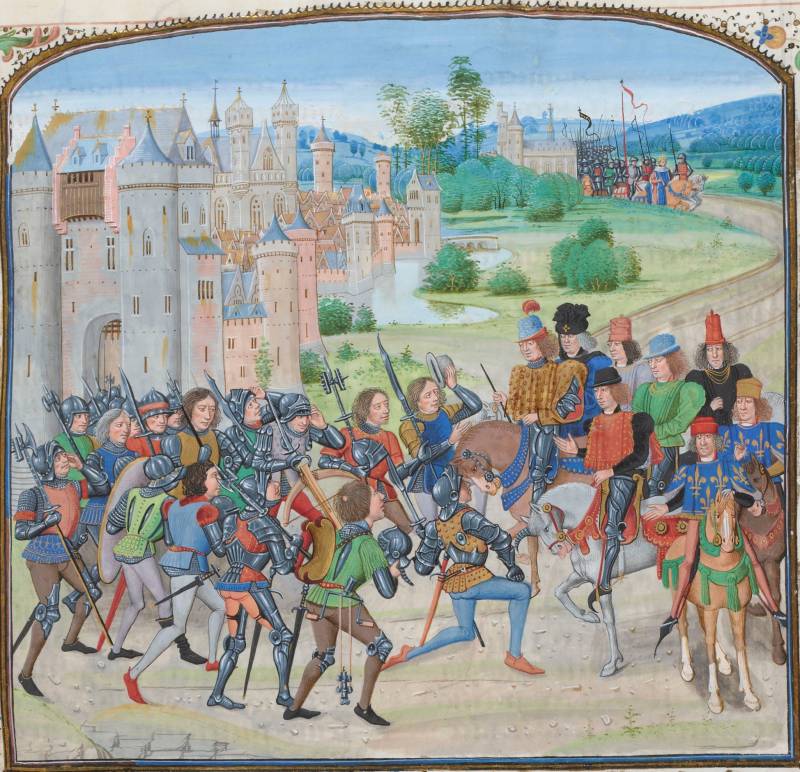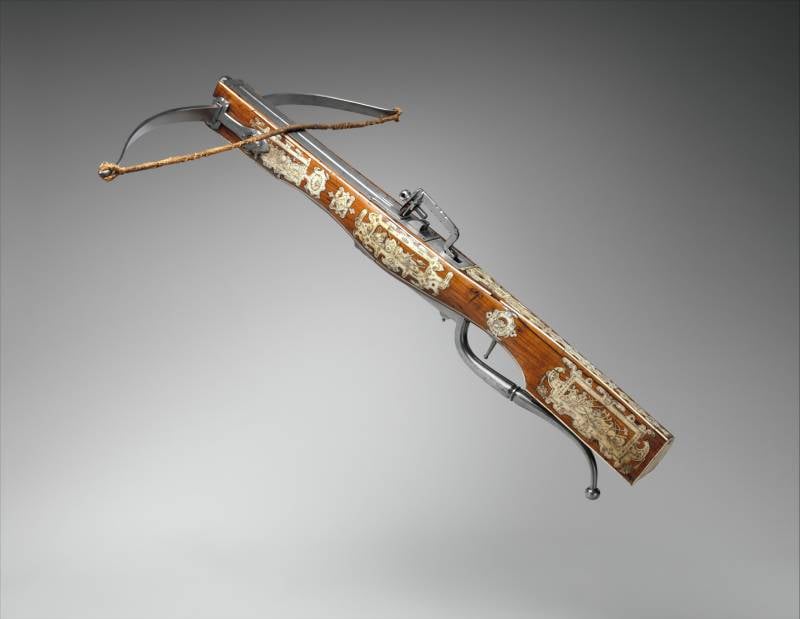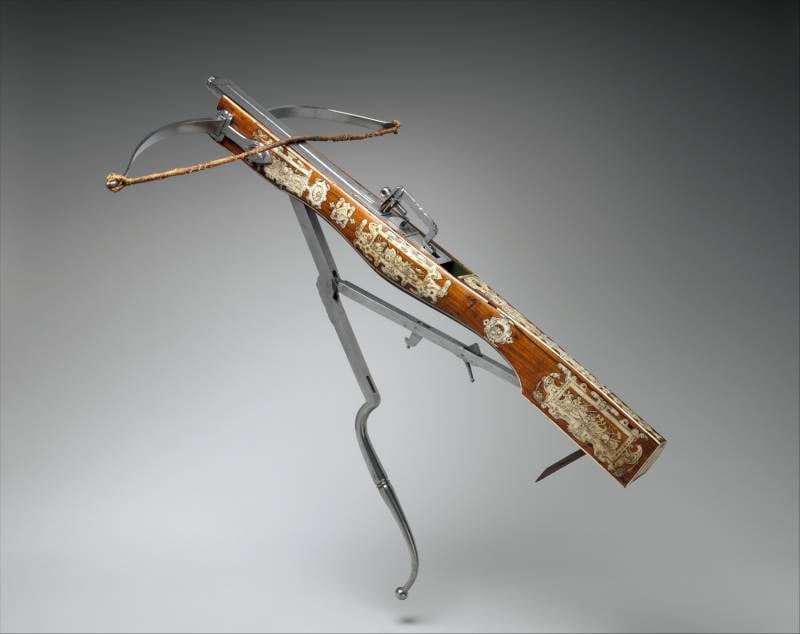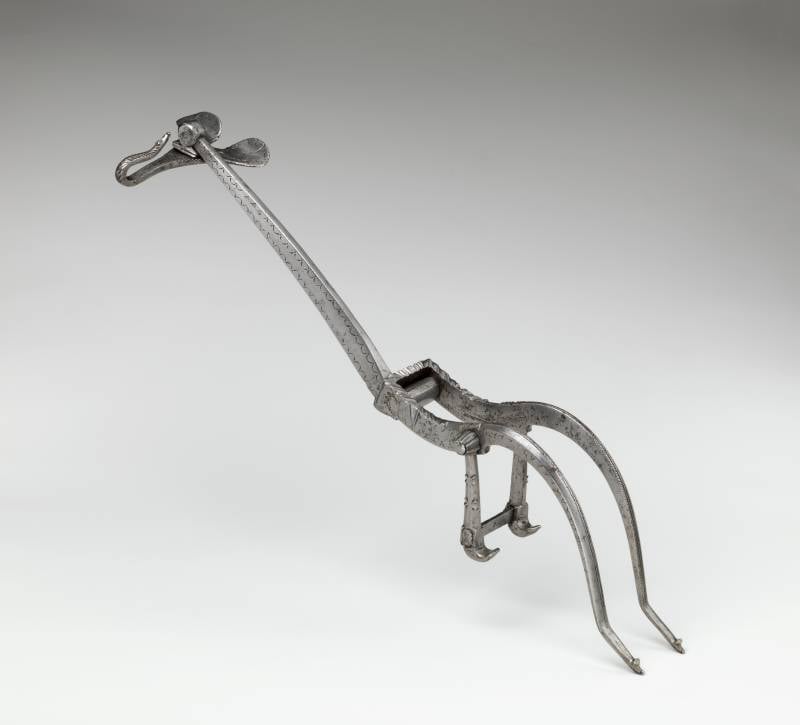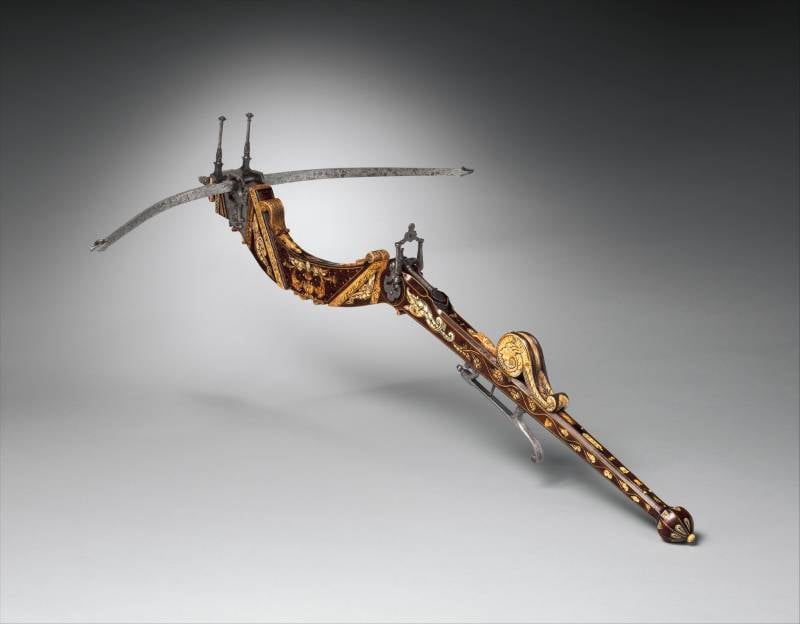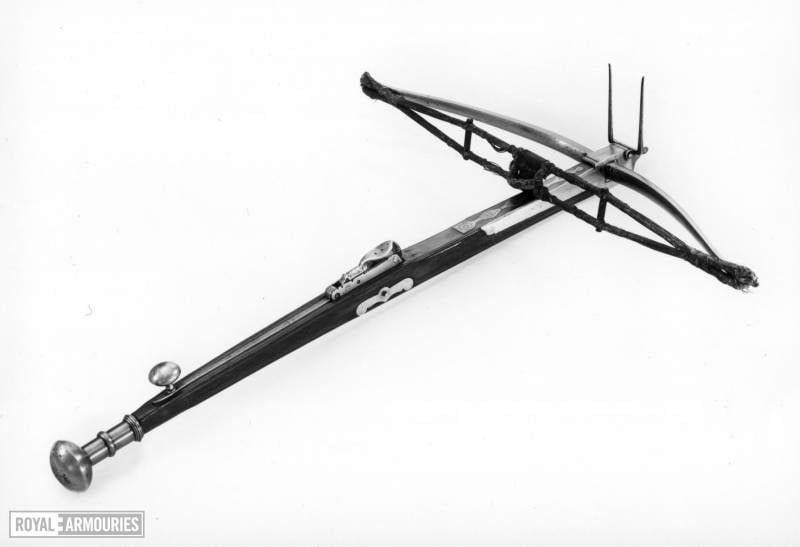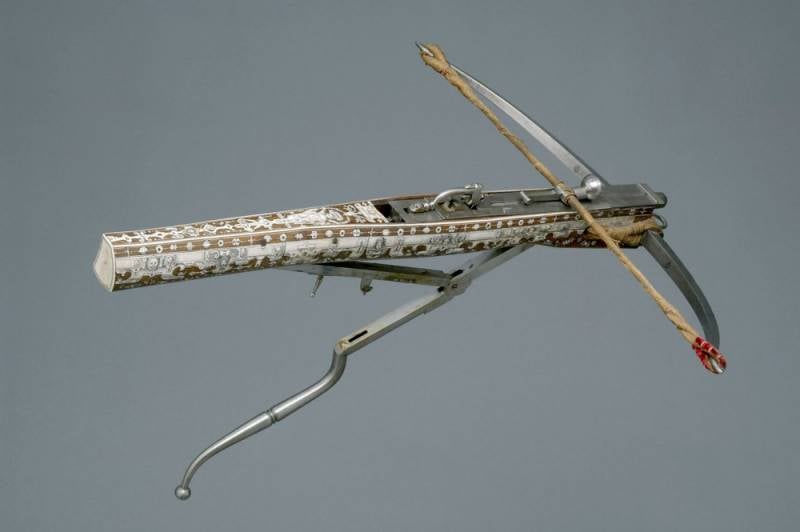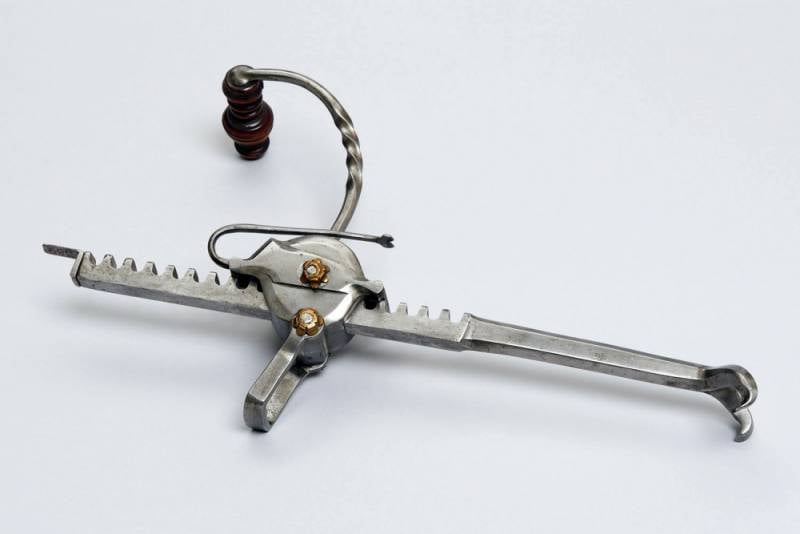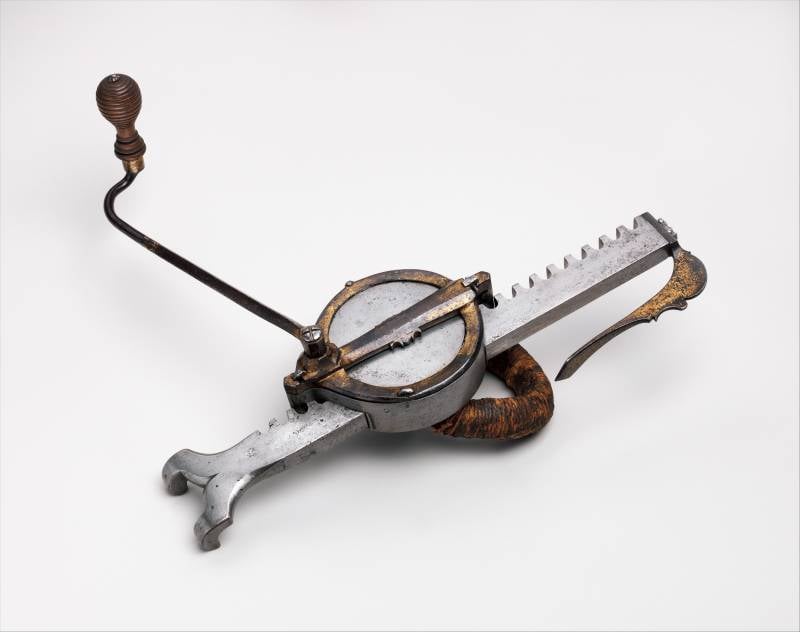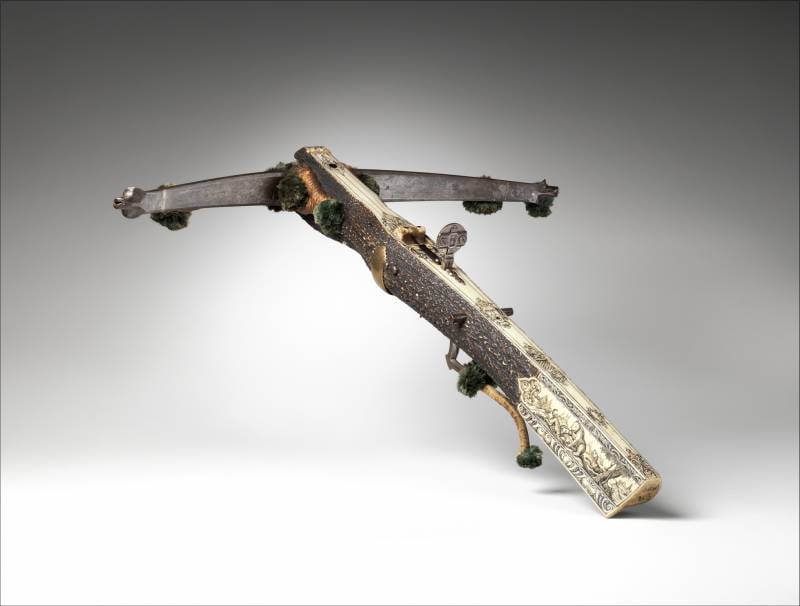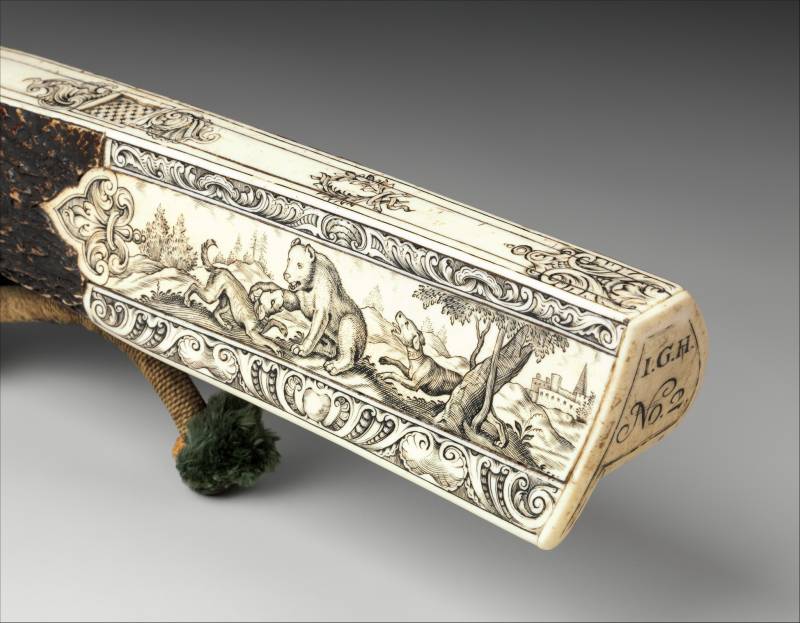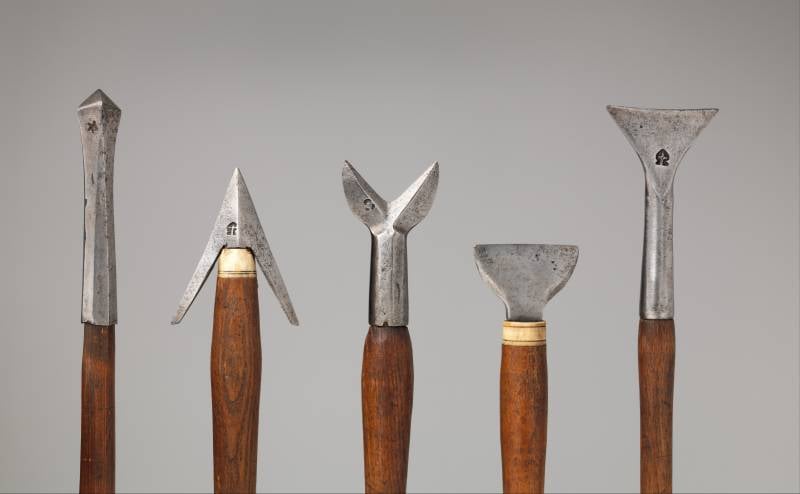It is not clear where and when the crossbow originated, but it is believed to have appeared in China and Europe around the 7th to 5th centuries BC. In China the crossbow was one of the primary military weapons from the Warring States period until the end of the Han dynasty, when armies composed of up to 30 to 50 percent crossbowmen were not unheard of. The crossbow lost much of its popularity after the fall of the Han dynasty, likely due to the rise of the more resilient heavy cavalry during the Six Dynasties. One Tang dynasty source recommends a bow to crossbow ratio of five to one as well as the utilization of the countermarch to make up for the crossbow’s lack of speed.[1] The crossbow countermarch technique was further refined in the Song dynasty, but crossbow usage in the military continued to decline after the Mongol conquest of China.[2] Although the crossbow never regained the prominence it once had under the Han, it was never completely phased out either. Even as late as the 17th century, military theorists were still recommending it for wider military adoption, but production had already shifted in favor of firearms and traditional composite bows.[3]
In the Western world a crossbow known as the gastraphetes was described by the Greco-Roman scientist Heron of Alexandria in the 1st century AD. He believed it was the forerunner of the catapult, which places its appearance sometime prior to the 4th century BC during the Classical period.[4] Other than the gastraphetes, the only other evidence of crossbows in ancient Europe are two stone relief carvings from a Roman grave in Gaul and some vague references by Vegetius. Pictish imagery from medieval Scotland dated between the 6th and 9th centuries AD do show what appear to be crossbows, but only for hunting, and not military usage. It’s not clear how widespread crossbows were in Europe prior to the medieval period or if they were even used for warfare. The small body of evidence and the context they provide point to the fact that the ancient European crossbow was primarily a hunting tool or minor siege weapon. An assortment of other ancient European bolt throwers exist such as the ballista, but these were torsion engines and are not considered crossbows. Crossbows are not mentioned in European sources again until 947 as a French weapon during the siege of Senlis.[5] From the 11th century onward, crossbows and crossbowmen occupied a position of high status in medieval European militaries, with the exception of the English and their continued use of the longbow. During the 16th century military crossbows in Europe were superseded by gunpowder weaponry such as cannons and muskets. Hunters continued to carry crossbows for another 150 years due to its silence.[6]
There is a theory that medieval European crossbows originate from China but some differences exist between the two trigger mechanisms used in European and Chinese crossbows.[7]
Terminology[edit]
Han crossbow trigger pieces
A crossbowman or crossbow-maker is sometimes called an arbalist or arbalest.[8]
Arrow, bolt and quarrel are all suitable terms for crossbow projectiles.[8]
The lath, also called the prod, is the bow of the crossbow. According to W.F. Peterson, the prod came into usage in the 19th century as a result of mistranslating rodd in a 16th-century list of crossbow effects.[8]
The stock is the wooden body on which the bow is mounted, although the medieval tiller is also used.[8]
The lock refers to the release mechanism, including the string, sears, trigger lever, and housing.[8]
China[edit]
Illustration of a Ming volley fire formation using crossbows. From Cheng Zongyou 程宗猷, Jue zhang xin fa 蹶張心法 ca. 1621.
Illustration of another Ming crossbow volley fire formation. From Bi Maokang 畢懋康, Jun qi tu shuo 軍器圖說, ca. 1639.
Warring States[edit]
In terms of archaeological evidence, crossbow locks made of cast bronze have been found in China dating to around 650 BC.[8] They have also been found in Tombs 3 and 12 at Qufu, Shandong, previously the capital of Lu, and date to 6th century BC.[9][10] Bronze crossbow bolts dating from the mid-5th century BC have been found at a Chu burial site in Yutaishan, Jiangling County, Hubei Province.[11] Other early finds of crossbows were discovered in Tomb 138 at Saobatang, Hunan Province, and date to mid-4th century BC.[12][13] It’s possible that these early crossbows used spherical pellets for ammunition. A Western-Han mathematician and music theorist, Jing Fang (78-37 BC), compared the moon to the shape of a round crossbow bullet.[14] Zhuangzi also mentions crossbow bullets.[15]
The earliest Chinese documents mentioning a crossbow were texts from the 4th to 3rd centuries BC attributed to the followers of Mozi. This source refers to the use of a giant crossbow between the 6th and 5th centuries BC, corresponding to the late Spring and Autumn Period. Sun Tzu’s The Art of War (first appearance dated between 500 BC to 300 BC[16]) refers to the characteristics and use of crossbows in chapters 5 and 12 respectively,[17] and compares a drawn crossbow to ‘might.’[18]
The state of Chu favorited elite armoured crossbow units known for their endurance, and were capable of marching 160 km ‘without resting.’[19] Wei’s elite forces were capable of marching over 40 km in one day while wearing heavy armour, a large crossbow with 50 bolts, a helmet, a side sword, and three days worth of rations. Those who met these standards earned an exemption from corvée labor and taxes for their entire family.[20]
Han dynasty[edit]
The Huainanzi advises its readers not to use crossbows in marshland where the surface is soft and it is hard to arm the crossbow with the foot.[21] The Records of the Grand Historian, completed in 94 BC, mentions that Sun Bin defeated Pang Juan by ambushing him with a body of crossbowmen at the Battle of Maling.[22] The Book of Han, finished 111 AD, lists two military treatises on crossbows.[23]
In the 2nd century AD, Chen Yin gave advice on shooting with a crossbow in the Wuyue Chunqiu:
When shooting, the body should be as steady as a board, and the head mobile like an egg [on a table]; the left foot [forward] and the right foot perpendicular to it; the left hand as if leaning against a branch, the right hand as if embracing a child. Then grip the crossbow and take a sight on the enemy, hold the breath and swallow, then breathe out as soon as you have released [the arrow]; in this way you will be unperturbable. Thus after deep concentration, the two things separate, the [arrow] going, and the [bow] staying. When the right hand moves the trigger [in releasing the arrow] the left hand should not know it. One body, yet different functions [of parts], like a man and a girl well matched; such is the Dao of holding the crossbow and shooting accurately.[24]
— Chen Yin
It’s clear from surviving inventory lists in Gansu and Xinjiang that the crossbow was greatly favored by the Han dynasty. For example, in one batch of slips there are only two mentions of bows, but thirty mentions of crossbows.[21] Crossbows were mass-produced in state armories with designs improving as time went on, such as the use of a mulberry wood stock and brass; a crossbow in 1068 could pierce a tree at 140 paces.[25] Crossbows were used in numbers as large as 50,000 starting from the Qin dynasty and upwards of several hundred thousand during the Han.[26] According to one authority, the crossbow had become «nothing less than the standard weapon of the Han armies,» by the second century BC.[27] Han era carved stone images and paintings also contain images of horsemen wielding crossbows. Han soldiers were required to pull an «entry level» crossbow with a draw-weight of 76 kg to qualify as a crossbowman.[8]
| Item | Number | Government |
|---|---|---|
| Crossbow | 537,707 | 11,181 |
| Crossbow bolts | 11,458,424 | 34,265 |
| Bow | 77,521 | |
| Arrows | 1,199,316 | 511 |
-
-
Han crossbow trigger on a crossbow frame
-
Large crossbow trigger (23.49 x 17.78 cm) for mounted crossbows, Han dynasty
Later history[edit]
Korean giant naval crossbow (repeating)
Before the Han Dynasty, the trigger mechanism did not have a Guo (郭, a casing), so that the parts of the trigger mechanism were installed in the wooden frame directly. After the Han Dynasty, the original crossbow has two important design improvements. The first one is to add a bronze casing, and the other is to include a scale table with the shooting range on the trigger mechanism. The parts of the trigger mechanism installed in the bronze casing can provide higher tension than those installed on the wooden frame. As a result, its shooting range has increased greatly. Adding a scale table with the shooting range on the trigger mechanism increases the accuracy of the shooting and helps the shooter to hit the target more easily. After the Han Dynasty, the structures of the original crossbow and trigger mechanism have not changed except that the size became larger to increase the shooting range.[28]
After the Han dynasty, the crossbow lost favor until it experienced a mild resurgence during the Tang dynasty, under which the ideal expeditionary army of 20,000 included 2,200 archers and 2,000 crossbowmen.[29] Li Jing and Li Quan prescribed 20 percent of the infantry to be armed with standard crossbows, which could hit the target half the time at a distance of 345 meters, but had an effective range of 225 meters.[30]
During the Song dynasty, the government attempted to restrict the spread of military crossbows and sought ways to keep armour and crossbows out of private homes.[31] Despite the ban on certain types of crossbows, the weapon experienced an upsurge in civilian usage as both a hunting weapon and pastime. The «romantic young people from rich families, and others who had nothing particular to do» formed crossbow shooting clubs as a way to pass time.[32]
During the late Ming dynasty, no crossbows were mentioned to have been produced in the three-year period from 1619 to 1622. With 21,188,366 taels, the Ming manufactured 25,134 cannons, 8,252 small guns, 6,425 muskets, 4,090 culverins, 98,547 polearms and swords, 26,214 great «horse decapitator» swords, 42,800 bows, 1,000 great axes, 2,284,000 arrows, 180,000 fire arrows, 64,000 bow strings, and hundreds of transport carts.[33]
Military crossbows were armed by treading, or basically placing the feet on the bow stave and drawing it using one’s arms and back muscles. During the Song dynasty, stirrups were added for ease of drawing and to mitigate damage to the bow. Alternatively the bow could also be drawn by a belt claw attached to the waist, but this was done lying down, as was the case for all large crossbows. Winch-drawing was used for the large mounted crossbows as seen below, but evidence for its use in Chinese hand-crossbows is scant.[34]
| Army | Chariot | Crossbow | Bow | Cavalry | Assault | Maneuver | Halberd | Spear | Basic infantry | Supply | Total |
|---|---|---|---|---|---|---|---|---|---|---|---|
| Ideal WS | 6,000 | 2,000 | 2,000 | 10,000 | |||||||
| Ideal WS Zhao | 1,300 | 100,000 | 13,000 | 50,000 | 164,300 | ||||||
| Anti-Xiongnu Han (97 BC) | 70,000 | 140,000 | 210,000 | ||||||||
| Later Zhao | 27,000 | 60,000 | 87,000 | ||||||||
| Former Qin | 270,000 | 250,000 | 350,000 | 870,000 | |||||||
| Basic Sui expedition | 4,000 | 8,000 | 8,000 | 20,000 | |||||||
| Basic early Tang expedition | 2,000 | 2,200 | 4,000 | 2,900 | 2,900 | 6,000 | 20,000 |
Advantages and disadvantages[edit]
Now for piercing through hard things and shooting a long distance, and when struggling to defend mountain-passes, where much noise and impetuous strength must be stemmed, there is nothing like the crossbow for success. However, as the drawing (i.e. the arming) is slow, it is difficult to cope with sudden attacks. A crossbow can only be shot off [by a single man] three times before it comes to hand-to-hand weapons. Some have therefore thought crossbows inconvenient for fighting, but truly the inconvenience lay not in the crossbow itself but in the commanders, who did not know how to make use of crossbows. All the military theorists of the Tang maintained that the crossbow had no advantage over hand-to-hand weapons, and they insisted on having long bills and great shields in the front line to repel the charge, and made the crossbowmen to carry sabres and long-hafted weapons. The result was that if the enemy adopted an open-order formation and attacked with hand-to-hand weapons, the soldiers would throw away their crossbows and have recourse to those also. A body of the rearguard was therefore detailed beforehand to go round and collect up the crossbows.[2]
The crossbow allowed archers to shoot bows of greater strength and more accurately as well due to its greater stability, but at the cost of speed.[35]
In 169 BC, Chao Cuo observed that by using the crossbow, it was possible to overcome the Xiongnu:
Of course, in mounted archery [using the short bow] the Yi and the Di are skilful, but the Chinese are good at using nu che. These carriages can be drawn up in the form of a laager which cannot be penetrated by cavalry. Moreover, the crossbows can shoot their bolts to a considerable range, and do more harm [lit. penetrate deeper] than those of the short bow. And again, if the crossbow bolts are picked up by the barbarians they have no way of making use of them. Recently the crossbow has unfortunately fallen into some neglect; we must carefully consider this… The strong crossbow [jing nu] and the [arcuballista shooting] javelins have a long range; something which the bows of the Huns can no way equal. The use of sharp weapons with long and short handles by disciplined companies of armoured soldiers in various combinations, including the drill of crossbow men alternately advancing [to shoot] and retiring [to load]; this is something which the Huns cannot even face. The troops with crossbows ride forward [cai guan shou] and shoot off all their bolts in one direction; this is something which the leather armour and wooden shields of the Huns cannot resist. Then the [horse-archers] dismount and fight forward on foot with sword and bill; this is something which the Huns do not know how to do.[36]
The Wujing Zongyao states that the crossbow used en masse was the most effective weapon against northern nomadic cavalry charges. Even if they failed, the quarrels were too short to be used as regular arrows so they couldn’t be used again by nomadic archers after the battle.[37] The crossbow’s role as an anti-cavalry weapon was later reaffirmed in Medieval Europe when Thomas the Archdeacon recommended them as the optimal weapon against the Mongols.[38] Elite crossbowmen were used to pick off targets as was the case when the Liao Dynasty general Xiao Talin was picked off by a Song crossbowman at the Battle of Shanzhou in 1004.[37]
Repeating crossbow[edit]
The earliest extant repeating crossbow, a double-shot repeating crossbow excavated from a tomb of the State of Chu, 4th century BC.
The Zhuge Nu is a handy little weapon that even the Confucian scholar or palace women can use in self-defence… It fires weakly so you have to tip the darts with poison. Once the darts are tipped with «tiger-killing poison», you can shoot it at a horse or a man and as long as you draw blood, your adversary will die immediately. The draw-back to the weapon is its very limited range.[8]
According to the Wu-Yue Chunqiu (history of the Wu-Yue War), written in the Eastern Han dynasty, the repeating crossbow was invented during the Warring States Period by a Mr. Qin from the State of Chu. This is corroborated by the earliest archaeological evidence of repeating crossbows, which was excavated from a Chu burial site at Tomb 47 at Qinjiazui, Hubei Province, and has been dated to the 4th century BC, during the Warring States Period (475 – 220 BC).[39] Unlike repeating crossbows of later eras, the ancient double shot repeating crossbow uses a pistol grip and a rear pulling mechanism for arming. The Ming repeating crossbow uses an arming mechanism which requires its user to push a rear lever upwards and downwards back and forth.[40] Although hand held repeating crossbows were generally weak and required additional poison, probably aconite, for lethality, much larger mounted versions appeared during the Ming dynasty.[8]
In 180 AD, Yang Xuan used a type of repeating crossbow powered by the movement of wheels:
…around A.D. 180 when Yang Xuan, Grand Protector of Lingling, attempted to suppress heavy rebel activity with badly inadequate forces. Yang’s solution was to load several tens of wagons with sacks of lime and mount automatic crossbows on others. Then, deploying them into a fighting formation, he exploited the wind to engulf the enemy with clouds of lime dust, blinding them, before setting rags on the tails of the horses pulling these driverless artillery wagons alight. Directed into the enemy’s heavily obscured formation, their repeating crossbows (powered by linkage with the wheels) fired repeatedly in random directions, inflicting heavy casualties. Amidst the obviously great confusion the rebels fired back furiously in self-defense, decimating each other before Yang’s forces came up and largely exterminated them.[41]
— Ralph Sawyer
Although the invention of the repeating crossbow has often been attributed to Zhuge Liang, he in fact had nothing to do with it. This misconception is based on a record attributing improvements to the multiple bolt crossbows to him.[42]
During the Ming dynasty, repeating crossbows were used on ships.[41]
Repeating crossbows continued in use until the late Qing dynasty when it became obvious they could not longer compete with firearms.[41]
Mounted crossbow[edit]
Connected double bed crossbows
Large and small Qin crossbow bolts
Large mounted crossbows known as «bed crossbows» were used as early as the Warring States period. Mozi described them as defensive weapons placed on top of the battlements. The Mohist siege crossbow was described as humongous device with frameworks taller than a man and shooting arrows with cords attached so that they could be pulled back. By the Han dynasty, crossbows were used as mobile field artillery and known as «Military Strong Carts».[41] Around the 5th century AD, multiple bows were combined to increase draw weight and length, thus creating the double and triple bow crossbows. Tang versions of this weapon are stated to have obtained a range of 1,160 yards, which is supported by Ata-Malik Juvayni on the use of similar weapons by the Mongols in 1256.[43] According Juvayni, Hulagu Khan brought with him 3,000 giant crossbows from China, for the siege of Nishapur, and a team of Chinese technicians to work a great ‘ox bow’ shooting large bolts a distance of 2,500 paces, which was used at the siege of Maymun Diz.[44] According to the Wujing Zongyao, these weapons had a range of 450 meters while other Song sources give ranges of more than double or even triple that.[45] Constructing these weapons, especially the casting of the large triggers, and their operation required the highest order of technical expertise available at the time. They were primarily used from the 8th to 11th centuries.[46]
Joseph Needham on the range of the triple-bow crossbow:
This range seems credible only with difficulty, yet strangely enough there is a confirmation of it from a Persian source, namely the historian ‘Alā’al-Dīn al-Juwainī, who wrote of what happened when one of the almost impregnable castles of the Assassins was taken by Hulagu Khan. Here, in +1256, the Chinese arcuballistae shot their projectiles 2500 (Arab) paces (1,100 yards) from a position on the top of some mountain… His actual words are: «and a kamān-i-gāu which had been constructed by Cathayan craftsmen, and which had a range of 2500 paces, was brought to bear on those fools, when no other remedy remained, and of the devil-like Heretics many soldiers were burnt by those meteoric shots». The castle in question was not Alamūt itself, but Maimūn-Diz, also in the Elburz range, and it was the strongest military base of the Assassins.[47]
— Joseph Needham
However, Juwaini’s description of the campaign against the Nizaris contains many exaggerations due to his bias against the Nizari Ismailis, and Maimun-Diz was actually not as impregnable as other nearby castles as Alamut and Lamasar, according to Peter Wiley.[48]
Multiple bolt crossbow[edit]
The multiple bolt crossbow appeared around the late 4th century BC. A passage dated to 320 BC states that it was mounted on a three-wheeled carriage and stationed on the ramparts. The crossbow was drawn using a treadle and shot 10-foot long arrows. Other drawing mechanisms such as winches and oxen were also used.[49] Later on pedal release triggers were also used.[50] Although this weapon was able to discharge multiple bolts, it was at the cost of reduced accuracy since the further the arrow was from the center of the bow string, the more off center its trajectory would be.[41] It had a maximum range of 500 yards.[51]
When Qin Shi Huang’s magicians failed to get in touch with «spirits and immortals of the marvellous islands of the Eastern Sea», they excused themselves by saying large monsters blocked their way. Qin Shi Huang personally went out with a multiple bolt crossbow to see these monsters for himself. He found no monsters but killed a big fish.[52]
In 99 BC, they were used as field artillery against attacking nomadic cavalry.[41]
Although Zhuge Liang is often credited with the invention of the repeating crossbow, this is actually due to a mistranslation confusing it with the multiple bolt crossbow. The source actually says Zhuge invented a multiple bolt crossbow that could shoot ten iron bolts simultaneously, each 20 cm long.[41]
In 759 AD, Li Quan described a type of multiple bolt crossbow capable of destroying ramparts and city towers:
The arcuballista is a crossbow of a strength of 12 dan, mounted on a wheeled frame. A winch cable pulls on an iron hook; when the winch is turned round until the string catches on the trigger the crossbow is drawn. On the upper surface of the stock there are seven grooves, the centre carrying the longest arrow. This has a point 7 in. long and 5 in. round, with iron tail fins 5 in. round, and a total length of 3 ft. To left and right there
are three arrows each steadily decreasing in size, all shot forth when the trigger is pulled. Within 700 paces whatever is hit will collapse, even solid things like ramparts and city towers.[50]— Li Quan
In 950 AD, Tao Gu described multiple crossbows connected by a single trigger:
The soldiers at the headquarters of the Xuan Wu army were exceedingly brave. They had crossbow catapults such that when one trigger was released, as many as 12 connected triggers would all go off simultaneously. They used large bolts like strings of pearls, and the range was very great. The Jin people were thoroughly frightened by these machines. Literary writers called them Ji Long Che (Rapid Dragon Carts).[41]
— Tao Gu
The weapon was considered obsolete by 1530.[50]
| Weapon | Shots per minute | Range (m) |
|---|---|---|
| Chinese crossbow | 170–450 | |
| Cavalry crossbow | 150–300 | |
| Repeating crossbow | 28–48 | 73–180 |
| Double shot repeating | 56–96 | 73–180 |
| Weapon | Crew | Draw weight (kg) | Range (m) |
|---|---|---|---|
| Mounted multi-bolt crossbow | 365–460 | ||
| Mounted single-bow crossbow | 4–7 | 250–500 | |
| Mounted double-bow crossbow | 10 | 350–520 | |
| Mounted triple-bow crossbow | 20–100 | 950–1,200 | 460–1,060 |
-
Multi-bolt crossbows connected together
-
Crossbow firing multiple bolts
-
Crossbow battery
-
Multi-bolt ambush crossbow
-
Miniature model of a triple bed crossbow
Countermarch[edit]
Illustration of a rectangular Tang volley fire formation using crossbows. From Li Quan 李筌, Shen ji zhi di tai bai yin jing 神機制敵太白陰經, ca. 759.
The concept of continuous and concerted rotating fire, the countermarch, may have been implemented using crossbows as early as the Han dynasty,[53] but it was not until the Tang dynasty that illustrations of the countermarch appeared.[54] The 759 CE text, Tai bai yin jing (太白陰經) by Tang military official Li Quan (李筌), contains the oldest known depiction and description of the volley fire technique. The illustration shows a rectangular crossbow formation with each circle representing one man. In the front is a line labeled «shooting crossbows» (發弩) and behind that line are rows of crossbowmen, two facing right and two facing left, and they are labeled «loading crossbows» (張弩). The commander (大將軍) is situated in the middle of the formation and to his right and left are vertical rows of drummers (鼓) who coordinate the firing and reloading procedure in procession: who loaded their weapons, stepped forward to the outer ranks, shot, and then retired to reload.[55] According to Li Quan, «the classics say that the crossbow is fury. It is said that its noise is so powerful that it sounds like fury, and that’s why they named it this way,»[56] and by using the volley fire method there is no end to the sound and fury, and the enemy is unable to approach.[56] Here he is referring to the word for «crossbow» nu which is also a homophone for the word for fury, nu.[54]
The encyclopedic text known as the Tongdian by Du You from 801 CE also provides a description of the volley fire technique: «[Crossbow units] should be divided into teams that can concentrate their arrow shooting.… Those in the center of the formations should load [their bows] while those on the outside of the formations should shoot. They take turns, revolving and returning, so that once they’ve loaded they exit [i.e., proceed to the outer ranks] and once they’ve shot they enter [i.e., go within the formations]. In this way, the sound of the crossbow will not cease and the enemy will not harm us.»[54]
Illustration of a Song crossbow volley fire formation divided into firing, advancing, and reloading lines from top to bottom. From Zeng Gongliang 曾公亮, Complete Essentials for the Military Classics Preceding Volume (Wujing Zongyao qian ji 武經總要前集), ca. 1044 CE.
The Wujing Zongyao, written during the Song dynasty, notes that during the Tang period, crossbows were not used to their full effectiveness due to the fear of cavalry charges.[55] The author’s solution was to drill the soldiers to the point where rather than hide behind shieldbearers upon the approach of enemy soldier, they would «plant the feet like a firm mountain, and, unmoving at the front of the battle arrays, shoot thickly to the middle [of the enemy], and none among them will not fall down dead.»[55] The Song volley fire formation was described thus: «Those in the center of the formation should load while those on the outside of the formation should shoot, and when [the enemy gets] close, then they should shelter themselves with small shields [literally side shields, 旁牌], each taking turns and returning, so that those who are loading are within the formation. In this way the crossbows will not cease sounding.»[55] In addition to the Tang formation, the Song illustration also added a new label to the middle line of crossbowmen between the firing and reloading lines, known as the «advancing crossbows.»[57] Both Tang and Song manuals also made aware to the reader that «the accumulated arrows should be shot in a stream, which means that in front of them there must be no standing troops, and across [from them] no horizontal formations.»[57]
Regarding the method of using the crossbow, it cannot be mixed up with hand-to-hand weapons, and it is beneficial when shot from high ground facing downwards. It only needs to be used so that the men within the formation are loading while the men in the front line of the formation are shooting. As they come forward they use shields to protect their flanks. Thus each in their turn they draw their crossbows and come up; then as soon as they have shot bolts they return again into the formation. Thus the sound of the crossbows is incessant and the enemy can hardly even flee. Therefore we have the following drill – shooting rank, advancing rank, loading rank.[2]
The volley fire technique was used to great effect by the Song during the Jin-Song Wars. In the fall of 1131 the Jin commander Wuzhu (兀朮) invaded the Shaanxi region but was defeated by general Wu Jie (吳 玠) and his younger brother Wu Lin (吳璘). The History of Song elaborates on the battle in detail:
[Wu] Jie ordered his commanders to select their most vigorous bowmen and strongest crossbowmen and to divide them up for alternate shooting by turns (分番迭射). They were called the «Standing-Firm Arrow Teams» (駐隊矢), and they shot continuously without cease, as thick as rain pouring down. The enemy fell back a bit, and then [Wu Jie] attacked with cavalry from the side to cut off the [enemy’s] supply routes. [The enemy] crossed the encirclement and retreated, but [Wu Jie] set up ambushes at Shenben and waited. When the Jin troops arrived, [Wu’s] ambushers shot, and the many [enemy] were in chaos. The troops were released to attack at night and greatly defeated them. Wuzhu was struck by a flowing arrow and barely escaped with his life.[58]
After losing half his army Wuzhu escaped back to the north, only to invade again in the following year. Again, he was defeated while trying to breach a strategic pass. The History of Song states that during the battle Wu Jie’s brother Wu Lin «used the Standing-Firm Arrow Teams, who shot alternately, and the arrows fell like rain, and the dead piled up in layers, but the enemy climbed over them and kept climbing up.»[59] This passage is especially noteworthy for its mention of a special technique being utilized as it is one of the very few times that the History of Song has elaborated on a specific tactic.[59]
Southeast Asia[edit]
There is another theory pointing towards an independent Southeast Asian origin for the crossbow based on linguistic evidence:
Throughout the southeastern Asia the crossbow is still used by primitive and tribal peoples both for hunting and war, from the Assamese mountains through Burma, Siam and to the confines of Indo-China. The peoples of the northeastern Asia possess it also, both as weapon and toy, but use it mainly in the form of unattended traps; this is true of the Yakut, Tungus, and Chukchi, even of the Ainu in the east. There seems to be no way of answering the question whether it first arose among the barbaric forefathers of these Asian peoples before the rise of the Chinese culture in their midst, and then underwent its technical development only therein, or whether it spread outwards from China to all the environing peoples. The former seems the more probable hypothesis, given the further linguistic evidence in its support.[60]
Around the third century BC, King An Dương of Âu Lạc (modern-day northern Vietnam) and (modern-day southern China) commissioned a man named Cao Lỗ (or Cao Thông) to construct a crossbow and christened it «Saintly Crossbow of the Supernaturally Luminous Golden Claw» (nỏ thần), which one shot could killed 300 men.[61][62] According to historian Keith Taylor, the crossbow, along with the word for it, seems to have been introduced into China from Austroasiatic peoples in the south around the fourth century BC.[62] However, this is contradicted by crossbow locks found in ancient Chinese Zhou Dynasty tombs dating to the 600s BC. [8]
In 315 AD, Nu Wen taught the Chams how to build fortifications and use crossbows. The Chams would later give the Chinese crossbows as presents on at least one occasion.[31]
Siege crossbows were transmitted to the Chams by Zhi Yangjun, who was shipwrecked on their coast in 1172. He remained there and taught them mounted archery and how to use siege crossbows.[31][63] In 1177 crossbows were used by the Champa in their invasion and sacking of Angkor, the Khmer Empire’s capital.[64][65][66] The Khmer also had double bow crossbows mounted on elephants, which Michel JacqHergoualc’h suggest were elements of Cham mercenaries in Jayavarman VII’s army.[41]
-
Khmer elephant mounted crossbow
-
Khmer elephant mounted crossbow
Europe[edit]
Ancient[edit]
Greece[edit]
The earliest crossbow-like weapons in Europe probably emerged around the late 5th century BC when the gastraphetes, an ancient Greek crossbow, appeared. The device was described by the Greco-Roman author Heron of Alexandria of Roman Egypt in his Belopoeica («On Catapult-making»), which draws on an earlier account of Greek engineer Ctesibius (fl. 285–222 BC) of Ptolemaic Egypt. According to Heron, the gastraphetes was the forerunner of the later catapult, which places its invention some unknown time prior to 399 BC during Classical Greece.[67] The gastraphetes was a crossbow mounted on a stock divided into a lower and upper section. The lower was a case fixed to the bow while the upper was a slider which had the same dimensions as the case.[68] Meaning «belly-bow»,[68] it was called as such because the concave withdrawal rest at one end of the stock was placed against the stomach of the operator, which he could press to withdraw the slider before attaching a string to the trigger and loading the bolt; this could thus store more energy than regular Greek bows.[69] It was used in the Siege of Motya in 397 BC. This was a key Carthaginian stronghold in Sicily, as described in the 1st century AD by Heron of Alexandria in his book Belopoeica.[70]
Other arrow shooting machines such as the larger ballista and smaller Scorpio also existed starting from around 338 BC, but these are torsion catapults and not considered crossbows.[71][72][73] Arrow-shooting machines (katapeltai) are briefly mentioned by Aeneas Tacticus in his treatise on siegecraft written around 350 BC.[74] An Athenian inventory from 330 to 329 BC includes catapults bolts with heads and flights.[73] Arrow-shooting machines in action are reported from Philip II’s siege of Perinthos in Thrace in 340 BC.[75] At the same time, Greek fortifications began to feature high towers with shuttered windows in the top, presumably to house anti-personnel arrow shooters, as in Aigosthena.[76]
Rome[edit]
The late 4th century Roman author Vegetius provides the only contemporary account of ancient Roman crossbows. In his De Re Militaris, he describes arcubalistarii (crossbowmen) working together with archers and artillerymen.[8] However it is disputed if arcuballistas were even crossbows or just more torsion powered weapons. The idea that the arcuballista was a crossbow is based on the fact that Vegetius refers to it and the manuballista, which was torsion powered, separately. Therefore, if the arcuballista was not like the manuballista, it may have been a crossbow. Some suggest it was the other way around and manuballistas were crossbows.[77] The etymology is not clear and their definitions obscure. Some historians believe neither the arcuballista or manuballista were crossbows.[78] According to Vegetius, these were well known devices, and as such didn’t make the effort to describe them in depth.[79]
On the textual side, there is almost nothing but passing references in the military historian Vegetius (fl. + 386) to ‘manuballistae’ and ‘arcuballistae’ which he said he must decline to describe as they were so well known. His decision was highly regrettable, as no other author of the time makes any mention of them at all. Perhaps the best supposition is that the crossbow was primarily known in late European antiquity as a hunting weapon, and received only local use in certain units of the armies of Theodosius I, with
which Vegetius happened to be acquainted.[79]— Joseph Needham
To date, the only contemporary accounts of the arcuballista – the Roman crossbow – appear in the pages of De Re Militaris, written by Vegetius in the late 4th century AD. Drawing on a miscellany of earlier sources, Vegetius makes frustratingly vague references. He writes at one stage about crossbowmen lining up with other artillerymen (using torsion machines) in line of battle and at another about both sagittarii (regular archers) and arcuballistarii (crossbowmen) working together on siege towers to clear the ramparts of defenders. These are flickering glimpses, however; he gives little indication of the extent to which the arcuballista was used in warfare, or of the numbers of troops in a legion who might have been armed with it.[8]
— Mike Loades
Arrian’s earlier Ars Tactica, written around 136 AD, does mention ‘missiles shot not from a bow but from a machine’ and that this machine was used on horseback while in full gallop. It’s presumed that this was a crossbow.[8]
The only pictorial evidence of Roman arcuballistas comes from sculptural reliefs in Roman Gaul depicting them in hunting scenes. The draw-length of the crossbow depicted is longer than later medieval crossbows and more similar to Greek and Chinese crossbows, but it’s not clear what kind of release mechanism they used. Archaeological evidence suggests they were based on the rolling nut mechanism of medieval Europe.[8]
-
-
Pictish depiction of a hunting crossbow in the bottom right.
-
Gallo-Roman crossbow
Medieval[edit]
Depiction of a crossbow at the Battle of Crécy, image created in the 15th century
References to the crossbow are basically nonexistent in Europe from the 5th century until the 10th century. It’s argued that the term solenarion, found in the Strategikon of Maurice, refers to a crossbow. This is disputed by other historians who interpret «the device in question as an arrow guide.»[80] There is however a depiction of a crossbow as a hunting weapon on four Pictish stones from early medieval Scotland (6th to 9th centuries): St. Vigeans no. 1, Glenferness, Shandwick, and Meigle.[81]
The crossbow reappeared again in 947 as a French weapon during the siege of Senlis and again in 984 at the siege of Verdun.[82] They were used at the battle of Hastings in 1066 and had by the 12th century become a common battlefield weapon.[83] The earliest remains of a European crossbow to date were found at Lake Paladru and has been dated to the 11th century.[8]
Crossbows are not mentioned in Byzantine sources until the 11th century. Some believe that the toxoballistra found in Middle Byzantine sources refer to a crossbow, but the evidence is inconclusive.[84] According to Anna Komnene (1083–1153), the crossbow was a new weapon associated with barbarians and was not known to the Greeks:
This cross-bow is a bow of the barbarians quite unknown to the Greeks; and it is not stretched by the right hand pulling the string whilst the left pulls the bow in a contrary direction, but he who stretches this warlike and very far-shooting weapon must lie, one might say, almost on his back and apply both feet strongly against the semi-circle of the bow and with his two hands pull the string with all his might in the contrary direction. In the middle of the string is a socket, a cylindrical kind of cup fitted to the string itself, and about as long as an arrow of considerable size which reaches from the string to the very middle of the bow; and through this arrows of many sorts are shot out. The arrows used with this bow are very short in length, but very thick, fitted in front with a very heavy iron tip. And in discharging them the string shoots them out with enormous violence and force, and whatever these darts chance to hit, they do not fall back, but they pierce through a shield, then cut through a heavy iron corselet and wing their way through and out at the other side. So violent and ineluctable is the discharge of arrows of this kind. Such an arrow has been known to pierce a bronze statue, and if it hits the wall of a very large town, the point of the arrow either protrudes on the inner side or it buries itself in the middle of the wall and is lost. Such then is this monster of a crossbow, and verily a devilish invention. And the wretched man who is struck by it, dies without feeling anything, not even feeling the blow, however strong it be.[85]
— Anna Komnene
The first medieval European crossbows were made of wood, usually yew or olive wood. Composite lath crossbows began to appear around the end of the 12th century and crossbows with steel laths emerged in the 1300s. Crossbows with steel laths were sometimes referred to as arbalests.[8] These had much higher draw weights than composite bows and required mechanical aids such as the cranequin or windlass for spanning. Usually these could only shoot two bolts per minute versus twelve or more with a skilled archer, often necessitating the use of a pavise to protect the operator from enemy fire. Despite the appearance of stronger bows, wooden laths remained popular into the 1400s due to being less sensitive to the water and cold.[86]
The crossbow superseded hand bows in many European armies during the 12th century, except in England, where the longbow was more popular. Along with polearm weapons made from farming equipment, the crossbow was also a weapon of choice for insurgent peasants such as the Taborites. Genoese crossbowmen, recruited in Genoa and in different parts of northern Italy, were famous mercenaries hired throughout medieval Europe, while the crossbow also played an important role in anti-personnel defense of ships.[87] Some 4,000 crossbowmen joined the Fifth Crusade and 5,000 under Louis IX of France during the Seventh Crusade.[8]
Crossbowmen occupied a high status as professional soldiers and often earned higher pay than other foot soldiers.[88] The rank of the commanding officer of crossbowmen corps was one of the highest positions in many medieval armies, including those of Spain, France, and Italy. Crossbowmen were held in such high regard in Spain that they were granted status on par with the knightly class.[83]
The payment for a crossbow mercenary was higher than for a longbow mercenary, but the longbowman did not have to pay a team of assistants and his equipment was cheaper. Thus the crossbow team was twelve percent less efficient than the longbowman since three of the latter could be part of the army in place of one crossbow team. Furthermore, the prod and bow string of a composite crossbow were subject to damage in rain whereas the longbowman could simply unstring his bow to protect the string. French forces employing the composite crossbow were outmatched by English longbowmen at Crécy in 1346, at Poitiers in 1356 and at Agincourt in 1415. As a result, use of the crossbow declined sharply in France,[86] and the French authorities made attempts to train longbowmen of their own. After the conclusion of the Hundred Years’ War, however, the French largely abandoned the use of the longbow, and consequently the military crossbow saw a resurgence in popularity. The crossbow continued to see use in French armies by both infantry and mounted troops until as late as 1520 when, as with elsewhere in continental Europe, the crossbow would be largely eclipsed by the handgun. Spanish forces in the New World would make extensive use of the crossbow, even after it had largely fallen out of use in Europe. Crossbowmen participated in Hernán Cortés’ conquest of the Aztec Empire and accompanied Francisco Pizarro on his initial expedition to Peru, though by the time of the conquest of Inca Empire in 1532-1523 he would have only a dozen such men remaining in his service.[89]
-
Earliest European depiction of cavalry using crossbows, from the Catalan manuscript Four Horsemen of the Apocalypse, 1086.
-
Man hunting with a crossbow in Spain, 12th century
-
Man hunting with a crossbow, 14th century
-
Two men arming a crossbow using a stirrup and shooting a crossbow, 1475
-
Man holding a crossbow, 1530s
Chinese and European crossbows in comparison[edit]
The Chinese crossbow had a longer power stroke, around 51 cm (20 in) or so, compared to the early medieval European crossbow, which typically sat around only 10–18 cm (3.9–7.1 in). This was made possible by the more compact design of the Chinese trigger, which allowed it to sit further back at the rear-end of the tiller. The longer horizontal lever on European crossbows necessitated placing it much further forward. Longer Chinese power strokes were also made possible by the relatively short Chinese composite bow, which could be drawn further back without fear of breaking. Chinese crossbows had draw-weights ranging from 68 to 340 kg (150 to 750 lb).[8][90]
…the Chinese made much more extensive use of the crossbow as an infantry weapon than the Byzantines did, and the Chinese crossbow was a more sophisticated device than its Western counterpart. European crossbows used a revolving nut and one-lever trigger, while Chinese crossbows had a precisely engineered, three-piece bronze mechanism including «an intermediate lever that enabled the bowman to fire a heavy bow with a short, crisp and light pull on the trigger.[80]
— David Graff
When Europeans began fielding crossbows on battlefields in earnest during the 10th century AD, not only were the triggers more cumbersome, the bows were made of wood. However, by the 13th century European crossbows began transitioning to composite bows as well, increasing their draw weight. While still utilizing the rolling nut mechanism, 13th century European composite crossbows were probably not much worse compared to the Chinese crossbow, if at all, in terms of draw-weight. From the 13th century onward, European crossbows made use of spanning mechanisms not seen in China such as the pulley, gaffle, cranequin, and screw. Furthermore, 14th century European crossbows could be made of steel, increasing their draw weights beyond even the heaviest Chinese infantry crossbow. These were accompanied by the cord pulley spanning device. However, the power stroke of the European crossbows remained much lower than that of Chinese crossbows (typically one third of the powerstroke), which limited their power despite increasing draw weights.[8]
For example, a 150-pound (68 kg) draw crossbow with an 11-inch (280 mm) powerstroke can shoot a 400 grain arrow at 205 fps, while a 150-pound draw crossbow with a 12-inch (300 mm) powerstroke can shoot a 400 grain arrow at 235 fps. This translates into a 14.6% increase in power for every 9% increase in powerstroke.[91] Thus, if other factors are equal, a standard Han Dynasty crossbow with a ≈387-pound (176 kg) draw weight and a 20–21-inch (510–530 mm) powerstroke would have comparable levels of power to a medieval European crossbow with a 1,200-pound (540 kg) draw weight and a 6–7-inch (150–180 mm) powerstroke.[92][93]
European crossbows were phased out in the 16th century in favor of arquebuses and muskets. In China, the crossbow was not considered a serious military weapon by the end of the late Ming dynasty, but continued to see limited usage into the 19th century.
| Chinese (7th c. BC-) | Gastraphetes (5th c. BC) | Arcuballista (4th c. AD) | European (10th c.) | European (13th c.) | European (late 14th c.) | |
|---|---|---|---|---|---|---|
| Bow length (cm) | 70-145 | 99 | 122 | 58-91 | 80 | |
| Tiller length (cm) | 60-70 | 25.5 | 95.5 | |||
| Power stroke (cm) | 46-51 | 41 | 10-18 | 16 | ||
| Draw-weight (kg) | 68-340 | 55-90 | 20.5 | 36-90 | 90-270 | 180-680 |
| Range (m) | 170-450 | 230 | 91.5 | 340-411 | ||
| Lock mechanism | bronze vertical trigger | bronze block and lever | rolling nut – bone, antler | rolling nut | rolling nut – metal | |
| Spanning device | winch, stirrup (12th c.), belt claw (late) |
claw & lever | stirrup (12th c.), belt claw (12th c.) |
winch | winch pulleys, gaffle, cranequin, screw, cord pulley (15th c.) |
|
| Crossbow material | composite | composite | wood | composite | steel | |
| Repeating crossbow material | mulberry wood/bamboo |
Japan[edit]
Oyumi were ancient Japanese artillery pieces that first appeared in the seventh century (during the Asuka Period).[94] According to Japanese records, the Oyumi was different from the hand held crossbow also in use during the same time period. A quote from a seventh-century source seems to suggest that the Oyumi may have able to fire multiple arrows at once: «the Oyumi were lined up and fired at random, the arrows fell like rain».[95] A ninth century Japanese artisan named Shimaki no Fubito claimed to have improved on a version of the weapon used by the Chinese; his version could rotate and fire projectiles in multiple directions.[96][97] The last recorded use of the Oyumi was in 1189.[98]
Islamic world[edit]
Mamluk with a crossbow, 12th century
There are no references to crossbows in Islamic texts earlier than the 14th century. Arabs in general were averse to the crossbow and considered it a foreign weapon. They called it qaus al-rijl (foot-drawn bow), qaus al-zanbūrak (bolt bow) and qaus al-faranjīyah (Frankish bow). Although Muslims did have crossbows, there seems to be a split between eastern and western types. Muslims in Spain used the typical European trigger while eastern Muslim crossbows had a more complex trigger mechanism.[99]
Mamluk cavalry used crossbows.[8]
Africa and South America[edit]
In Central Africa simple crossbows were used for hunting and as a scout weapon, previously thought to have been first introduced by the Portuguese. Until recently they were especially in use by different tribes of the pygmy-people, usually with poisoned and relatively small arrows. This silent technique of hunting in the tropical forest is quite similar to that of the South American indigenous hunting method with blow pipe and poisoned arrows. It makes sure not to startle up the prey, for example if a first shot goes astray. Since the small arrow is rarely deadly itself, the animal will drop from the trees after some time because of the poisoning.
In the American South, the crossbow was used by the conquistadors for hunting and warfare when firearms or gunpowder were unavailable because of economic hardships or isolation.[87]
Use of crossbows today[edit]
French soldiers with a Sauterelle bomb-throwing crossbow in 1915.
A whale shot by a modified crossbow bolt
Crossbows today are mostly used for target shooting in modern archery. In some countries they are still used for hunting, such as in most of states within the US, parts of Asia, Europe, Australia and Africa. Crossbows with special projectiles are used in whale research to take blubber biopsy samples without harming the whales or other marine big «game» .[100]
Modern military and paramilitary usage[edit]
Crossbows were eventually replaced in warfare by gunpowder weapons, although early guns had slower rates of fire and much worse accuracy than contemporary crossbows. The Battle of Cerignola in 1503 was largely won by Spain through the use of matchlock firearms, marking the first time a major battle was won through the use of firearms. Later, similar competing tactics would feature harquebusiers or musketeers in formation with pikemen, pitted against cavalry firing pistols or carbines. While the military crossbow had largely been supplanted by firearms on the battlefield by 1525, the sporting crossbow in various forms remained a popular hunting weapon in Europe until the eighteenth century.[101]
A bomb-throwing crossbow called the Sauterelle was used by the French and British armies on the Western Front during World War I. It could throw an F1 grenade or Mills bomb 110–140 m (120–150 yd).[102]
The crossbow is still used in modern times by various militaries,[103][104][105][106] tribal forces[107] and in China even by the police forces. As their worldwide distribution is not restricted by regulations on arms, they are used as silent weapons and for their psychological effect,[108] even reportedly using poisoned projectiles.[109] Crossbows are used for ambush and anti-sniper[110] operations or in conjunction with ropes to establish zip-lines in difficult terrain.[111]
See also[edit]
- Hymn to the Fallen (Jiu Ge)
- Medieval warfare
- Panjagan, a possible crossbow type Sasanian weapon
References[edit]
- ^ Peers 1996, p. 17.
- ^ a b c Needham 1994, p. 121-122.
- ^ Andrade 2016, p. 155.
- ^ Needham 1994, p. 171.
- ^ Needham 1994, p. 173.
- ^ Needham 1994, p. 174.
- ^ Needham 1994, p. 178.
- ^ a b c d e f g h i j k l m n o p q r s t Loades 2018.
- ^ You (1994), 80.
- ^ A Crossbow Mechanism with Some Unique Features from Shandong, China Archived 29 January 2018 at the Wayback Machine. Asian Traditional Archery Research Network. Retrieved on 2008-08-20.
- ^ Wagner, Donald B. (1993). Iron and Steel in Ancient China: Second Impression, With Corrections. Leiden: E.J. Brill. ISBN 90-04-09632-9. pp. 153, 157–158.
- ^ Mao (1998), 109–110.
- ^ Wright (2001), 159.
- ^ Needham, Joseph (1986). Science and Civilization in China: Volume 3, Mathematics and the Sciences of the Heavens and the Earth. Taipei: Caves Books Ltd, p. 227.
- ^ Needham 1994, p. 89.
- ^ James Clavell, The Art of War, prelude
- ^ «Archived copy». Archived from the original on 4 May 2018. Retrieved 29 March 2015.
{{cite web}}: CS1 maint: archived copy as title (link) - ^ Needham 1994, p. 34.
- ^ Peers 2006, p. 39.
- ^ Lewis 2007, p. 38.
- ^ a b Needham 1994, p. 141.
- ^ Needham 1994, p. 139.
- ^ Needham 1994, p. 22.
- ^ Needham 1994, p. 138.
- ^ Peers, 130–131.
- ^ Needham 1994, p. 143.
- ^ Graff 2002, p. 22.
- ^ Hsiao 2014, p. 221.
- ^ Graff 2002, p. 193.
- ^ Graff 2016, p. 51-52.
- ^ a b c Needham 1994, p. 145.
- ^ Needham 1994, p. 146.
- ^ Swope 2014, p. 49.
- ^ Needham 1994, p. 150.
- ^ Needham 1994, p. 120.
- ^ Needham 1994, p. 123-125.
- ^ a b Peers, 130.
- ^ Jackson 2005, p. 71.
- ^ Lin, Yun. «History of the Crossbow,» in Chinese Classics & Culture, 1993, No.4: p. 33–37.
- ^ Unique weapon of the Ming Dynasty – Zhu Ge Nu (諸葛弩), 24 September 2015, retrieved 16 April 2018
- ^ a b c d e f g h i Liang 2006.
- ^ Needham 1994, p. 8.
- ^ Turnbull 2002, p. 14.
- ^ Nicolle 2003, p. 23.
- ^ Haw 2013, p. 36-37.
- ^ Needham 1994, p. 198.
- ^ Needham 1994, p. 177.
- ^ Willey, Peter (2005). Eagle’s Nest: Ismaili Castles in Iran and Syria. Bloomsbury Academic. pp. 75–85. ISBN 978-1-85043-464-1.
- ^ Needham 1994, p. 189-190.
- ^ a b c Needham 1994, p. 192.
- ^ Needham 1994, p. 176.
- ^ Needham 1994, p. 188.
- ^ Needham 1994, p. 125.
- ^ a b c Andrade 2016, p. 149.
- ^ a b c d Andrade 2016, p. 150.
- ^ a b Andrade 2016, p. 149-150.
- ^ a b Andrade 2016, p. 152.
- ^ Andrade 2016, p. 153-154.
- ^ a b Andrade 2016, p. 154.
- ^ Needham 1994, p. 135.
- ^ Kelley 2014, p. 88.
- ^ a b Taylor 1983, p. 21.
- ^ Turnbull 2002.
- ^ Grant 2005, p. 100.
- ^ Turnbull 2001, p. 42.
- ^ Turnbull 2001.
- ^ Campbell 2003, pp. 3ff.
- ^ a b DeVries 2003, p. 127.
- ^ DeVries 2003, p. 128.
- ^ Burstein 1999, p. 366.
- ^ Campbell 2005, p. 26-56.
- ^ Campbell 2003, p. 8ff.
- ^ a b Marsden 1969, p. 57.
- ^ Campbell 2003, p. 8.
- ^ Marsden 1969, p. 60.
- ^ Josiah Ober: Early Artillery Towers: Messenia, Boiotia, Attica, Megarid, American Journal of Archaeology, Vol. 91, No. 4. (1987), S. 569–604 (569)
- ^ «Tastes of History: Arcuballista: A Late Roman Crossbow». 15 December 2016.
- ^ Hall 1997, p. 238.
- ^ a b Needham 1994, p. 172.
- ^ a b Graff 2016, p. 52.
- ^ John M. Gilbert, Hunting and Hunting Reserves in Medieval Scotland (Edinburgh: John Donald, 1979), p. 62.
- ^ Needham 1994, p. 170.
- ^ a b Payne-Gallwey 1995, p. 48.
- ^ Stouraitis 2018, p. 372-373.
- ^ McKeogh 2002, p. 67.
- ^ a b Robert Hardy (1992). «Longbow: A Social and Military History». Lyons & Burford. ISBN 1-85260-412-3, p. 75
- ^ a b Notes On West African Crossbow Technology
- ^ Robert Hardy (1992). «Longbow: A Social and Military History». Lyons & Burford. ISBN 1-85260-412-3, p. 44
- ^ Paye-Gallwey 1995, p. 48.
- ^ The Crossbow. Bloomsbury. 9 March 2018. ISBN 9781472824622.
- ^ «Crossbows / Draw Weight».
- ^ History & Uniforms, By Bruno Mugnai;
https://books.google.com/books?id=-N4cDQAAQBAJ&pg=PP8&dq=6+stone+crossbow&hl=en&sa=X&ved=0ahUKEwiU4K6Wv93gAhUSn-AKHeJmBlsQ6AEIKjAA#v=onepage&q=6%20stone%20crossbow&f=false - ^ Chinese Archery, By Stephen Selby;
https://books.google.com/books?id=wY3sAQAAQBAJ&pg=PA172&dq=han+crossbow&hl=en&sa=X&ved=0ahUKEwj3i7W9t93gAhUJm-AKHc4uDeoQ6AEINjAC#v=onepage&q=han%20crossbow%20&f=false - ^ Japanese Castles AD 250—1540, Stephen Turnbull, Peter Dennis, Illustrated by Peter Dennis, Osprey Publishing, 2008 ISBN 9781846032530 P.49
- ^ Japanese Castles AD 250—1540, Stephen Turnbull, Peter Dennis, Illustrated by Peter Dennis, Osprey Publishing, 2008 ISBN 9781846032530 P.49
- ^ Louis, Thomas; Ito, Tommy (August 2008). Samurai: The Code of the Warrior. ISBN 9781402763120.
- ^ Hired Swords: The Rise of Private Warrior Power in Early Japan, By Karl Friday, Stanford: Stanford University Press, 1992 P.42
- ^ Japanese Castles AD 250–1540, Stephen Turnbull, Peter Dennis, Illustrated by Peter Dennis, Osprey Publishing, 2008 ISBN 9781846032530 P.49
- ^ Needham 1994, p. 175.
- ^ The St. Lawrence
- ^ Payne-Gallwey 1995, p. 48-53.
- ^ The Royal Engineers Journal. The Institution of Royal Engineers. 39: 79. 1925.
- ^ Chinese news report on crossbows.
- ^ Chinese special forces with crossbows.
- ^ Greek soldiers uses crossbow.
- ^ Turkish special ops.
- ^ «Crossbow for women». Archived from the original on 4 June 2009. Retrieved 8 September 2018.
- ^ Day Life Serbia report Archived 12 January 2009 at the Wayback Machine
- ^ bharat-rakshak article on Marine Commandos Archived 25 October 2007 at the Wayback Machine
- ^ The Guardian.
- ^ Ejercito prepare for deployment. Archived 5 March 2009 at the Wayback Machine
Sources[edit]
- Andrade, Tonio (2016), The Gunpowder Age: China, Military Innovation, and the Rise of the West in World History, Princeton University Press, ISBN 9781400874446
- Burstein, M. (1999), Ancient Greece: A Political, Social, and Cultural History, Oxford University Press
- Campbell, Duncan (2003), Greek and Roman Artillery 399 BCE-CE 363, Oxford: Osprey Publishing, ISBN 1-84176-634-8
- Campbell, Duncan (2005), Ancient Siege Warfare, Osprey
- Crombie, Laura (2016), Archery and Crossbow Guilds in Medieval Flanders, Woodbridge: Boydell and Brewer, ISBN 9781783271047
- DeVries, Kelly (2003), Medieval Military Technology, Broadview Press
- Graff, David A. (2002), Medieval Chinese Warfare, 300-900, Warfare and History, London: Routledge, ISBN 0415239559
- Graff, David A. (2016), The Eurasian Way of War: Military practice in seventh-century China and Byzantium, Routledge
- Grant, R.G. (2005), Battle: A Visual Journey Through 5,000 Years of Combat, DK Pub.
- Hall, Bert S. (1997), Weapons and Warfare in Renaissance Europe
- Haw, Stephen G. (2013), Cathayan Arrows and Meteors: The Origins of Chinese Rocketry
- Hsiao, Kuo-Hung (2014), Mechanisms in Ancient Chinese Books with Illustrations, Springer
- Jackson, Peter (2005), The Mongols and the West, Pearson Education Limited
- Lewis, Mark Edward (2007), The Early Chinese Empires: Qin and Han, The Belknap Press of Harvard University Press
- Taylor, Keith Weller (1983). The Birth of the Vietnam. University of California Press.
- Kelley, Liam C. (2014), «Constructing Local Narratives: Spirits, Dreams, and Prophecies in the Medieval Red River Delta», in Anderson, James A.; Whitmore, John K. (eds.), China’s Encounters on the South and Southwest: Reforging the Fiery Frontier Over Two Millennia, United States: Brills, pp. 78–106
- Liang, Jieming (2006), Chinese Siege Warfare: Mechanical Artillery & Siege Weapons of Antiquity, Singapore, Republic of Singapore: Leong Kit Meng, ISBN 981-05-5380-3
- Loades, Mike (2018), The Crossbow, Osprey
- Lu, Yongxiang (2015), A History of Chinese Science and Technology Volume 3, Springer
- Marsden, Eric William (1969), Greek and Roman Artillery: Historical Development, The Clarendon Press
- McKeogh, C. (2002), Innocent Civilians: The Morality of Killing in War, Springer
- Needham, Joseph (1994), Science and Civilization in China Volume 5 Part 6, Cambridge University Press
- Nicolle, David (2003), Medieval Siege Weapons (2): Byzantium, the Islamic World & India AD 476-1526, Osprey Publishing
- Payne-Gallwey, Ralph (1995), The Book of the Crossbow, Dover
- Peers, C. J. (1996), Imperial Chinese Armies (2): 590-1260AD, Osprey
- Peers, C.J. (2006), Soldiers of the Dragon: Chinese Armies 1500 BC – AD 1840, Osprey Publishing Ltd
- Schellenberg, Hans Michael (2006), «Diodor von Sizilien 14,42,1 und die Erfindung der Artillerie im Mittelmeerraum» (PDF), Frankfurter Elektronische Rundschau zur Altertumskunde, 3: 14–23
- Stouraitis, Yannis (2018), A Companion to the Byzantine Culture of War
- Swope, Kenneth (2014), The Military Collapse of China’s Ming Dynasty, Routledge
- Turnbull, Stephen (2001), Siege Weapons of the Far East (1) AD 612-1300, Osprey Publishing
- Turnbull, Stephen (2002), Siege Weapons of the Far East (2) AD 960-1644, Osprey Publishing
- Warry, John (1995), Warfare in the Classical World: An Illustrated Encyclopedia of Weapons, Warriors, and Warfare in the Ancient Civilizations of Greece and Rome, University of Oklahoma Press
Further reading[edit]
- Nickel, H, ed. (1982). The Art of Chivalry : European arms and armor from the Metropolitan Museum of Art : an exhibition . New York: The Metropolitan Museum of Art and The American Federation of Arts.
It is not clear where and when the crossbow originated, but it is believed to have appeared in China and Europe around the 7th to 5th centuries BC. In China the crossbow was one of the primary military weapons from the Warring States period until the end of the Han dynasty, when armies composed of up to 30 to 50 percent crossbowmen were not unheard of. The crossbow lost much of its popularity after the fall of the Han dynasty, likely due to the rise of the more resilient heavy cavalry during the Six Dynasties. One Tang dynasty source recommends a bow to crossbow ratio of five to one as well as the utilization of the countermarch to make up for the crossbow’s lack of speed.[1] The crossbow countermarch technique was further refined in the Song dynasty, but crossbow usage in the military continued to decline after the Mongol conquest of China.[2] Although the crossbow never regained the prominence it once had under the Han, it was never completely phased out either. Even as late as the 17th century, military theorists were still recommending it for wider military adoption, but production had already shifted in favor of firearms and traditional composite bows.[3]
In the Western world a crossbow known as the gastraphetes was described by the Greco-Roman scientist Heron of Alexandria in the 1st century AD. He believed it was the forerunner of the catapult, which places its appearance sometime prior to the 4th century BC during the Classical period.[4] Other than the gastraphetes, the only other evidence of crossbows in ancient Europe are two stone relief carvings from a Roman grave in Gaul and some vague references by Vegetius. Pictish imagery from medieval Scotland dated between the 6th and 9th centuries AD do show what appear to be crossbows, but only for hunting, and not military usage. It’s not clear how widespread crossbows were in Europe prior to the medieval period or if they were even used for warfare. The small body of evidence and the context they provide point to the fact that the ancient European crossbow was primarily a hunting tool or minor siege weapon. An assortment of other ancient European bolt throwers exist such as the ballista, but these were torsion engines and are not considered crossbows. Crossbows are not mentioned in European sources again until 947 as a French weapon during the siege of Senlis.[5] From the 11th century onward, crossbows and crossbowmen occupied a position of high status in medieval European militaries, with the exception of the English and their continued use of the longbow. During the 16th century military crossbows in Europe were superseded by gunpowder weaponry such as cannons and muskets. Hunters continued to carry crossbows for another 150 years due to its silence.[6]
There is a theory that medieval European crossbows originate from China but some differences exist between the two trigger mechanisms used in European and Chinese crossbows.[7]
Terminology[edit]
Han crossbow trigger pieces
A crossbowman or crossbow-maker is sometimes called an arbalist or arbalest.[8]
Arrow, bolt and quarrel are all suitable terms for crossbow projectiles.[8]
The lath, also called the prod, is the bow of the crossbow. According to W.F. Peterson, the prod came into usage in the 19th century as a result of mistranslating rodd in a 16th-century list of crossbow effects.[8]
The stock is the wooden body on which the bow is mounted, although the medieval tiller is also used.[8]
The lock refers to the release mechanism, including the string, sears, trigger lever, and housing.[8]
China[edit]
Illustration of a Ming volley fire formation using crossbows. From Cheng Zongyou 程宗猷, Jue zhang xin fa 蹶張心法 ca. 1621.
Illustration of another Ming crossbow volley fire formation. From Bi Maokang 畢懋康, Jun qi tu shuo 軍器圖說, ca. 1639.
Warring States[edit]
In terms of archaeological evidence, crossbow locks made of cast bronze have been found in China dating to around 650 BC.[8] They have also been found in Tombs 3 and 12 at Qufu, Shandong, previously the capital of Lu, and date to 6th century BC.[9][10] Bronze crossbow bolts dating from the mid-5th century BC have been found at a Chu burial site in Yutaishan, Jiangling County, Hubei Province.[11] Other early finds of crossbows were discovered in Tomb 138 at Saobatang, Hunan Province, and date to mid-4th century BC.[12][13] It’s possible that these early crossbows used spherical pellets for ammunition. A Western-Han mathematician and music theorist, Jing Fang (78-37 BC), compared the moon to the shape of a round crossbow bullet.[14] Zhuangzi also mentions crossbow bullets.[15]
The earliest Chinese documents mentioning a crossbow were texts from the 4th to 3rd centuries BC attributed to the followers of Mozi. This source refers to the use of a giant crossbow between the 6th and 5th centuries BC, corresponding to the late Spring and Autumn Period. Sun Tzu’s The Art of War (first appearance dated between 500 BC to 300 BC[16]) refers to the characteristics and use of crossbows in chapters 5 and 12 respectively,[17] and compares a drawn crossbow to ‘might.’[18]
The state of Chu favorited elite armoured crossbow units known for their endurance, and were capable of marching 160 km ‘without resting.’[19] Wei’s elite forces were capable of marching over 40 km in one day while wearing heavy armour, a large crossbow with 50 bolts, a helmet, a side sword, and three days worth of rations. Those who met these standards earned an exemption from corvée labor and taxes for their entire family.[20]
Han dynasty[edit]
The Huainanzi advises its readers not to use crossbows in marshland where the surface is soft and it is hard to arm the crossbow with the foot.[21] The Records of the Grand Historian, completed in 94 BC, mentions that Sun Bin defeated Pang Juan by ambushing him with a body of crossbowmen at the Battle of Maling.[22] The Book of Han, finished 111 AD, lists two military treatises on crossbows.[23]
In the 2nd century AD, Chen Yin gave advice on shooting with a crossbow in the Wuyue Chunqiu:
When shooting, the body should be as steady as a board, and the head mobile like an egg [on a table]; the left foot [forward] and the right foot perpendicular to it; the left hand as if leaning against a branch, the right hand as if embracing a child. Then grip the crossbow and take a sight on the enemy, hold the breath and swallow, then breathe out as soon as you have released [the arrow]; in this way you will be unperturbable. Thus after deep concentration, the two things separate, the [arrow] going, and the [bow] staying. When the right hand moves the trigger [in releasing the arrow] the left hand should not know it. One body, yet different functions [of parts], like a man and a girl well matched; such is the Dao of holding the crossbow and shooting accurately.[24]
— Chen Yin
It’s clear from surviving inventory lists in Gansu and Xinjiang that the crossbow was greatly favored by the Han dynasty. For example, in one batch of slips there are only two mentions of bows, but thirty mentions of crossbows.[21] Crossbows were mass-produced in state armories with designs improving as time went on, such as the use of a mulberry wood stock and brass; a crossbow in 1068 could pierce a tree at 140 paces.[25] Crossbows were used in numbers as large as 50,000 starting from the Qin dynasty and upwards of several hundred thousand during the Han.[26] According to one authority, the crossbow had become «nothing less than the standard weapon of the Han armies,» by the second century BC.[27] Han era carved stone images and paintings also contain images of horsemen wielding crossbows. Han soldiers were required to pull an «entry level» crossbow with a draw-weight of 76 kg to qualify as a crossbowman.[8]
| Item | Number | Government |
|---|---|---|
| Crossbow | 537,707 | 11,181 |
| Crossbow bolts | 11,458,424 | 34,265 |
| Bow | 77,521 | |
| Arrows | 1,199,316 | 511 |
-
-
Han crossbow trigger on a crossbow frame
-
Large crossbow trigger (23.49 x 17.78 cm) for mounted crossbows, Han dynasty
Later history[edit]
Korean giant naval crossbow (repeating)
Before the Han Dynasty, the trigger mechanism did not have a Guo (郭, a casing), so that the parts of the trigger mechanism were installed in the wooden frame directly. After the Han Dynasty, the original crossbow has two important design improvements. The first one is to add a bronze casing, and the other is to include a scale table with the shooting range on the trigger mechanism. The parts of the trigger mechanism installed in the bronze casing can provide higher tension than those installed on the wooden frame. As a result, its shooting range has increased greatly. Adding a scale table with the shooting range on the trigger mechanism increases the accuracy of the shooting and helps the shooter to hit the target more easily. After the Han Dynasty, the structures of the original crossbow and trigger mechanism have not changed except that the size became larger to increase the shooting range.[28]
After the Han dynasty, the crossbow lost favor until it experienced a mild resurgence during the Tang dynasty, under which the ideal expeditionary army of 20,000 included 2,200 archers and 2,000 crossbowmen.[29] Li Jing and Li Quan prescribed 20 percent of the infantry to be armed with standard crossbows, which could hit the target half the time at a distance of 345 meters, but had an effective range of 225 meters.[30]
During the Song dynasty, the government attempted to restrict the spread of military crossbows and sought ways to keep armour and crossbows out of private homes.[31] Despite the ban on certain types of crossbows, the weapon experienced an upsurge in civilian usage as both a hunting weapon and pastime. The «romantic young people from rich families, and others who had nothing particular to do» formed crossbow shooting clubs as a way to pass time.[32]
During the late Ming dynasty, no crossbows were mentioned to have been produced in the three-year period from 1619 to 1622. With 21,188,366 taels, the Ming manufactured 25,134 cannons, 8,252 small guns, 6,425 muskets, 4,090 culverins, 98,547 polearms and swords, 26,214 great «horse decapitator» swords, 42,800 bows, 1,000 great axes, 2,284,000 arrows, 180,000 fire arrows, 64,000 bow strings, and hundreds of transport carts.[33]
Military crossbows were armed by treading, or basically placing the feet on the bow stave and drawing it using one’s arms and back muscles. During the Song dynasty, stirrups were added for ease of drawing and to mitigate damage to the bow. Alternatively the bow could also be drawn by a belt claw attached to the waist, but this was done lying down, as was the case for all large crossbows. Winch-drawing was used for the large mounted crossbows as seen below, but evidence for its use in Chinese hand-crossbows is scant.[34]
| Army | Chariot | Crossbow | Bow | Cavalry | Assault | Maneuver | Halberd | Spear | Basic infantry | Supply | Total |
|---|---|---|---|---|---|---|---|---|---|---|---|
| Ideal WS | 6,000 | 2,000 | 2,000 | 10,000 | |||||||
| Ideal WS Zhao | 1,300 | 100,000 | 13,000 | 50,000 | 164,300 | ||||||
| Anti-Xiongnu Han (97 BC) | 70,000 | 140,000 | 210,000 | ||||||||
| Later Zhao | 27,000 | 60,000 | 87,000 | ||||||||
| Former Qin | 270,000 | 250,000 | 350,000 | 870,000 | |||||||
| Basic Sui expedition | 4,000 | 8,000 | 8,000 | 20,000 | |||||||
| Basic early Tang expedition | 2,000 | 2,200 | 4,000 | 2,900 | 2,900 | 6,000 | 20,000 |
Advantages and disadvantages[edit]
Now for piercing through hard things and shooting a long distance, and when struggling to defend mountain-passes, where much noise and impetuous strength must be stemmed, there is nothing like the crossbow for success. However, as the drawing (i.e. the arming) is slow, it is difficult to cope with sudden attacks. A crossbow can only be shot off [by a single man] three times before it comes to hand-to-hand weapons. Some have therefore thought crossbows inconvenient for fighting, but truly the inconvenience lay not in the crossbow itself but in the commanders, who did not know how to make use of crossbows. All the military theorists of the Tang maintained that the crossbow had no advantage over hand-to-hand weapons, and they insisted on having long bills and great shields in the front line to repel the charge, and made the crossbowmen to carry sabres and long-hafted weapons. The result was that if the enemy adopted an open-order formation and attacked with hand-to-hand weapons, the soldiers would throw away their crossbows and have recourse to those also. A body of the rearguard was therefore detailed beforehand to go round and collect up the crossbows.[2]
The crossbow allowed archers to shoot bows of greater strength and more accurately as well due to its greater stability, but at the cost of speed.[35]
In 169 BC, Chao Cuo observed that by using the crossbow, it was possible to overcome the Xiongnu:
Of course, in mounted archery [using the short bow] the Yi and the Di are skilful, but the Chinese are good at using nu che. These carriages can be drawn up in the form of a laager which cannot be penetrated by cavalry. Moreover, the crossbows can shoot their bolts to a considerable range, and do more harm [lit. penetrate deeper] than those of the short bow. And again, if the crossbow bolts are picked up by the barbarians they have no way of making use of them. Recently the crossbow has unfortunately fallen into some neglect; we must carefully consider this… The strong crossbow [jing nu] and the [arcuballista shooting] javelins have a long range; something which the bows of the Huns can no way equal. The use of sharp weapons with long and short handles by disciplined companies of armoured soldiers in various combinations, including the drill of crossbow men alternately advancing [to shoot] and retiring [to load]; this is something which the Huns cannot even face. The troops with crossbows ride forward [cai guan shou] and shoot off all their bolts in one direction; this is something which the leather armour and wooden shields of the Huns cannot resist. Then the [horse-archers] dismount and fight forward on foot with sword and bill; this is something which the Huns do not know how to do.[36]
The Wujing Zongyao states that the crossbow used en masse was the most effective weapon against northern nomadic cavalry charges. Even if they failed, the quarrels were too short to be used as regular arrows so they couldn’t be used again by nomadic archers after the battle.[37] The crossbow’s role as an anti-cavalry weapon was later reaffirmed in Medieval Europe when Thomas the Archdeacon recommended them as the optimal weapon against the Mongols.[38] Elite crossbowmen were used to pick off targets as was the case when the Liao Dynasty general Xiao Talin was picked off by a Song crossbowman at the Battle of Shanzhou in 1004.[37]
Repeating crossbow[edit]
The earliest extant repeating crossbow, a double-shot repeating crossbow excavated from a tomb of the State of Chu, 4th century BC.
The Zhuge Nu is a handy little weapon that even the Confucian scholar or palace women can use in self-defence… It fires weakly so you have to tip the darts with poison. Once the darts are tipped with «tiger-killing poison», you can shoot it at a horse or a man and as long as you draw blood, your adversary will die immediately. The draw-back to the weapon is its very limited range.[8]
According to the Wu-Yue Chunqiu (history of the Wu-Yue War), written in the Eastern Han dynasty, the repeating crossbow was invented during the Warring States Period by a Mr. Qin from the State of Chu. This is corroborated by the earliest archaeological evidence of repeating crossbows, which was excavated from a Chu burial site at Tomb 47 at Qinjiazui, Hubei Province, and has been dated to the 4th century BC, during the Warring States Period (475 – 220 BC).[39] Unlike repeating crossbows of later eras, the ancient double shot repeating crossbow uses a pistol grip and a rear pulling mechanism for arming. The Ming repeating crossbow uses an arming mechanism which requires its user to push a rear lever upwards and downwards back and forth.[40] Although hand held repeating crossbows were generally weak and required additional poison, probably aconite, for lethality, much larger mounted versions appeared during the Ming dynasty.[8]
In 180 AD, Yang Xuan used a type of repeating crossbow powered by the movement of wheels:
…around A.D. 180 when Yang Xuan, Grand Protector of Lingling, attempted to suppress heavy rebel activity with badly inadequate forces. Yang’s solution was to load several tens of wagons with sacks of lime and mount automatic crossbows on others. Then, deploying them into a fighting formation, he exploited the wind to engulf the enemy with clouds of lime dust, blinding them, before setting rags on the tails of the horses pulling these driverless artillery wagons alight. Directed into the enemy’s heavily obscured formation, their repeating crossbows (powered by linkage with the wheels) fired repeatedly in random directions, inflicting heavy casualties. Amidst the obviously great confusion the rebels fired back furiously in self-defense, decimating each other before Yang’s forces came up and largely exterminated them.[41]
— Ralph Sawyer
Although the invention of the repeating crossbow has often been attributed to Zhuge Liang, he in fact had nothing to do with it. This misconception is based on a record attributing improvements to the multiple bolt crossbows to him.[42]
During the Ming dynasty, repeating crossbows were used on ships.[41]
Repeating crossbows continued in use until the late Qing dynasty when it became obvious they could not longer compete with firearms.[41]
Mounted crossbow[edit]
Connected double bed crossbows
Large and small Qin crossbow bolts
Large mounted crossbows known as «bed crossbows» were used as early as the Warring States period. Mozi described them as defensive weapons placed on top of the battlements. The Mohist siege crossbow was described as humongous device with frameworks taller than a man and shooting arrows with cords attached so that they could be pulled back. By the Han dynasty, crossbows were used as mobile field artillery and known as «Military Strong Carts».[41] Around the 5th century AD, multiple bows were combined to increase draw weight and length, thus creating the double and triple bow crossbows. Tang versions of this weapon are stated to have obtained a range of 1,160 yards, which is supported by Ata-Malik Juvayni on the use of similar weapons by the Mongols in 1256.[43] According Juvayni, Hulagu Khan brought with him 3,000 giant crossbows from China, for the siege of Nishapur, and a team of Chinese technicians to work a great ‘ox bow’ shooting large bolts a distance of 2,500 paces, which was used at the siege of Maymun Diz.[44] According to the Wujing Zongyao, these weapons had a range of 450 meters while other Song sources give ranges of more than double or even triple that.[45] Constructing these weapons, especially the casting of the large triggers, and their operation required the highest order of technical expertise available at the time. They were primarily used from the 8th to 11th centuries.[46]
Joseph Needham on the range of the triple-bow crossbow:
This range seems credible only with difficulty, yet strangely enough there is a confirmation of it from a Persian source, namely the historian ‘Alā’al-Dīn al-Juwainī, who wrote of what happened when one of the almost impregnable castles of the Assassins was taken by Hulagu Khan. Here, in +1256, the Chinese arcuballistae shot their projectiles 2500 (Arab) paces (1,100 yards) from a position on the top of some mountain… His actual words are: «and a kamān-i-gāu which had been constructed by Cathayan craftsmen, and which had a range of 2500 paces, was brought to bear on those fools, when no other remedy remained, and of the devil-like Heretics many soldiers were burnt by those meteoric shots». The castle in question was not Alamūt itself, but Maimūn-Diz, also in the Elburz range, and it was the strongest military base of the Assassins.[47]
— Joseph Needham
However, Juwaini’s description of the campaign against the Nizaris contains many exaggerations due to his bias against the Nizari Ismailis, and Maimun-Diz was actually not as impregnable as other nearby castles as Alamut and Lamasar, according to Peter Wiley.[48]
Multiple bolt crossbow[edit]
The multiple bolt crossbow appeared around the late 4th century BC. A passage dated to 320 BC states that it was mounted on a three-wheeled carriage and stationed on the ramparts. The crossbow was drawn using a treadle and shot 10-foot long arrows. Other drawing mechanisms such as winches and oxen were also used.[49] Later on pedal release triggers were also used.[50] Although this weapon was able to discharge multiple bolts, it was at the cost of reduced accuracy since the further the arrow was from the center of the bow string, the more off center its trajectory would be.[41] It had a maximum range of 500 yards.[51]
When Qin Shi Huang’s magicians failed to get in touch with «spirits and immortals of the marvellous islands of the Eastern Sea», they excused themselves by saying large monsters blocked their way. Qin Shi Huang personally went out with a multiple bolt crossbow to see these monsters for himself. He found no monsters but killed a big fish.[52]
In 99 BC, they were used as field artillery against attacking nomadic cavalry.[41]
Although Zhuge Liang is often credited with the invention of the repeating crossbow, this is actually due to a mistranslation confusing it with the multiple bolt crossbow. The source actually says Zhuge invented a multiple bolt crossbow that could shoot ten iron bolts simultaneously, each 20 cm long.[41]
In 759 AD, Li Quan described a type of multiple bolt crossbow capable of destroying ramparts and city towers:
The arcuballista is a crossbow of a strength of 12 dan, mounted on a wheeled frame. A winch cable pulls on an iron hook; when the winch is turned round until the string catches on the trigger the crossbow is drawn. On the upper surface of the stock there are seven grooves, the centre carrying the longest arrow. This has a point 7 in. long and 5 in. round, with iron tail fins 5 in. round, and a total length of 3 ft. To left and right there
are three arrows each steadily decreasing in size, all shot forth when the trigger is pulled. Within 700 paces whatever is hit will collapse, even solid things like ramparts and city towers.[50]— Li Quan
In 950 AD, Tao Gu described multiple crossbows connected by a single trigger:
The soldiers at the headquarters of the Xuan Wu army were exceedingly brave. They had crossbow catapults such that when one trigger was released, as many as 12 connected triggers would all go off simultaneously. They used large bolts like strings of pearls, and the range was very great. The Jin people were thoroughly frightened by these machines. Literary writers called them Ji Long Che (Rapid Dragon Carts).[41]
— Tao Gu
The weapon was considered obsolete by 1530.[50]
| Weapon | Shots per minute | Range (m) |
|---|---|---|
| Chinese crossbow | 170–450 | |
| Cavalry crossbow | 150–300 | |
| Repeating crossbow | 28–48 | 73–180 |
| Double shot repeating | 56–96 | 73–180 |
| Weapon | Crew | Draw weight (kg) | Range (m) |
|---|---|---|---|
| Mounted multi-bolt crossbow | 365–460 | ||
| Mounted single-bow crossbow | 4–7 | 250–500 | |
| Mounted double-bow crossbow | 10 | 350–520 | |
| Mounted triple-bow crossbow | 20–100 | 950–1,200 | 460–1,060 |
-
Multi-bolt crossbows connected together
-
Crossbow firing multiple bolts
-
Crossbow battery
-
Multi-bolt ambush crossbow
-
Miniature model of a triple bed crossbow
Countermarch[edit]
Illustration of a rectangular Tang volley fire formation using crossbows. From Li Quan 李筌, Shen ji zhi di tai bai yin jing 神機制敵太白陰經, ca. 759.
The concept of continuous and concerted rotating fire, the countermarch, may have been implemented using crossbows as early as the Han dynasty,[53] but it was not until the Tang dynasty that illustrations of the countermarch appeared.[54] The 759 CE text, Tai bai yin jing (太白陰經) by Tang military official Li Quan (李筌), contains the oldest known depiction and description of the volley fire technique. The illustration shows a rectangular crossbow formation with each circle representing one man. In the front is a line labeled «shooting crossbows» (發弩) and behind that line are rows of crossbowmen, two facing right and two facing left, and they are labeled «loading crossbows» (張弩). The commander (大將軍) is situated in the middle of the formation and to his right and left are vertical rows of drummers (鼓) who coordinate the firing and reloading procedure in procession: who loaded their weapons, stepped forward to the outer ranks, shot, and then retired to reload.[55] According to Li Quan, «the classics say that the crossbow is fury. It is said that its noise is so powerful that it sounds like fury, and that’s why they named it this way,»[56] and by using the volley fire method there is no end to the sound and fury, and the enemy is unable to approach.[56] Here he is referring to the word for «crossbow» nu which is also a homophone for the word for fury, nu.[54]
The encyclopedic text known as the Tongdian by Du You from 801 CE also provides a description of the volley fire technique: «[Crossbow units] should be divided into teams that can concentrate their arrow shooting.… Those in the center of the formations should load [their bows] while those on the outside of the formations should shoot. They take turns, revolving and returning, so that once they’ve loaded they exit [i.e., proceed to the outer ranks] and once they’ve shot they enter [i.e., go within the formations]. In this way, the sound of the crossbow will not cease and the enemy will not harm us.»[54]
Illustration of a Song crossbow volley fire formation divided into firing, advancing, and reloading lines from top to bottom. From Zeng Gongliang 曾公亮, Complete Essentials for the Military Classics Preceding Volume (Wujing Zongyao qian ji 武經總要前集), ca. 1044 CE.
The Wujing Zongyao, written during the Song dynasty, notes that during the Tang period, crossbows were not used to their full effectiveness due to the fear of cavalry charges.[55] The author’s solution was to drill the soldiers to the point where rather than hide behind shieldbearers upon the approach of enemy soldier, they would «plant the feet like a firm mountain, and, unmoving at the front of the battle arrays, shoot thickly to the middle [of the enemy], and none among them will not fall down dead.»[55] The Song volley fire formation was described thus: «Those in the center of the formation should load while those on the outside of the formation should shoot, and when [the enemy gets] close, then they should shelter themselves with small shields [literally side shields, 旁牌], each taking turns and returning, so that those who are loading are within the formation. In this way the crossbows will not cease sounding.»[55] In addition to the Tang formation, the Song illustration also added a new label to the middle line of crossbowmen between the firing and reloading lines, known as the «advancing crossbows.»[57] Both Tang and Song manuals also made aware to the reader that «the accumulated arrows should be shot in a stream, which means that in front of them there must be no standing troops, and across [from them] no horizontal formations.»[57]
Regarding the method of using the crossbow, it cannot be mixed up with hand-to-hand weapons, and it is beneficial when shot from high ground facing downwards. It only needs to be used so that the men within the formation are loading while the men in the front line of the formation are shooting. As they come forward they use shields to protect their flanks. Thus each in their turn they draw their crossbows and come up; then as soon as they have shot bolts they return again into the formation. Thus the sound of the crossbows is incessant and the enemy can hardly even flee. Therefore we have the following drill – shooting rank, advancing rank, loading rank.[2]
The volley fire technique was used to great effect by the Song during the Jin-Song Wars. In the fall of 1131 the Jin commander Wuzhu (兀朮) invaded the Shaanxi region but was defeated by general Wu Jie (吳 玠) and his younger brother Wu Lin (吳璘). The History of Song elaborates on the battle in detail:
[Wu] Jie ordered his commanders to select their most vigorous bowmen and strongest crossbowmen and to divide them up for alternate shooting by turns (分番迭射). They were called the «Standing-Firm Arrow Teams» (駐隊矢), and they shot continuously without cease, as thick as rain pouring down. The enemy fell back a bit, and then [Wu Jie] attacked with cavalry from the side to cut off the [enemy’s] supply routes. [The enemy] crossed the encirclement and retreated, but [Wu Jie] set up ambushes at Shenben and waited. When the Jin troops arrived, [Wu’s] ambushers shot, and the many [enemy] were in chaos. The troops were released to attack at night and greatly defeated them. Wuzhu was struck by a flowing arrow and barely escaped with his life.[58]
After losing half his army Wuzhu escaped back to the north, only to invade again in the following year. Again, he was defeated while trying to breach a strategic pass. The History of Song states that during the battle Wu Jie’s brother Wu Lin «used the Standing-Firm Arrow Teams, who shot alternately, and the arrows fell like rain, and the dead piled up in layers, but the enemy climbed over them and kept climbing up.»[59] This passage is especially noteworthy for its mention of a special technique being utilized as it is one of the very few times that the History of Song has elaborated on a specific tactic.[59]
Southeast Asia[edit]
There is another theory pointing towards an independent Southeast Asian origin for the crossbow based on linguistic evidence:
Throughout the southeastern Asia the crossbow is still used by primitive and tribal peoples both for hunting and war, from the Assamese mountains through Burma, Siam and to the confines of Indo-China. The peoples of the northeastern Asia possess it also, both as weapon and toy, but use it mainly in the form of unattended traps; this is true of the Yakut, Tungus, and Chukchi, even of the Ainu in the east. There seems to be no way of answering the question whether it first arose among the barbaric forefathers of these Asian peoples before the rise of the Chinese culture in their midst, and then underwent its technical development only therein, or whether it spread outwards from China to all the environing peoples. The former seems the more probable hypothesis, given the further linguistic evidence in its support.[60]
Around the third century BC, King An Dương of Âu Lạc (modern-day northern Vietnam) and (modern-day southern China) commissioned a man named Cao Lỗ (or Cao Thông) to construct a crossbow and christened it «Saintly Crossbow of the Supernaturally Luminous Golden Claw» (nỏ thần), which one shot could killed 300 men.[61][62] According to historian Keith Taylor, the crossbow, along with the word for it, seems to have been introduced into China from Austroasiatic peoples in the south around the fourth century BC.[62] However, this is contradicted by crossbow locks found in ancient Chinese Zhou Dynasty tombs dating to the 600s BC. [8]
In 315 AD, Nu Wen taught the Chams how to build fortifications and use crossbows. The Chams would later give the Chinese crossbows as presents on at least one occasion.[31]
Siege crossbows were transmitted to the Chams by Zhi Yangjun, who was shipwrecked on their coast in 1172. He remained there and taught them mounted archery and how to use siege crossbows.[31][63] In 1177 crossbows were used by the Champa in their invasion and sacking of Angkor, the Khmer Empire’s capital.[64][65][66] The Khmer also had double bow crossbows mounted on elephants, which Michel JacqHergoualc’h suggest were elements of Cham mercenaries in Jayavarman VII’s army.[41]
-
Khmer elephant mounted crossbow
-
Khmer elephant mounted crossbow
Europe[edit]
Ancient[edit]
Greece[edit]
The earliest crossbow-like weapons in Europe probably emerged around the late 5th century BC when the gastraphetes, an ancient Greek crossbow, appeared. The device was described by the Greco-Roman author Heron of Alexandria of Roman Egypt in his Belopoeica («On Catapult-making»), which draws on an earlier account of Greek engineer Ctesibius (fl. 285–222 BC) of Ptolemaic Egypt. According to Heron, the gastraphetes was the forerunner of the later catapult, which places its invention some unknown time prior to 399 BC during Classical Greece.[67] The gastraphetes was a crossbow mounted on a stock divided into a lower and upper section. The lower was a case fixed to the bow while the upper was a slider which had the same dimensions as the case.[68] Meaning «belly-bow»,[68] it was called as such because the concave withdrawal rest at one end of the stock was placed against the stomach of the operator, which he could press to withdraw the slider before attaching a string to the trigger and loading the bolt; this could thus store more energy than regular Greek bows.[69] It was used in the Siege of Motya in 397 BC. This was a key Carthaginian stronghold in Sicily, as described in the 1st century AD by Heron of Alexandria in his book Belopoeica.[70]
Other arrow shooting machines such as the larger ballista and smaller Scorpio also existed starting from around 338 BC, but these are torsion catapults and not considered crossbows.[71][72][73] Arrow-shooting machines (katapeltai) are briefly mentioned by Aeneas Tacticus in his treatise on siegecraft written around 350 BC.[74] An Athenian inventory from 330 to 329 BC includes catapults bolts with heads and flights.[73] Arrow-shooting machines in action are reported from Philip II’s siege of Perinthos in Thrace in 340 BC.[75] At the same time, Greek fortifications began to feature high towers with shuttered windows in the top, presumably to house anti-personnel arrow shooters, as in Aigosthena.[76]
Rome[edit]
The late 4th century Roman author Vegetius provides the only contemporary account of ancient Roman crossbows. In his De Re Militaris, he describes arcubalistarii (crossbowmen) working together with archers and artillerymen.[8] However it is disputed if arcuballistas were even crossbows or just more torsion powered weapons. The idea that the arcuballista was a crossbow is based on the fact that Vegetius refers to it and the manuballista, which was torsion powered, separately. Therefore, if the arcuballista was not like the manuballista, it may have been a crossbow. Some suggest it was the other way around and manuballistas were crossbows.[77] The etymology is not clear and their definitions obscure. Some historians believe neither the arcuballista or manuballista were crossbows.[78] According to Vegetius, these were well known devices, and as such didn’t make the effort to describe them in depth.[79]
On the textual side, there is almost nothing but passing references in the military historian Vegetius (fl. + 386) to ‘manuballistae’ and ‘arcuballistae’ which he said he must decline to describe as they were so well known. His decision was highly regrettable, as no other author of the time makes any mention of them at all. Perhaps the best supposition is that the crossbow was primarily known in late European antiquity as a hunting weapon, and received only local use in certain units of the armies of Theodosius I, with
which Vegetius happened to be acquainted.[79]— Joseph Needham
To date, the only contemporary accounts of the arcuballista – the Roman crossbow – appear in the pages of De Re Militaris, written by Vegetius in the late 4th century AD. Drawing on a miscellany of earlier sources, Vegetius makes frustratingly vague references. He writes at one stage about crossbowmen lining up with other artillerymen (using torsion machines) in line of battle and at another about both sagittarii (regular archers) and arcuballistarii (crossbowmen) working together on siege towers to clear the ramparts of defenders. These are flickering glimpses, however; he gives little indication of the extent to which the arcuballista was used in warfare, or of the numbers of troops in a legion who might have been armed with it.[8]
— Mike Loades
Arrian’s earlier Ars Tactica, written around 136 AD, does mention ‘missiles shot not from a bow but from a machine’ and that this machine was used on horseback while in full gallop. It’s presumed that this was a crossbow.[8]
The only pictorial evidence of Roman arcuballistas comes from sculptural reliefs in Roman Gaul depicting them in hunting scenes. The draw-length of the crossbow depicted is longer than later medieval crossbows and more similar to Greek and Chinese crossbows, but it’s not clear what kind of release mechanism they used. Archaeological evidence suggests they were based on the rolling nut mechanism of medieval Europe.[8]
-
-
Pictish depiction of a hunting crossbow in the bottom right.
-
Gallo-Roman crossbow
Medieval[edit]
Depiction of a crossbow at the Battle of Crécy, image created in the 15th century
References to the crossbow are basically nonexistent in Europe from the 5th century until the 10th century. It’s argued that the term solenarion, found in the Strategikon of Maurice, refers to a crossbow. This is disputed by other historians who interpret «the device in question as an arrow guide.»[80] There is however a depiction of a crossbow as a hunting weapon on four Pictish stones from early medieval Scotland (6th to 9th centuries): St. Vigeans no. 1, Glenferness, Shandwick, and Meigle.[81]
The crossbow reappeared again in 947 as a French weapon during the siege of Senlis and again in 984 at the siege of Verdun.[82] They were used at the battle of Hastings in 1066 and had by the 12th century become a common battlefield weapon.[83] The earliest remains of a European crossbow to date were found at Lake Paladru and has been dated to the 11th century.[8]
Crossbows are not mentioned in Byzantine sources until the 11th century. Some believe that the toxoballistra found in Middle Byzantine sources refer to a crossbow, but the evidence is inconclusive.[84] According to Anna Komnene (1083–1153), the crossbow was a new weapon associated with barbarians and was not known to the Greeks:
This cross-bow is a bow of the barbarians quite unknown to the Greeks; and it is not stretched by the right hand pulling the string whilst the left pulls the bow in a contrary direction, but he who stretches this warlike and very far-shooting weapon must lie, one might say, almost on his back and apply both feet strongly against the semi-circle of the bow and with his two hands pull the string with all his might in the contrary direction. In the middle of the string is a socket, a cylindrical kind of cup fitted to the string itself, and about as long as an arrow of considerable size which reaches from the string to the very middle of the bow; and through this arrows of many sorts are shot out. The arrows used with this bow are very short in length, but very thick, fitted in front with a very heavy iron tip. And in discharging them the string shoots them out with enormous violence and force, and whatever these darts chance to hit, they do not fall back, but they pierce through a shield, then cut through a heavy iron corselet and wing their way through and out at the other side. So violent and ineluctable is the discharge of arrows of this kind. Such an arrow has been known to pierce a bronze statue, and if it hits the wall of a very large town, the point of the arrow either protrudes on the inner side or it buries itself in the middle of the wall and is lost. Such then is this monster of a crossbow, and verily a devilish invention. And the wretched man who is struck by it, dies without feeling anything, not even feeling the blow, however strong it be.[85]
— Anna Komnene
The first medieval European crossbows were made of wood, usually yew or olive wood. Composite lath crossbows began to appear around the end of the 12th century and crossbows with steel laths emerged in the 1300s. Crossbows with steel laths were sometimes referred to as arbalests.[8] These had much higher draw weights than composite bows and required mechanical aids such as the cranequin or windlass for spanning. Usually these could only shoot two bolts per minute versus twelve or more with a skilled archer, often necessitating the use of a pavise to protect the operator from enemy fire. Despite the appearance of stronger bows, wooden laths remained popular into the 1400s due to being less sensitive to the water and cold.[86]
The crossbow superseded hand bows in many European armies during the 12th century, except in England, where the longbow was more popular. Along with polearm weapons made from farming equipment, the crossbow was also a weapon of choice for insurgent peasants such as the Taborites. Genoese crossbowmen, recruited in Genoa and in different parts of northern Italy, were famous mercenaries hired throughout medieval Europe, while the crossbow also played an important role in anti-personnel defense of ships.[87] Some 4,000 crossbowmen joined the Fifth Crusade and 5,000 under Louis IX of France during the Seventh Crusade.[8]
Crossbowmen occupied a high status as professional soldiers and often earned higher pay than other foot soldiers.[88] The rank of the commanding officer of crossbowmen corps was one of the highest positions in many medieval armies, including those of Spain, France, and Italy. Crossbowmen were held in such high regard in Spain that they were granted status on par with the knightly class.[83]
The payment for a crossbow mercenary was higher than for a longbow mercenary, but the longbowman did not have to pay a team of assistants and his equipment was cheaper. Thus the crossbow team was twelve percent less efficient than the longbowman since three of the latter could be part of the army in place of one crossbow team. Furthermore, the prod and bow string of a composite crossbow were subject to damage in rain whereas the longbowman could simply unstring his bow to protect the string. French forces employing the composite crossbow were outmatched by English longbowmen at Crécy in 1346, at Poitiers in 1356 and at Agincourt in 1415. As a result, use of the crossbow declined sharply in France,[86] and the French authorities made attempts to train longbowmen of their own. After the conclusion of the Hundred Years’ War, however, the French largely abandoned the use of the longbow, and consequently the military crossbow saw a resurgence in popularity. The crossbow continued to see use in French armies by both infantry and mounted troops until as late as 1520 when, as with elsewhere in continental Europe, the crossbow would be largely eclipsed by the handgun. Spanish forces in the New World would make extensive use of the crossbow, even after it had largely fallen out of use in Europe. Crossbowmen participated in Hernán Cortés’ conquest of the Aztec Empire and accompanied Francisco Pizarro on his initial expedition to Peru, though by the time of the conquest of Inca Empire in 1532-1523 he would have only a dozen such men remaining in his service.[89]
-
Earliest European depiction of cavalry using crossbows, from the Catalan manuscript Four Horsemen of the Apocalypse, 1086.
-
Man hunting with a crossbow in Spain, 12th century
-
Man hunting with a crossbow, 14th century
-
Two men arming a crossbow using a stirrup and shooting a crossbow, 1475
-
Man holding a crossbow, 1530s
Chinese and European crossbows in comparison[edit]
The Chinese crossbow had a longer power stroke, around 51 cm (20 in) or so, compared to the early medieval European crossbow, which typically sat around only 10–18 cm (3.9–7.1 in). This was made possible by the more compact design of the Chinese trigger, which allowed it to sit further back at the rear-end of the tiller. The longer horizontal lever on European crossbows necessitated placing it much further forward. Longer Chinese power strokes were also made possible by the relatively short Chinese composite bow, which could be drawn further back without fear of breaking. Chinese crossbows had draw-weights ranging from 68 to 340 kg (150 to 750 lb).[8][90]
…the Chinese made much more extensive use of the crossbow as an infantry weapon than the Byzantines did, and the Chinese crossbow was a more sophisticated device than its Western counterpart. European crossbows used a revolving nut and one-lever trigger, while Chinese crossbows had a precisely engineered, three-piece bronze mechanism including «an intermediate lever that enabled the bowman to fire a heavy bow with a short, crisp and light pull on the trigger.[80]
— David Graff
When Europeans began fielding crossbows on battlefields in earnest during the 10th century AD, not only were the triggers more cumbersome, the bows were made of wood. However, by the 13th century European crossbows began transitioning to composite bows as well, increasing their draw weight. While still utilizing the rolling nut mechanism, 13th century European composite crossbows were probably not much worse compared to the Chinese crossbow, if at all, in terms of draw-weight. From the 13th century onward, European crossbows made use of spanning mechanisms not seen in China such as the pulley, gaffle, cranequin, and screw. Furthermore, 14th century European crossbows could be made of steel, increasing their draw weights beyond even the heaviest Chinese infantry crossbow. These were accompanied by the cord pulley spanning device. However, the power stroke of the European crossbows remained much lower than that of Chinese crossbows (typically one third of the powerstroke), which limited their power despite increasing draw weights.[8]
For example, a 150-pound (68 kg) draw crossbow with an 11-inch (280 mm) powerstroke can shoot a 400 grain arrow at 205 fps, while a 150-pound draw crossbow with a 12-inch (300 mm) powerstroke can shoot a 400 grain arrow at 235 fps. This translates into a 14.6% increase in power for every 9% increase in powerstroke.[91] Thus, if other factors are equal, a standard Han Dynasty crossbow with a ≈387-pound (176 kg) draw weight and a 20–21-inch (510–530 mm) powerstroke would have comparable levels of power to a medieval European crossbow with a 1,200-pound (540 kg) draw weight and a 6–7-inch (150–180 mm) powerstroke.[92][93]
European crossbows were phased out in the 16th century in favor of arquebuses and muskets. In China, the crossbow was not considered a serious military weapon by the end of the late Ming dynasty, but continued to see limited usage into the 19th century.
| Chinese (7th c. BC-) | Gastraphetes (5th c. BC) | Arcuballista (4th c. AD) | European (10th c.) | European (13th c.) | European (late 14th c.) | |
|---|---|---|---|---|---|---|
| Bow length (cm) | 70-145 | 99 | 122 | 58-91 | 80 | |
| Tiller length (cm) | 60-70 | 25.5 | 95.5 | |||
| Power stroke (cm) | 46-51 | 41 | 10-18 | 16 | ||
| Draw-weight (kg) | 68-340 | 55-90 | 20.5 | 36-90 | 90-270 | 180-680 |
| Range (m) | 170-450 | 230 | 91.5 | 340-411 | ||
| Lock mechanism | bronze vertical trigger | bronze block and lever | rolling nut – bone, antler | rolling nut | rolling nut – metal | |
| Spanning device | winch, stirrup (12th c.), belt claw (late) |
claw & lever | stirrup (12th c.), belt claw (12th c.) |
winch | winch pulleys, gaffle, cranequin, screw, cord pulley (15th c.) |
|
| Crossbow material | composite | composite | wood | composite | steel | |
| Repeating crossbow material | mulberry wood/bamboo |
Japan[edit]
Oyumi were ancient Japanese artillery pieces that first appeared in the seventh century (during the Asuka Period).[94] According to Japanese records, the Oyumi was different from the hand held crossbow also in use during the same time period. A quote from a seventh-century source seems to suggest that the Oyumi may have able to fire multiple arrows at once: «the Oyumi were lined up and fired at random, the arrows fell like rain».[95] A ninth century Japanese artisan named Shimaki no Fubito claimed to have improved on a version of the weapon used by the Chinese; his version could rotate and fire projectiles in multiple directions.[96][97] The last recorded use of the Oyumi was in 1189.[98]
Islamic world[edit]
Mamluk with a crossbow, 12th century
There are no references to crossbows in Islamic texts earlier than the 14th century. Arabs in general were averse to the crossbow and considered it a foreign weapon. They called it qaus al-rijl (foot-drawn bow), qaus al-zanbūrak (bolt bow) and qaus al-faranjīyah (Frankish bow). Although Muslims did have crossbows, there seems to be a split between eastern and western types. Muslims in Spain used the typical European trigger while eastern Muslim crossbows had a more complex trigger mechanism.[99]
Mamluk cavalry used crossbows.[8]
Africa and South America[edit]
In Central Africa simple crossbows were used for hunting and as a scout weapon, previously thought to have been first introduced by the Portuguese. Until recently they were especially in use by different tribes of the pygmy-people, usually with poisoned and relatively small arrows. This silent technique of hunting in the tropical forest is quite similar to that of the South American indigenous hunting method with blow pipe and poisoned arrows. It makes sure not to startle up the prey, for example if a first shot goes astray. Since the small arrow is rarely deadly itself, the animal will drop from the trees after some time because of the poisoning.
In the American South, the crossbow was used by the conquistadors for hunting and warfare when firearms or gunpowder were unavailable because of economic hardships or isolation.[87]
Use of crossbows today[edit]
French soldiers with a Sauterelle bomb-throwing crossbow in 1915.
A whale shot by a modified crossbow bolt
Crossbows today are mostly used for target shooting in modern archery. In some countries they are still used for hunting, such as in most of states within the US, parts of Asia, Europe, Australia and Africa. Crossbows with special projectiles are used in whale research to take blubber biopsy samples without harming the whales or other marine big «game» .[100]
Modern military and paramilitary usage[edit]
Crossbows were eventually replaced in warfare by gunpowder weapons, although early guns had slower rates of fire and much worse accuracy than contemporary crossbows. The Battle of Cerignola in 1503 was largely won by Spain through the use of matchlock firearms, marking the first time a major battle was won through the use of firearms. Later, similar competing tactics would feature harquebusiers or musketeers in formation with pikemen, pitted against cavalry firing pistols or carbines. While the military crossbow had largely been supplanted by firearms on the battlefield by 1525, the sporting crossbow in various forms remained a popular hunting weapon in Europe until the eighteenth century.[101]
A bomb-throwing crossbow called the Sauterelle was used by the French and British armies on the Western Front during World War I. It could throw an F1 grenade or Mills bomb 110–140 m (120–150 yd).[102]
The crossbow is still used in modern times by various militaries,[103][104][105][106] tribal forces[107] and in China even by the police forces. As their worldwide distribution is not restricted by regulations on arms, they are used as silent weapons and for their psychological effect,[108] even reportedly using poisoned projectiles.[109] Crossbows are used for ambush and anti-sniper[110] operations or in conjunction with ropes to establish zip-lines in difficult terrain.[111]
See also[edit]
- Hymn to the Fallen (Jiu Ge)
- Medieval warfare
- Panjagan, a possible crossbow type Sasanian weapon
References[edit]
- ^ Peers 1996, p. 17.
- ^ a b c Needham 1994, p. 121-122.
- ^ Andrade 2016, p. 155.
- ^ Needham 1994, p. 171.
- ^ Needham 1994, p. 173.
- ^ Needham 1994, p. 174.
- ^ Needham 1994, p. 178.
- ^ a b c d e f g h i j k l m n o p q r s t Loades 2018.
- ^ You (1994), 80.
- ^ A Crossbow Mechanism with Some Unique Features from Shandong, China Archived 29 January 2018 at the Wayback Machine. Asian Traditional Archery Research Network. Retrieved on 2008-08-20.
- ^ Wagner, Donald B. (1993). Iron and Steel in Ancient China: Second Impression, With Corrections. Leiden: E.J. Brill. ISBN 90-04-09632-9. pp. 153, 157–158.
- ^ Mao (1998), 109–110.
- ^ Wright (2001), 159.
- ^ Needham, Joseph (1986). Science and Civilization in China: Volume 3, Mathematics and the Sciences of the Heavens and the Earth. Taipei: Caves Books Ltd, p. 227.
- ^ Needham 1994, p. 89.
- ^ James Clavell, The Art of War, prelude
- ^ «Archived copy». Archived from the original on 4 May 2018. Retrieved 29 March 2015.
{{cite web}}: CS1 maint: archived copy as title (link) - ^ Needham 1994, p. 34.
- ^ Peers 2006, p. 39.
- ^ Lewis 2007, p. 38.
- ^ a b Needham 1994, p. 141.
- ^ Needham 1994, p. 139.
- ^ Needham 1994, p. 22.
- ^ Needham 1994, p. 138.
- ^ Peers, 130–131.
- ^ Needham 1994, p. 143.
- ^ Graff 2002, p. 22.
- ^ Hsiao 2014, p. 221.
- ^ Graff 2002, p. 193.
- ^ Graff 2016, p. 51-52.
- ^ a b c Needham 1994, p. 145.
- ^ Needham 1994, p. 146.
- ^ Swope 2014, p. 49.
- ^ Needham 1994, p. 150.
- ^ Needham 1994, p. 120.
- ^ Needham 1994, p. 123-125.
- ^ a b Peers, 130.
- ^ Jackson 2005, p. 71.
- ^ Lin, Yun. «History of the Crossbow,» in Chinese Classics & Culture, 1993, No.4: p. 33–37.
- ^ Unique weapon of the Ming Dynasty – Zhu Ge Nu (諸葛弩), 24 September 2015, retrieved 16 April 2018
- ^ a b c d e f g h i Liang 2006.
- ^ Needham 1994, p. 8.
- ^ Turnbull 2002, p. 14.
- ^ Nicolle 2003, p. 23.
- ^ Haw 2013, p. 36-37.
- ^ Needham 1994, p. 198.
- ^ Needham 1994, p. 177.
- ^ Willey, Peter (2005). Eagle’s Nest: Ismaili Castles in Iran and Syria. Bloomsbury Academic. pp. 75–85. ISBN 978-1-85043-464-1.
- ^ Needham 1994, p. 189-190.
- ^ a b c Needham 1994, p. 192.
- ^ Needham 1994, p. 176.
- ^ Needham 1994, p. 188.
- ^ Needham 1994, p. 125.
- ^ a b c Andrade 2016, p. 149.
- ^ a b c d Andrade 2016, p. 150.
- ^ a b Andrade 2016, p. 149-150.
- ^ a b Andrade 2016, p. 152.
- ^ Andrade 2016, p. 153-154.
- ^ a b Andrade 2016, p. 154.
- ^ Needham 1994, p. 135.
- ^ Kelley 2014, p. 88.
- ^ a b Taylor 1983, p. 21.
- ^ Turnbull 2002.
- ^ Grant 2005, p. 100.
- ^ Turnbull 2001, p. 42.
- ^ Turnbull 2001.
- ^ Campbell 2003, pp. 3ff.
- ^ a b DeVries 2003, p. 127.
- ^ DeVries 2003, p. 128.
- ^ Burstein 1999, p. 366.
- ^ Campbell 2005, p. 26-56.
- ^ Campbell 2003, p. 8ff.
- ^ a b Marsden 1969, p. 57.
- ^ Campbell 2003, p. 8.
- ^ Marsden 1969, p. 60.
- ^ Josiah Ober: Early Artillery Towers: Messenia, Boiotia, Attica, Megarid, American Journal of Archaeology, Vol. 91, No. 4. (1987), S. 569–604 (569)
- ^ «Tastes of History: Arcuballista: A Late Roman Crossbow». 15 December 2016.
- ^ Hall 1997, p. 238.
- ^ a b Needham 1994, p. 172.
- ^ a b Graff 2016, p. 52.
- ^ John M. Gilbert, Hunting and Hunting Reserves in Medieval Scotland (Edinburgh: John Donald, 1979), p. 62.
- ^ Needham 1994, p. 170.
- ^ a b Payne-Gallwey 1995, p. 48.
- ^ Stouraitis 2018, p. 372-373.
- ^ McKeogh 2002, p. 67.
- ^ a b Robert Hardy (1992). «Longbow: A Social and Military History». Lyons & Burford. ISBN 1-85260-412-3, p. 75
- ^ a b Notes On West African Crossbow Technology
- ^ Robert Hardy (1992). «Longbow: A Social and Military History». Lyons & Burford. ISBN 1-85260-412-3, p. 44
- ^ Paye-Gallwey 1995, p. 48.
- ^ The Crossbow. Bloomsbury. 9 March 2018. ISBN 9781472824622.
- ^ «Crossbows / Draw Weight».
- ^ History & Uniforms, By Bruno Mugnai;
https://books.google.com/books?id=-N4cDQAAQBAJ&pg=PP8&dq=6+stone+crossbow&hl=en&sa=X&ved=0ahUKEwiU4K6Wv93gAhUSn-AKHeJmBlsQ6AEIKjAA#v=onepage&q=6%20stone%20crossbow&f=false - ^ Chinese Archery, By Stephen Selby;
https://books.google.com/books?id=wY3sAQAAQBAJ&pg=PA172&dq=han+crossbow&hl=en&sa=X&ved=0ahUKEwj3i7W9t93gAhUJm-AKHc4uDeoQ6AEINjAC#v=onepage&q=han%20crossbow%20&f=false - ^ Japanese Castles AD 250—1540, Stephen Turnbull, Peter Dennis, Illustrated by Peter Dennis, Osprey Publishing, 2008 ISBN 9781846032530 P.49
- ^ Japanese Castles AD 250—1540, Stephen Turnbull, Peter Dennis, Illustrated by Peter Dennis, Osprey Publishing, 2008 ISBN 9781846032530 P.49
- ^ Louis, Thomas; Ito, Tommy (August 2008). Samurai: The Code of the Warrior. ISBN 9781402763120.
- ^ Hired Swords: The Rise of Private Warrior Power in Early Japan, By Karl Friday, Stanford: Stanford University Press, 1992 P.42
- ^ Japanese Castles AD 250–1540, Stephen Turnbull, Peter Dennis, Illustrated by Peter Dennis, Osprey Publishing, 2008 ISBN 9781846032530 P.49
- ^ Needham 1994, p. 175.
- ^ The St. Lawrence
- ^ Payne-Gallwey 1995, p. 48-53.
- ^ The Royal Engineers Journal. The Institution of Royal Engineers. 39: 79. 1925.
- ^ Chinese news report on crossbows.
- ^ Chinese special forces with crossbows.
- ^ Greek soldiers uses crossbow.
- ^ Turkish special ops.
- ^ «Crossbow for women». Archived from the original on 4 June 2009. Retrieved 8 September 2018.
- ^ Day Life Serbia report Archived 12 January 2009 at the Wayback Machine
- ^ bharat-rakshak article on Marine Commandos Archived 25 October 2007 at the Wayback Machine
- ^ The Guardian.
- ^ Ejercito prepare for deployment. Archived 5 March 2009 at the Wayback Machine
Sources[edit]
- Andrade, Tonio (2016), The Gunpowder Age: China, Military Innovation, and the Rise of the West in World History, Princeton University Press, ISBN 9781400874446
- Burstein, M. (1999), Ancient Greece: A Political, Social, and Cultural History, Oxford University Press
- Campbell, Duncan (2003), Greek and Roman Artillery 399 BCE-CE 363, Oxford: Osprey Publishing, ISBN 1-84176-634-8
- Campbell, Duncan (2005), Ancient Siege Warfare, Osprey
- Crombie, Laura (2016), Archery and Crossbow Guilds in Medieval Flanders, Woodbridge: Boydell and Brewer, ISBN 9781783271047
- DeVries, Kelly (2003), Medieval Military Technology, Broadview Press
- Graff, David A. (2002), Medieval Chinese Warfare, 300-900, Warfare and History, London: Routledge, ISBN 0415239559
- Graff, David A. (2016), The Eurasian Way of War: Military practice in seventh-century China and Byzantium, Routledge
- Grant, R.G. (2005), Battle: A Visual Journey Through 5,000 Years of Combat, DK Pub.
- Hall, Bert S. (1997), Weapons and Warfare in Renaissance Europe
- Haw, Stephen G. (2013), Cathayan Arrows and Meteors: The Origins of Chinese Rocketry
- Hsiao, Kuo-Hung (2014), Mechanisms in Ancient Chinese Books with Illustrations, Springer
- Jackson, Peter (2005), The Mongols and the West, Pearson Education Limited
- Lewis, Mark Edward (2007), The Early Chinese Empires: Qin and Han, The Belknap Press of Harvard University Press
- Taylor, Keith Weller (1983). The Birth of the Vietnam. University of California Press.
- Kelley, Liam C. (2014), «Constructing Local Narratives: Spirits, Dreams, and Prophecies in the Medieval Red River Delta», in Anderson, James A.; Whitmore, John K. (eds.), China’s Encounters on the South and Southwest: Reforging the Fiery Frontier Over Two Millennia, United States: Brills, pp. 78–106
- Liang, Jieming (2006), Chinese Siege Warfare: Mechanical Artillery & Siege Weapons of Antiquity, Singapore, Republic of Singapore: Leong Kit Meng, ISBN 981-05-5380-3
- Loades, Mike (2018), The Crossbow, Osprey
- Lu, Yongxiang (2015), A History of Chinese Science and Technology Volume 3, Springer
- Marsden, Eric William (1969), Greek and Roman Artillery: Historical Development, The Clarendon Press
- McKeogh, C. (2002), Innocent Civilians: The Morality of Killing in War, Springer
- Needham, Joseph (1994), Science and Civilization in China Volume 5 Part 6, Cambridge University Press
- Nicolle, David (2003), Medieval Siege Weapons (2): Byzantium, the Islamic World & India AD 476-1526, Osprey Publishing
- Payne-Gallwey, Ralph (1995), The Book of the Crossbow, Dover
- Peers, C. J. (1996), Imperial Chinese Armies (2): 590-1260AD, Osprey
- Peers, C.J. (2006), Soldiers of the Dragon: Chinese Armies 1500 BC – AD 1840, Osprey Publishing Ltd
- Schellenberg, Hans Michael (2006), «Diodor von Sizilien 14,42,1 und die Erfindung der Artillerie im Mittelmeerraum» (PDF), Frankfurter Elektronische Rundschau zur Altertumskunde, 3: 14–23
- Stouraitis, Yannis (2018), A Companion to the Byzantine Culture of War
- Swope, Kenneth (2014), The Military Collapse of China’s Ming Dynasty, Routledge
- Turnbull, Stephen (2001), Siege Weapons of the Far East (1) AD 612-1300, Osprey Publishing
- Turnbull, Stephen (2002), Siege Weapons of the Far East (2) AD 960-1644, Osprey Publishing
- Warry, John (1995), Warfare in the Classical World: An Illustrated Encyclopedia of Weapons, Warriors, and Warfare in the Ancient Civilizations of Greece and Rome, University of Oklahoma Press
Further reading[edit]
- Nickel, H, ed. (1982). The Art of Chivalry : European arms and armor from the Metropolitan Museum of Art : an exhibition . New York: The Metropolitan Museum of Art and The American Federation of Arts.
На протяжении многих веков арбалет оставался наиболее точными и сильным персональным оружием дальнего действия. Он представляет собой мощный стальной или сложносоставной лук, соединённый с деревянным ложем. Тетива арбалета в натянутом состоянии фиксируется зацепным механизмом, поэтому стрелок имеет возможность спокойно прицелиться, не тратя при этом сил на её удержание. Мощный лук позволяет стрелять из арбалета тяжёлой стрелой, обладающей большой дальностью поражения и пробивной силой в сравнении с обычным луком. А лучшие аэродинамические характеристики арбалетной стрелы (болта) позволяют стрелять из него прицельно и с большой точностью.
История
Идея соединить мощный лук и деревянное ложе с механизмом фиксирования тетивы впервые возникла ещё в эпоху античности. Около 400 года до нашей эры Зопир из Тарента изобрёл гастрафет, в котором для натяжения тетивы лука использовался вес тела. Для фиксирования и спуска тетивы в нём использовалось устройство, аналогичное спусковому механизму катапульты. Гастрафет мог пускать стрелу длиной 1,8–2 м на расстояние 150–200 метров и по дальности стрельбы превосходил обыкновенный лук.
Римляне также сумели оценить преимущества, которые давало использование на поле боя ручных метательных механизмов. Однако они отдавали предпочтение торсионным механизмам, в которых энергия для выстрела создавалась туго скрученными канатами из сухожилий. Впрочем, как демонстрируют рельефные изображения, настоящий арбалет был им также известен, хотя и применялся преимущественно в качестве охотничьего оружия.

После нескольких веков забвения арбалет в Западной Европе был вновь «изобретён» в начале XI в., возможно, будучи занесённым сюда с Ближнего Востока через северную Африку и Испанию. Так, норманны использовали арбалеты против саксов в битве при Гастингсе в 1066 году.
Важнейшим стимулом распространения этого оружия стали Крестовые походы, в ходе которых европейское рыцарство столкнулось с новым для себя противником и неизвестной ранее тактикой. На Ближнем Востоке в это время арбалет активно применялся обеими сторонами, в том числе при осадах и оборонах крепостей, в ходе которых это оружие было максимально эффективно.
Одним из почитателей этого оружия был король-крестоносец Ричард I Львиное Сердце, который и возродил во Франции пришедшее в упадок искусство стрельбы из арбалета. Сам он, по словам современников, блестяще владел этим оружием и собственноручно убил из него множество людей. По иронии судьбы и сам Ричард был смертельно ранен арбалетной стрелой при осаде замка Шалю во Франции в 1199 году.
С конца XII века арбалет получил широкое распространение в сухопутных войсках и на флоте, у всадников и у пехотинцев, применяясь чаще при осадах, чем в полевых сражениях. Отряды арбалетчиков, как конных, так и пеших, становились всё более многочисленными и играли всё более важную роль на поле боя. Особенно на этом поприще отличались генуэзцы, отряды которых пользовались хорошей репутацией и за деньги служили во многих крупных европейских армиях того времени.

Во время восстания баронов 1215–1217 годов в Англии войско короля Иоанна I Безземельного, посланное на выручку осаждённому мятежниками Линкольну, состояло из 400 рыцарей, некоторого количества пехоты и 317 арбалетчиков. Во время сражения королевские арбалетчики обрушили на мятежников град стрел, валивших рыцарей и их боевых коней, «словно свиней на бойне».
Арбалетчики сражались и на противоположной стороне. Когда в 1215 году капитулировал осаждённый в Рочестере гарнизон мятежников, король Иоанн Безземельный повелел освободить за выкуп взятых в плен рыцарей, но «арбалетчиков, которые за время осады убили слишком много рыцарей и воинов, он приказал вести на виселицу». Эта незавидная участь ждала их за ту роль, которую они сыграли в бою.
Особое значение отряды воинов, вооружённых арбалетами, приобрели в составе гарнизонов крепостей и замков. В 1250 году гарнизон замка Сафет на Святой земле включал 1700 человек. В их числе было 50 рыцарей, 80 сержантов, 50 туркополов, 300 арбалетчиков, 400 рабов и 820 слуг. Гарнизон Эвре в 1202–1203 годах насчитывал 50 рыцарей, 20 конных сержантов, 25 пеших арбалетчиков и 300 пеших сержантов.

В описи запасов оружия, хранившегося в 32 крепостях домена Капетингов во Франции, помимо прочего оружия, оказываются перечислены 278 арбалетов и 265 960 арбалетных стрел. Опись арсенала замка Паси-сюр-Эр, расположенного в Нормандии, включает 26 арбалетов со стременем, 38 арбалетов, заряжающихся с помощью обеих ног, и 5 арбалетов большего размера.
Под стать оружейным запасам крепостей были и арсеналы больших городов. В описи оружия, хранившегося во французском городе Шинон, перечислены 4 больших арбалета, 3 арбалета, заряжающихся с помощью обеих ног, 13 арбалетов со стременем, а также 2000 стрел для больших арбалетов, 10 000 стрел для «двуножных» арбалетов и 33 000 стрел для арбалетов со стременем. В 1314 году в арсенале Венеции находился 1131 арбалет.
Конструкция
Наиболее ранние модели арбалетов имели самую простую конструкцию. Лук, крепившийся к ложу, был деревянным, тетиву в таких самострелах натягивали руками. Для этого воин опускал самострел луком вниз, становился на него ногами или продевал ногу в прикреплённое спереди стремя. Дальнобойность такого оружия не превышала 100–150 метров, а выпущенная из него стрела была опасна лишь для воина, не защищённого доспехами.

Когда на Востоке крестоносцы ознакомились с конструкцией сложносоставных луков, луки для арбалетов также стали изготавливать из различных материалов. Их основа по-прежнему оставалась деревянной. Использовалась, как правило, древесина ясеня. Внутреннюю сторону лука проклеивали пластинками из китового уса или из рога, работавшими на сжатие, а внешнюю сторону – сухожилиями, работавшими на растяжение.
К деревянной основе все части крепились при помощи клея, который варили из высушенных рыбьих пузырей. При этом рога арбалета делались заметно толще и мощнее, чем у лука. Удельный вес сухожилий составлял до половины от их общей массы.
В процессе просушки готового изделия, которая занимала срок от года до трёх лет, рога лука выгибались в противоположную сторону, так что, когда на них была просто натянута тетива в «спокойном» положении, они уже были сильно напряжены. Для натяжения такого оружия требовалось приложить усилие, эквивалентное поднятию от 70 до 150 кг веса. Соответственно, натянуть тетиву такого арбалета руками становилось всё более сложно.
Со временем для взвода тетивы стали использовать простейшие механические приспособления. Первым таким механизмом, известным по крайней мере с начала XIII века, оказался поясной крюк, или коготь. Чтобы взвести тетиву с его помощью, арбалетчик поворачивал своё оружие луком вниз и зацеплял подвешенный к его поясному ремню металлический крюк за центр тетивы. Затем он поднимал правую ногу, вставлял её в стремя, закреплённое в передней части оружия. Распрямляя колено и разгибая туловище, арбалетчик тянул своё оружие вниз, прилагая значительное усилие к тетиве лука, соединённой с поясным крюком. Таким образом он мог быстро и легко натянуть тетиву вдоль ложа арбалета до зацепа.
Это был простой, но в то же время эффективный способ, при котором оказывались задействованы сильные мышцы ног и спины. Он позволял быстро натягивать тетиву арбалета слишком тугого, чтобы с этой целью использовать руки, но недостаточно мощного, чтобы применять для этой цели ворот.

В XIV веке с Ближнего Востока в Западную Европу пришла разновидность натяжного крюка, носящая название «козьей ноги». Это устройство представляло собой поворотный рычаг с двойной вилкой. Конец рычага упирался в поперечный железный штифт на ложе арбалета, тетива цеплялась вилкой и натягивалась рычагом до зацепного устройства. Таким образом стрелку удавалось обеспечить усилие в 150–200 кг, необходимое для натягивания самых мощных арбалетов того времени. Теоретически оно могло быть доведено даже до 300 кг, но в этом случае рычаг получился бы слишком длинным и неудобным.
Серьёзное преимущество этого устройства состояло в том, что им могли пользоваться как пешие, так и конные стрелки. Последним при натяжении арбалета требовалось вдевать ногу в стремя арбалета, а пехотинцы могли просто упирать нижний конец ложа в землю. Простота и удобство этого рычага были настолько очевидными, что даже спустя долгое время после того, как арбалеты были сняты с вооружения в армиях, он ещё долго применялся для натягивания стальных луков небольших охотничьих арбалетов.

В связи с успехами металлургии в последней четверти XIV века мастера-оружейники стали снабжать арбалеты стальными луками. При сохранении прежних размеров такой лук обладал большей мощностью, был легче, долговечнее и устойчивее к непогоде. Для натяжения тетивы такого арбалета использовался съёмный реечно-редукторный ворот, или кранекин. Его механизм посредством ременной петли крепился к ложу арбалета. Тетива захватывалась крючьями, соединёнными с зубчатой рейкой. Посредством зубчатой передачи, заключённой внутри механизма, тетива натягивалась и взводилась в боевое положение. Кранекин позволял создать усилие натяжения в 1100–1200 кг. Чтобы натянуть тетиву на 14 см до зацепа, стрелку требовалось совершить около 30 оборотов рукояти и затратить на это 35 секунд времени. Наиболее широкое применение эта система нашла в Германии, Фландрии, Чехии и Швейцарии.
Параллельно с ней распространение получил съёмный «английский» ворот, состоявший из крепившихся к ложу арбалета рукоятей и промежуточных блоков. При прилагаемой стрелком силе 20 кг такой ворот был способен создать усилие натяжения в 800 кг, что позволяло взводить самые мощные арбалеты, затрачивая лишь 20–30 секунд. Вместе с тем, он отличался некоторой громоздкостью и требовал времени на присоединение к арбалету, ещё больше снижая его скорострельность. Для боевых самострелов такая система оказалась слишком несовершенной, поэтому её применяли в моделях, предназначенных для охоты.

Зацеп арбалета состоял из простого и очень надёжного механизма, в котором взведённая тетива цеплялась за выступ проворачивавшегося вокруг своей оси «ореха». Последний обычно вырезали из кости либо отливали из бронзы. При выстреле коленчатый рычаг-спуск выходил из углубления «ореха», и последний, проворачиваясь, освобождал тетиву и сцеплённую с ней стрелу. Вырез на выступе, за который цеплялась тетива, одновременно служил прицельным приспособлением.
Такой механизм обеспечивает плавный, мягкий спуск даже у оружия большой мощности. Важно также, что он удерживает тетиву точно посередине оси стрелы, что благоприятно сказывается на точности стрельбы.

Тетиву для арбалета изготавливали из очень прочного льняного или пенькового жгута либо толстого шнура, свитого из сыромятных ремешков или воловьих жил. Иногда тетиву вощили, чтобы уменьшить трение и износ и повысить её водостойкость. Чтобы натянуть тетиву на мощный арбалет со сложносоставным или стальным луком, использовалось специальное приспособление.
Тетива растягивается от многократного использования, поэтому это самая часто заменяемая деталь арбалета. Растягивается тетива также и при намокании, поэтому лёгкий дождь, прошедший накануне сражения при Креси в 1346 году, смог существенно снизить эффективность стрельбы генуэзских арбалетчиков, принимавших участие в битве на стороне французов. Чтобы сохранить оружие от воздействия непогоды, вне поля боя его хранили в специальном кожаном чехле.

Стреляли из арбалета короткой и массивной деревянной стрелой длиной 30–40 см, так называемым болтом. Наиболее распространённым материалом для древка болта являлся тис. Изготовленная из него стрела длиной 30 см и толщиной 1,3–1,6 см весила примерно 70 г и имела наибольшую дальность полёта. Самые крупные болты весили в четыре раза больше и предназначались для пробивания защитного доспеха.
Стрела слегка расширялась к середине, для обеспечения равновесия в полёте её центр тяжести был сдвинут к наконечнику. Для стабилизации траектории полёта применяли крылышки, которые вырезали из тонкой кожи или дерева. Иногда оперение прикрепляли по спирали, чтобы болт вращался в полёте и имел повышенную устойчивость траектории.
Наконечники, как правило, имели черешковую конструкцию и головку пирамидальной формы квадратного или ромбовидного сечения. У больших болтов головка была толще, режущие края короче. Такой болт легко пробивал кольчугу и пластинчатый доспех, однако рикошетировал при попадании даже под небольшим углом в выгнутые латы рыцарского доспеха. Четырёхгранный наконечник с четырьмя остриями на каждом углу имел меньшую пробиваемость, однако при этом никогда не соскальзывал, что случалось с наконечниками другой формы.

Дальность стрельбы
В XV веке самый мощный арбалет со стальным луком стрелял на расстояние до 350 метров. Арбалет с составным луком мог стрелять на 230–250 метров, что соответствует дальности выстрела из большого лука. Однако следует отметить, что на предельных дистанциях пущенная из лука стрела, попадая в цель на излёте, уже не способна нанести ей значительный ущерб. Кроме того, лёгкая стрела летит в цель по навесной траектории и сносится ветром, что затрудняет прицельную стрельбу на такой дистанции даже против таких крупных целей, как пехотные построения противника.
Напротив, даже лёгкий 70-граммовый арбалетный болт обладает заметно более благоприятными аэродинамическими характеристиками, которые повышают точность и результативность стрельбы по групповым целям. Прицельная стрельба по одиночным целям у арбалета примерно та же, что и у лука – около 80 метров. Но на этом расстоянии арбалетный болт легко пробивает любой защитный доспех. В то же время пущенная из лука стрела пробивает лишь кольчугу, оказываясь бессильной перед пластинчатым доспехом и, тем более, рыцарскими латами. Эта особенность позволяла успешно использовать арбалет и против лучников, заставляя их держаться на таком расстоянии, с которого их обстрел уже не обладал губительной силой.

Превосходя лук по кучности стрельбы, меткости попадания и силе удара стрелы, арбалет в то же время уступал ему по скорострельности. В то время как тренированный лучник мог за минуту выпустить десяток стрел, вооружённый арбалетом воин мог ему ответить лишь четырьмя–пятью стрелами из лёгкого арбалета, натягивавшегося при помощи поясного крюка или «козьей ноги», и одной–двумя из мощного арбалета со стальным луком.
Искусный лучник поражал движущуюся цель на расстоянии до 75 метров. Если он промахивался, то мог немедленно выпустить вторую стрелу, поскольку цель всё ещё находилась в зоне поражения. Из арбалета цель следовало поражать с первого выстрела, поскольку в случае промаха на перезарядку оружия уходило слишком много времени, в течение которого цель имела возможность выйти из зоны поражения.
При этом, заряжая свой арбалет, воин оставался совершенно беззащитным перед противником и потому обычно действовал под прикрытием большого щита-павезы, который переносил и устанавливал его напарник. Всё это затрудняло использование арбалета в полевом сражении. Однако он был незаменим при обороне и осаде крепостей.
Литература:
- Пейн-Голлуэй Р. Книга арбалетов. История средневекового метательного оружия. М., 2007 – 415 с.
- Шокарев Ю. В. История оружия: Луки и арбалеты. – М.: АСТ, 2006. – 176 с
- Контамин Ф. Война в Средние века. – СПб.: Ювента, 2001. – 414 с.
- Итальянские латники городских гарнизонов 1260 – 1392 гг. – Военно-исторический альманах Новый солдат №169.
- Мэттью Беннет, Джим Бредбери, Келли Де-Фрай, Йен Дикки, Филлис Джестайс. Войны и сражения Средневековья 500 – 1500 гг. – М.: Эксмо, 2006. – 264 с.
- Уваров Д. Средневековые метательные машины западной Евразии. Часть 3. Тактико-технические характеристики — http://www.xlegio.ru/throwing-machines/middle-ages/western-eurasia-medieval-throwing-machines/performance-characteristics.html
Арбалеты[34]
В битвах Средневековья дворянской коннице противостояли городские отряды лучников, а затем арбалетчиков. Арбалет (от латинского arcaballista – лук-баллиста) появился в IX веке и получил широкое распространение, начиная с XII века. Он представлял собой ложе из крепкого дерева (обычно тиса), на одном конце которого укреплялась дуга (иногда две) лука из стали. Тетиву из крученого сухожилия или пенькового шнура натягивали при помощи специального устройства, вращая зубчатое колесо. Арбалет стрелял короткими железными стрелами или свинцовыми и каменными пулями (болтами) на расстояние до 150 шагов. Пробивная способность арбалетных пуль значительно превышала таковую обычных стрел и представляла серьезную угрозу рыцарским доспехам.
Однако сообщения о первых арбалетах в Китае относят к середине первого тысячелетия до нашей эры. В отличие от своих европейских братьев, в основной массе отличавшихся неказистым дизайном, образцы китайских арбалетов, что дожили до наших дней, несут на себе печать некоей законченности, четкости конструкции, но чтобы достичь такого результата, изделие должно было пройти большой эволюционный путь.
Кроме того, развитие арбалетов в Европе – история вполне самостоятельная, не имеющая отношения к Китаю, так как конструкции замков оружия абсолютно различны, да и по параметрам китайские образцы отличались от европейских. Ложа китайского арбалета в среднем была порядка 750–850 мм, луковища использовались составные, наибольшим распространением пользовались луки на основе бамбука, средняя их длина колебалась в пределах 750-1200 мм. Удивляет также, что, несмотря на большое усилие натяжения (в некоторых образцах оно достигало 360 кг), натяжные устройства как таковые отсутствовали, и китайскому арбалетчику приходилось, лежа на спине, действовать одновременно руками и ногами, взводя свое оружие. Но наиболее примечательной деталью является спусковой механизм, который состоял всего из трех деталей; он поражает своей цельностью и продуманностью.
Европейцы же познакомились с арбалетами в Византии, где их именовали гастрофетом, приблизительно в V–VI веках н. э., но не смогли в силу своего технического отставания воспроизвести их. В то же время известно описание гастрофета, сделанное древним греком Героном Александрийским. Мы в этом видим лишнее подтверждение нашего предположения, что Герон – византийский мастер первых веков империи.
Один из первых европейских арбалетов.
Арбалет, стреляющий пулями.
Немецкий арбалет.
Вторая встреча состоялась в конце XI века, когда крестоносцы совершали свой 1-й Крестовый поход. Арбалет снова вызывал у них удивление и страх. И только в XII веке он получил широкое распространение, особенно в Англии и Франции. Уместно заметить, что на Руси арбалеты были известны раньше, в X–XI веках, о чем свидетельствует Радзивиловская летопись. Возможно, это произошло потому, что наша культура была тесно завязана на Царьград.
Применение арбалета быстро изменило тактику боя, ранее ориентировавшегося на лучников. В те времена техника стрельбы из лука предполагала спускать тетиву от уха, а не от носа, как это делается сейчас, в связи с чем целиться, в нашем понимании данного процесса, было невозможно. Чтобы действительно научиться не просто стрелять, но и попадать, необходимо было регулярно и подолгу тренироваться, начиная с детства, вырабатывая в себе особое «чутье», а к совершеннолетию выпускать в минуту до десятка стрел на расстояние порядка 200 шагов. Естественно, услуги таких стрелков обходились недешево.
Но с появлением арбалета любой человек, обладая лишь элементарными навыками стрельбы, мог соревноваться в меткости с профессиональным лучником, а по поражающему действию оружия и превзойти его. Так, по некоторым данным, болт, пущенный из арбалета, с расстояния в 150 метров поражал латника и мог сбить всадника с коня на расстоянии 200 метров.
С этого момента лучники перестали быть отдельной, высокооплачиваемой кастой, и их серьезно потеснили быстро растущие отряды арбалетчиков. Благодаря своей доступности, арбалет еще долгое время считался «низким» оружием, недостойным благородного рыцаря, а Второй Латеранский Собор в 1139 году запретил использование арбалетов против христиан как смертоносного оружия и разрешил применять их исключительно против неверных. Однако уже около 1190 года арбалеты применялись в войсках Ричарда I Английского и Филиппа-Августа Французского, вследствие чего папа Иннокентий III возродил запрет Собора, что, впрочем, не дало особых результатов.
Так началось бурное развитие и совершенствование арбалетов, «золотой век» которых пришелся на XV–XVI столетия, когда они применялись наравне с достаточно несовершенным ручным огнестрельным оружием.
Вместе с улучшением самой конструкции арбалета появлялись и новые типы конструкций. В XIV веке изобрели первое натяжное устройство – натяжной крюк, который крепился к поясу арбалетчика: для натяжения нога упиралась в стремя, стрелок приседал, зацеплял тетиву за крюк и, выпрямляясь, натягивал тетиву. Развитием идеи рычажной натяжки явилась так называемая «козья нога». В 1500 году, по указу императора Максимилиана I, который чуть не погиб на охоте от неожиданного спуска стрелы, было разработано простейшее предохранительное устройство, предотвращавшее случайный выстрел.
Около 1530 года в Италии появились маленькие арбалеты, которые можно было носить под одеждой. Правительство их запретило, а сенат Венеции назначил в 1542 году большой штраф за использование подобных видов оружия, но это не убавило им популярности, особенно среди горожан. Что касается отличий в конструкциях самих арбалетов, то здесь было все, до чего только могли додуматься пытливые умы Средневековья. Так, на некоторых моделях зажим делался поворотным, его можно было свернуть в сторону при натяжении лука. В Испании применяли баллестры, арбалеты с длинной тонкой ложей, в Италии – шнепперы, которые отличались от баллестров изогнутой, между спуском и луком, ложей.
Затем появились модификации для стрельбы глиняными или металлическими пулями, тогда же были использованы первые прицельные приспособления. Конец XVI века ознаменовался появлением арбалетов, комбинированных с огнестрельным оружием, но вскоре арбалет вообще перестали использовать в военном деле.
После того как арбалет сняли с вооружения армий, он еще некоторое время оставался оружием охотников, любивших его за бесшумность, но в связи с совершенствованием огнестрельного оружия, повышением дальности его боя и кучности стрельбы бесшумностью стали пренебрегать и от арбалета почти повсеместно отказались. Хотя еще в начале ХХ века промысловики Сибири оставляли на звериных тропах натянутые тросики с подведенным к ним конструктивным подобием самострела-арбалета.
Данный текст является ознакомительным фрагментом.
История арбалета. А также: популярные заблуждения и факты
Автор:
24 июня 2017 20:33
Про арбалет создано множество дискуссий, статей, книг и исследований – исторических и не очень. С этим оружием связано огромное число легенд, правдивых и выдуманных. Мы попытаемся внести немного ясности во всю эту неразбериху, вычленить из массы данных истину. Если у кого-то есть более достоверная информация, делитесь.
Происхождение
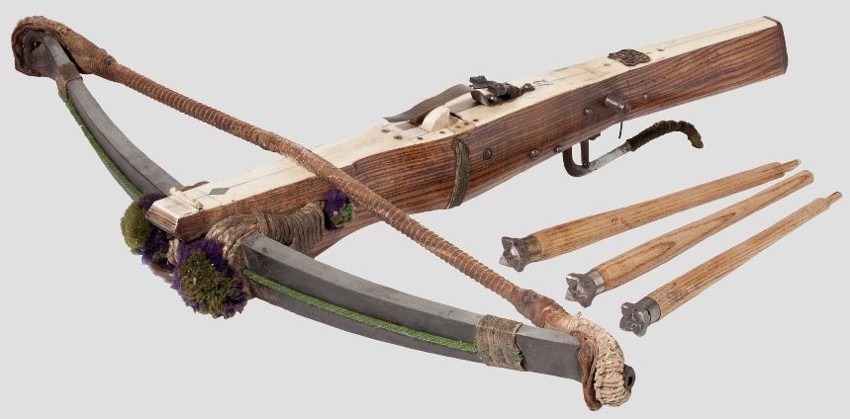
Источник:
Одно из самых ранних упоминаний подобного арбалету механизма, баллисты, можно найти в Библии. Однако использовали арбалеты еще ранее – в Восточной Азии. Древнейший экземпляр относится примерно к пятому веку до нашей эры. Его производили в Китае довольно большими партиями – для собственных войск, а также для иностранных наемников.
Столь популярным арбалет был благодаря его стоимости, а также скорости обучения солдат использованию этого оружия. Например, значительно позже, в Англии к подготовке лучников приступали с раннего детства: дабы натренировать меткость и мышцы спины. Здесь даже любили поговаривать: «хочешь выучить лучника – начинай с его дедушки». Конечно, это совсем другая эпоха. Однако сравнение лука с арбалетом достаточно показательно.
Ведь арбалетчик может выучиться в реально короткие сроки. Ему не нужно тренировать очень уж крепкие мышцы: ведь рычаги со стременем. Любопытно также, что арбалеты почти неизменно отдавали в некий вид аренды на срок службы знати. Арендная плата при этом была относительно невысока. Нанимать и мобилизовывать подобные войска можно было просто и быстро.
Плюсы и минусы арбалета
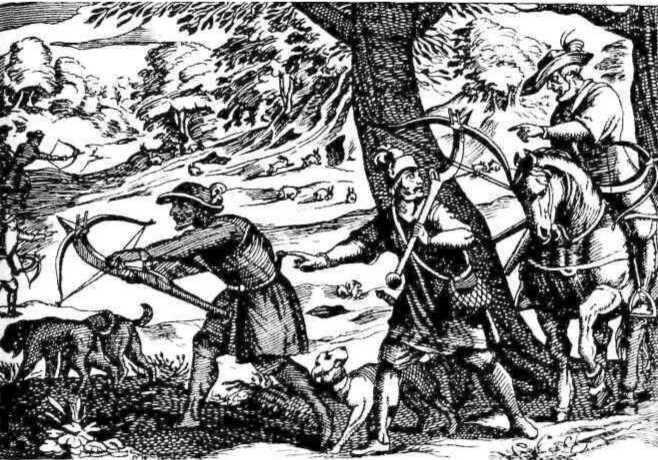
Источник:
Естественно, у этого оружия, как и у всякого иного, есть весомые недостатки. Во-первых, речь идет о времени, для натяжения тетивы или коровьей, бычьей кожи в случае тысячефунтовой модели. Велики цены как на арбалет, так и на инструмент, натягивающий тетиву.
В плохую погоду мощность теряется достаточно быстро, поскольку тетива, как и кожа, растягивается. Арбалетчики были вынуждены таскать сразу несколько тетив под шапелью для обеспечения натяжения. А ведь и сам арбалет достаточно тяжел.
Арбалетный болт быстро теряет ударную силу на дистанции, поскольку масса его мала. Стрелок уязвим для ответного огня, поскольку для того, чтобы натянуть стрелу, нужно много времени – безо всякого естественного укрытия.
Однако есть у данного оружия и плюсы. На малых дистанциях его пробивная способность велика. Чтобы убить противника, не требуется пробивать латы. Да это и нереально, в случае если качество лат среднее или выше среднего. Даже ежели сила натяжения превышает тысячу фунтов.
Стрелять можно из любого положения, а не только сидя. На учебу, как уже говорилось, не требуется много времени. Пользоваться же этим оружием может человек любого телосложения. Ведь существуют рычаги, а также иные механизмы, натягивающие тетиву. На коротких расстояниях болт летит на приличной скорости.
Популярнейшие мифы
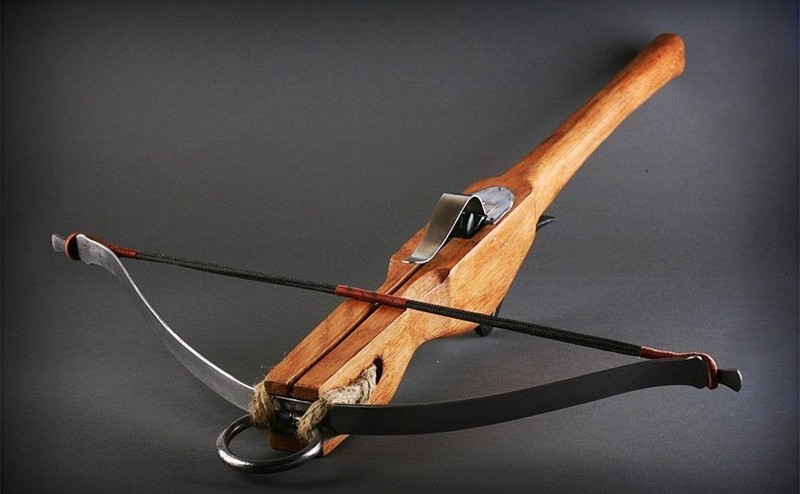
Источник:
Знать терпеть не могла арбалеты – а заодно и их хозяев
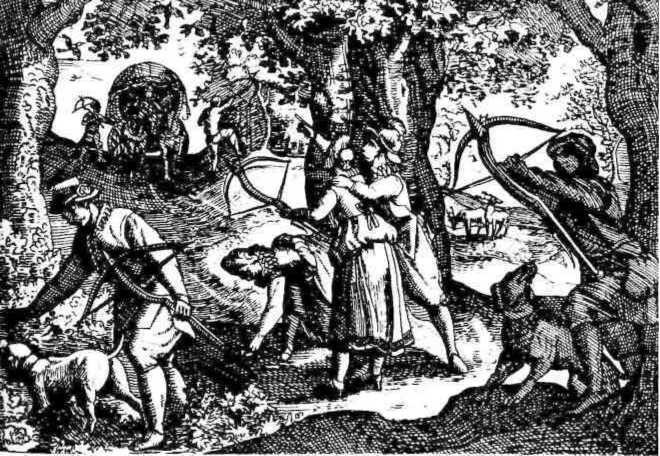
Источник:
Возможно – но до тех пор, пока сама не испытывала их друг против друга, причем довольно эффективно. Со временем даже оплата за их службу превысила расценки лучников. Известны случаи, когда только за участие в турнире платили очень даже неплохо: 157 фунтов при ежедневной оплате по восемь пенсов на человека.
В средние века католическая церковь воспрещала использовать арбалеты во внутрихристианских войнах
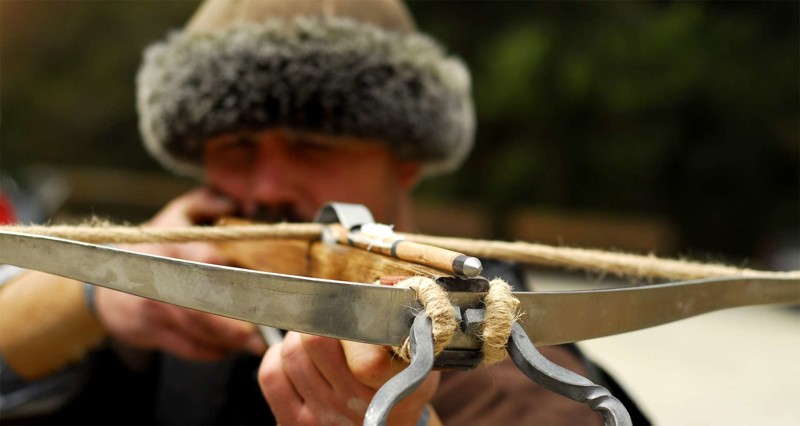
Источник:
Это – правда лишь отчасти. Сейчас по идее запрещены и луки, у которых сила натяжения составляет сотню фунтов. Решение это принял Папа Иннокентий II еще в 1139 году. На него давила знать, поскольку это устройство было опасно для рыцарей, которых кольчуга уже не могла спасти от болтов. Как поговаривают, арбалеты были запрещены, поскольку рядовой пейзанин, практиковавший стрельбу в течение одного дня, мог покалечить и смертельно ранить рыцаря. А ведь последний обучался калечить и ранить всю свою жизнь.
Речь идет о первой половине двенадцатого столетия, когда новая разработка по названием «бригандина» еще только создавалась. Так что арбалет еще наводил на рыцарей настоящий ужас. Не забывайте и о людях, подчиненных вассалам и рыцарям. В течение всех средних веков войны выигрывались преимущественно пейзанами, которых поддерживали конные войска. Естественно, деньгами на дорогие в те времена кольчугу с латами эти бедолаги не располагали. Как итог – значительная смертность от этого жуткого орудия, что не могло не раздражать рыцарей.
В итоге слуги божьи плевали на собственные же былые возмущения, используя это же оружие против как неверных, так и иных подчиненных врагов того или иного землевладельца. Особенно же плевала на мнения церкви знать. Она нанимала арбалетчиков, дабы творить с собственными противниками на поле боя невероятные вещи.
В средневековье арбалет являлся передовым оружием
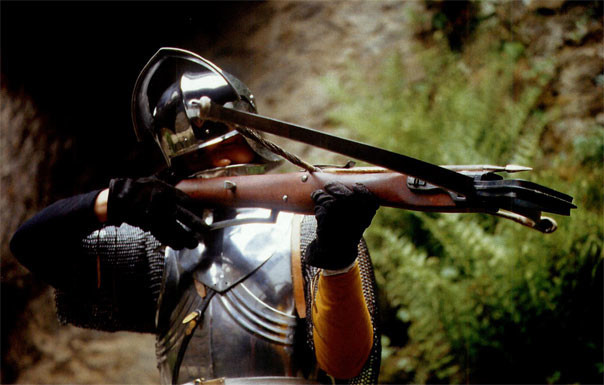
Источник:
Это утверждение скорее применимо к Китаю пятого века еще до нашей эры. Но, невзирая на то, что арбалет перестал быть передовым к началу средневековья, он в это время был еще достаточно эффективным. Впоследствии на полях сражений он себя изжил, а использовался уже преимущественно во время осад. В сражении при Креси он неважно себя показал, особенно относительно английского тру лонгбоу.
Последний стабильно уничтожал как наемников, так и знать: со скоростью до десятка ударов за минуту. Близкой скорости стрельбы в семь – восемь ударов в минуту арбалетчики могли достигать, лишь наняв парочку слуг. Один из них натягивал тетиву, второй же тем временем перемещал павезу.
Арбалет стал толчком к закату рыцарства
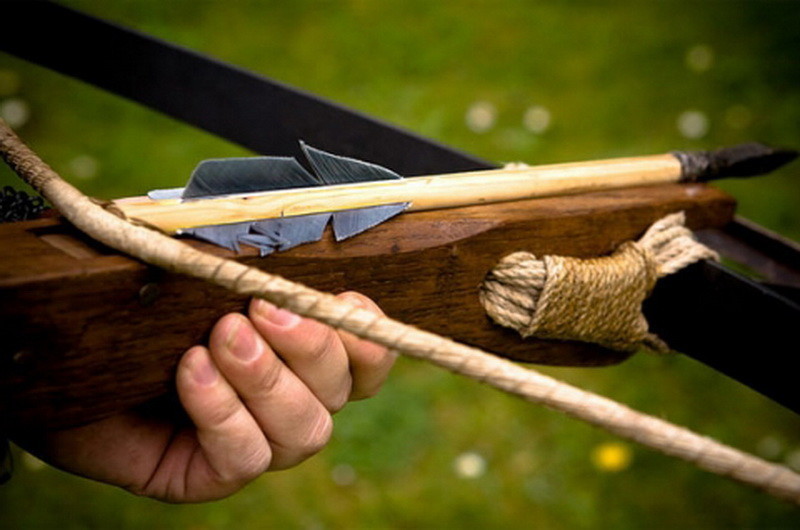
Источник:
Есть множество аргументов против этой теории, перечислять которые слишком долго. Мы выскажемся по сути. Рыцарство пропало по причинам:
• слишком дорогого содержания;
• появления огнестрелов;
• смены тактики со стратегией ведения боев в связи с теми же огнестрелами: ведь броня от них не спасала.
Броня рыцарей пробивалась тяжелыми арбалетами
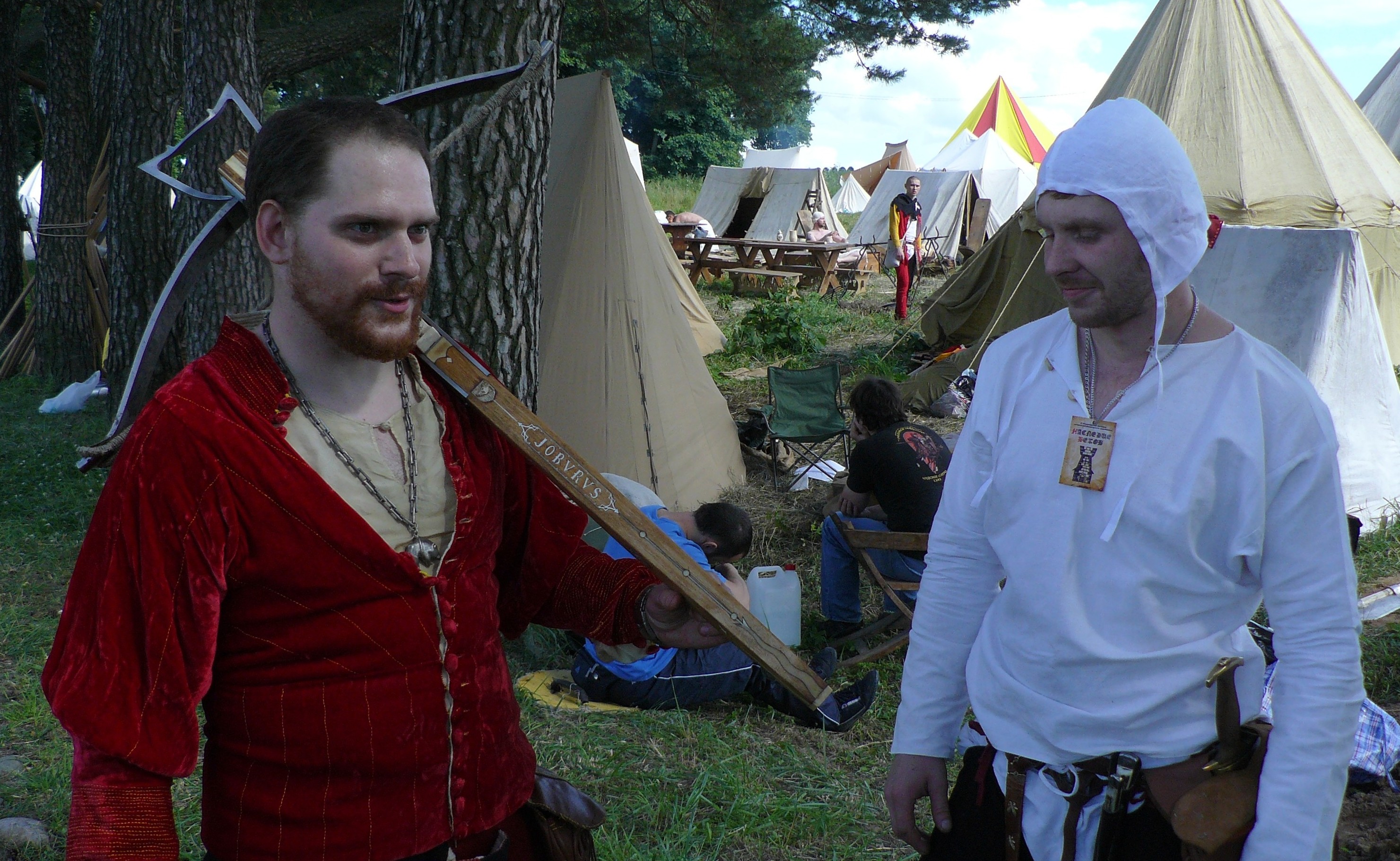
Источник:
Это совсем не так. Есть правда одно видео в поддержку этой версии про сан-маринских арбалетчиков. Однако даже если изменить форму наконечника и обзавестись болтом увесистой формы, пробитие лат составит полтора – два сантиметра. Это совершенно не страшно человеку в этих латах, ведь промежуток между визором или нагрудником и телом достаточно велик. Кроме того, именно данный тип арбалетов в латах не тестировался.
Есть тесты с более популярными моделями арбалетов и латами, поверхностно закаленными. На одном из них сила натяжения тетивы (заявленная) составила тысячу фунтов, реальная же равнялась 900 фунтам. Погодные же условия и вовсе снизили ее до 750 фунтов. Не менее важно при этом, каким именно был наконечник. Использованный в тесте тупоголовый вариант мог бы и убить благодаря мощи удара.
Например, специалисты ставили эксперименты, показавшие, что 140-фунтовый лонгбоу по силе удара сопоставим с выстрелом магнума. Только подумайте, какова сила удара от болта девятисот фунтового арбалета по ногам, латам или шлему. Такой монстр запросто мог пробить щиты, а вслед за ними – тела или лица людей на средних и близких расстояниях.
Стоит в финале поговорить немного о повседневной работе упоминавшихся уже арбалетчиков. Не существовало формальных формирований стрелков. Отряды набирали из простых солдат, если были собственно механизмы и подходящие болты. Что характерно, по мере необходимости, арбалетчики переквалифицировались в лучников и наоборот. В первой половине пятнадцатого века они получали по восемь пенсов ежедневно. Ставка конных лучников достигала шести пенсов, кавалеристов – пятнадцати пенсов.
Источник:
Еще крутые истории!
Про арбалет создано множество дискуссий, статей, книг и исследований – исторических и не очень. С этим оружием связано огромное число легенд, правдивых и выдуманных.
Мы попытаемся внести немного ясности во всю эту неразбериху, вычленить из массы данных истину. Если у кого-то есть более достоверная информация, делитесь.
Происхождение
Одно из самых ранних упоминаний подобного арбалету механизма, баллисты, можно найти в Библии. Однако использовали арбалеты еще ранее – в Восточной Азии. Древнейший экземпляр относится примерно к пятому веку до нашей эры. Его производили в Китае довольно большими партиями – для собственных войск, а также для иностранных наемников.
Столь популярным арбалет был благодаря его стоимости, а также скорости обучения солдат использованию этого оружия. Например, значительно позже, в Англии к подготовке лучников приступали с раннего детства: дабы натренировать меткость и мышцы спины. Здесь даже любили поговаривать: «хочешь выучить лучника – начинай с его дедушки». Конечно, это совсем другая эпоха. Однако сравнение лука с арбалетом достаточно показательно.
Ведь арбалетчик может выучиться в реально короткие сроки. Ему не нужно тренировать очень уж крепкие мышцы: ведь рычаги со стременем. Любопытно также, что арбалеты почти неизменно отдавали в некий вид аренды на срок службы знати. Арендная плата при этом была относительно невысока. Нанимать и мобилизовывать подобные войска можно было просто и быстро.
Плюсы и минусы арбалета
Естественно, у этого оружия, как и у всякого иного, есть весомые недостатки. Во-первых, речь идет о времени, для натяжения тетивы или коровьей, бычьей кожи в случае тысячефунтовой модели. Велики цены как на арбалет, так и на инструмент, натягивающий тетиву.
В плохую погоду мощность теряется достаточно быстро, поскольку тетива, как и кожа, растягивается. Арбалетчики были вынуждены таскать сразу несколько тетив под шапелью для обеспечения натяжения. А ведь и сам арбалет достаточно тяжел.
Арбалетный болт быстро теряет ударную силу на дистанции, поскольку масса его мала. Стрелок уязвим для ответного огня, поскольку для того, чтобы натянуть стрелу, нужно много времени – безо всякого естественного укрытия.
Однако есть у данного оружия и плюсы. На малых дистанциях его пробивная способность велика. Чтобы убить противника, не требуется пробивать латы. Да это и нереально, в случае если качество лат среднее или выше среднего. Даже ежели сила натяжения превышает тысячу фунтов.
Стрелять можно из любого положения, а не только сидя. На учебу, как уже говорилось, не требуется много времени. Пользоваться же этим оружием может человек любого телосложения. Ведь существуют рычаги, а также иные механизмы, натягивающие тетиву. На коротких расстояниях болт летит на приличной скорости.
Популярнейшие мифы
Знать терпеть не могла арбалеты – а заодно и их хозяев
Возможно – но до тех пор, пока сама не испытывала их друг против друга, причем довольно эффективно. Со временем даже оплата за их службу превысила расценки лучников. Известны случаи, когда только за участие в турнире платили очень даже неплохо: 157 фунтов при ежедневной оплате по восемь пенсов на человека.
В средние века католическая церковь воспрещала использовать арбалеты во внутрихристианских войнах
Это – правда лишь отчасти. Сейчас по идее запрещены и луки, у которых сила натяжения составляет сотню фунтов. Решение это принял Папа Иннокентий II еще в 1139 году. На него давила знать, поскольку это устройство было опасно для рыцарей, которых кольчуга уже не могла спасти от болтов. Как поговаривают, арбалеты были запрещены, поскольку рядовой пейзанин, практиковавший стрельбу в течение одного дня, мог покалечить и смертельно ранить рыцаря. А ведь последний обучался калечить и ранить всю свою жизнь.
Речь идет о первой половине двенадцатого столетия, когда новая разработка по названием «бригандина» еще только создавалась. Так что арбалет еще наводил на рыцарей настоящий ужас. Не забывайте и о людях, подчиненных вассалам и рыцарям. В течение всех средних веков войны выигрывались преимущественно пейзанами, которых поддерживали конные войска. Естественно, деньгами на дорогие в те времена кольчугу с латами эти бедолаги не располагали. Как итог – значительная смертность от этого жуткого орудия, что не могло не раздражать рыцарей.
В итоге слуги божьи плевали на собственные же былые возмущения, используя это же оружие против как неверных, так и иных подчиненных врагов того или иного землевладельца. Особенно же плевала на мнения церкви знать. Она нанимала арбалетчиков, дабы творить с собственными противниками на поле боя невероятные вещи.
В средневековье арбалет являлся передовым оружием
Это утверждение скорее применимо к Китаю пятого века еще до нашей эры. Но, невзирая на то, что арбалет перестал быть передовым к началу средневековья, он в это время был еще достаточно эффективным. Впоследствии на полях сражений он себя изжил, а использовался уже преимущественно во время осад. В сражении при Креси он неважно себя показал, особенно относительно английского тру лонгбоу.
Последний стабильно уничтожал как наемников, так и знать: со скоростью до десятка ударов за минуту. Близкой скорости стрельбы в семь – восемь ударов в минуту арбалетчики могли достигать, лишь наняв парочку слуг. Один из них натягивал тетиву, второй же тем временем перемещал павезу.
Арбалет стал толчком к закату рыцарства
Есть множество аргументов против этой теории, перечислять которые слишком долго. Мы выскажемся по сути.
Рыцарство пропало по причинам:
- слишком дорогого содержания;
- появления огнестрелов;
- смены тактики со стратегией ведения боев в связи с теми же огнестрелами: ведь броня от них не спасала.
Броня рыцарей пробивалась тяжелыми арбалетами
Это совсем не так. Есть правда одно видео в поддержку этой версии про сан-маринских арбалетчиков. Однако даже если изменить форму наконечника и обзавестись болтом увесистой формы, пробитие лат составит полтора – два сантиметра. Это совершенно не страшно человеку в этих латах, ведь промежуток между визором или нагрудником и телом достаточно велик. Кроме того, именно данный тип арбалетов в латах не тестировался.
Есть тесты с более популярными моделями арбалетов и латами, поверхностно закаленными. На одном из них сила натяжения тетивы (заявленная) составила тысячу фунтов, реальная же равнялась 900 фунтам. Погодные же условия и вовсе снизили ее до 750 фунтов. Не менее важно при этом, каким именно был наконечник. Использованный в тесте тупоголовый вариант мог бы и убить благодаря мощи удара.
Например, специалисты ставили эксперименты, показавшие, что 140-фунтовый лонгбоу по силе удара сопоставим с выстрелом магнума. Только подумайте, какова сила удара от болта девятисот фунтового арбалета по ногам, латам или шлему. Такой монстр запросто мог пробить щиты, а вслед за ними – тела или лица людей на средних и близких расстояниях.
Стоит в финале поговорить немного о повседневной работе упоминавшихся уже арбалетчиков. Не существовало формальных формирований стрелков. Отряды набирали из простых солдат, если были собственно механизмы и подходящие болты. Что характерно, по мере необходимости, арбалетчики переквалифицировались в лучников и наоборот. В первой половине пятнадцатого века они получали по восемь пенсов ежедневно. Ставка конных лучников достигала шести пенсов, кавалеристов – пятнадцати пенсов.
Источник
Жан Фруассар (1337–1410). Арбалетчики в битве при Креси. Национальная библиотека Франции
Во всех искусствах был Бахрам умелым.
Он поскакал с колчаном, самострелом.
Помчался всадник за другой четой,
А в самостреле – камешек простой.
«Шах-наме» Хаким Абулькасим Фирдоуси. Перевод С. И. Липкина
История огнестрельного оружия. Мы часто думаем, что развитие любого явления происходит последовательно. И что то же самое имело место и в отношении истории огнестрельного оружия. Что сначала был лук, потом его сменил арбалет, затем ему на замену пришло огнестрельное оружие. Однако именно в данном случае было это совсем не так.
И арбалет, и огнестрельное оружие с искровым воспламенением достигли своего идеала практически одновременно. Другое дело, что развитие арбалета по ряду причин замедлилось, а вот огнестрельное оружие изменялось по нарастающей.
Тем не менее, в 1550 году и арбалеты, и всаднические колесцовые пистолеты по своему совершенству, сложности и боевым характеристикам были примерно равны. Да и в дальнейшем арбалеты еще долгое время продолжали использовать на охоте. И вот о том, как такое случилось, а также о самых последних и совершенных арбалетах, существовавших параллельно с фитильными и колесцовыми системами стрелкового оружия, мы вам сегодня и расскажем.
Китайский многозарядный арбалет эпохи династии Мин. Иллюстрация из китайской энциклопедии, ок. 1700–1725 гг.
История арбалета
Начнем с седой древности.
В 500 году до н. э. китаец Сунь-цзы в своем труде «Военное искусство» упоминает о мощных арбалетах, представляющих собой станковые луки.
С 400 года до н. э. греки используют арбалет – гастрафет.
Гастрафет Герона Александрийского. Рисунок из манускрипта кодекса «Фарисин» с дополнениями на греческом. Национальная библиотека Франции
В период с 206 года до н. э. по 220 год н. э. арбалет становится обычным оружием воинов и охотников династии Хань.
Около 100 года н. э. в Китае уже используются многозарядные арбалеты. Римляне (в эпоху империи), а затем и византийцы, знали арбалет под именем соленарион, однако широко он ими не использовался. Даже пикты и те его знали и применяли.
А в 1100 году он уже широко известен в Европе. В 1139 году Папа Римский Иннокентий II запрещает использование арбалета против христиан.
Самое раннее изображение всадника с арбалетом из Каталонского манускрипта 1086 года. На миниатюре четыре всадника Апокалипсиса. Архив собора в городе Бурго-де-Осма-Сьюдад-де-Осма, Испания
В 1199 году Ричард Львиное Сердце, ярый поборник арбалетов, смертельно ранен именно из арбалета при осаде замка Шалю в Аквитании.
В конце XIII века длинный лук вытесняет арбалет в Англии, но в континентальной Европе арбалет популярен по-прежнему.
В начале XIV века появляются уже арбалеты с луками из стали.
Арбалетчики XI–XIII вв. В самых первых европейских арбалетах тетива натягивалась руками. Но уже англо-нормадские арбалетчики XII века использовали для этого простейший блок (5). Использовались для натяжения и поясные крюки (3, 4). С их помощью, вставив ногу в стремя, арбалетчик натягивал тетиву ногой (6, 7). Снаряжение арбалетчика XIV века (8) было довольно громоздким, так как обязательно включало в себя щит-павезу. Стрелы использовались как оперенные (10), так и неоперенные (9), и даже зажигательные (7). В целом арбалет долгое время был очень простым устройством (1). Иллюстрация из книги Лилианы и Фреда Функенов «Энциклопедия вооружения и военного костюма. Средние века. VIII–XV века: Доспехи и вооружение. Крепости и осадные машины. Рыцарские турниры и гербы. М.: Астрель, 2002, С. 125
Охотничий арбалет с четырехколесной тросовой лебедкой, обеспечивающей возможность очень сильного натяжения арбалетного лука. Изготовлен между 1499 и 1514 гг. Такие арбалеты получили распространение в годы Столетней войны. Ну, а впоследствии использовались в качестве охотничьего оружия. Художественно-исторический музей Вены, Новый Замок, Придворная охотничья и оружейная палата
Удивительно, но такие арбалеты были в ходу в Англии очень долго. Вот перед нами арбалет с лебедкой 1700–1799 гг. Королевский Арсенал, Лидс
А вот так устроена сама лебедка. Изготовлена в 1631–1670 гг. Королевский Арсенал, Лидс
В XIV–XV вв. арбалет становится стандартным оружием французских и фламандских граждан, обороняющих свои города. В 1521–1524 гг. арбалетчики активно участвуют в походах конкистадоров Кортеса и Писарро в Новом Свете.
Арбалет графа Ульриха V Вюртембергского (1413–1480), датируемый 1460 годом. Приписывается Генриху Хейду фон Винтертуру, вероятно, швейцарцу. Это самый ранний из известных датированных арбалетов из существующих. На нем изображены гербы Вюртемберга и Савойи, которые относятся к его владельцу, графу Ульриху V из Вюртемберга (1413–1480) и его третьей жене, принцессе Маргарите Савойской (1420–1479). Над спусковым крючком находится немецкое благословение, написанное еврейскими буквами. Это редкий и ранний экземпляр древнееврейского письма на личном предмете, предназначенном для христианского государя. Его можно перевести как «Береги Бога и будь великодушным!» или «Боже мой, добрый!» Материал: дерево (европейский граб), рог, сухожилия животных, олений рог, береста, железный сплав, медный сплав. Размеры: длина 71,2 см). Вес 2 972 г, Метрополитен-музей, Нью-Йорк
Крепление лука на этом арбалете. Метрополитен-музей, Нью-Йорк
«Орех» –главная деталь спускового механизма арбалета, до 1272 г. Вес 8 г, Метрополитен-музей, Нью-Йорк
Традиционно лук арбалета делали из дерева. Но известны луки из рогов горного барана. А уже в XVI веке появились арбалеты с луками из стали, обладающие повышенной мощностью.
Возвращение Карла VI после битвы при Роозенбеке (1382). Миниатюра из «Хроник» Фруассара, XV в. На переднем плане арбалетчик с «английским воротом» на поясе. Национальная библиотека Франции
В XVI веке огнестрельное оружие начинает постепенно вытеснять арбалеты из военных арсеналов в Европе, где они используются главным образом на охоте (преимущественно на птицу) и для стрельбы по мишеням.
Универсальный арбалет-баллестер для пуль и стрел в сочетании с фитильным ружьем. Изготовлен ок. 1570–1600 гг. Инкрустация из полированного и выгравированного оленьего рога с изображением трофеев оружия основана на эскизах Якоба Флориса (1524–1581), которые были опубликованы в Антверпене в 1564 году. Лук был позднее заменен на новый. Метрополитен-музей, Нью-Йорк
А вот таким образом на нем происходило взведение тетивы. Все позднейшие системы с управлением затвором при помощи рычага под цевьем вполне могли иметь в своей основе именно эту конструкцию. Метрополитен-музей, Нью-Йорк
В то же время появились даже гибридные виды оружия, то есть арбалет, объединенный с фитильным или колесцовым мушкетом. Понятно, что такое оружие заказывалось мастерам исключительно для потехи знати. И особого значения такие системы не имели. Но они развивали мастерство их изготовителей.
1894–1895 гг. Китайцы применяют многозарядные арбалеты в войне с Японией.
1914–1918 гг. Самодельные арбалеты-гранатометы используются в окопах Первой мировой войны.
Принцип
Интересно, что сам принцип наложения лука на ложу все это время оставался практически неизменным, зато изменениям подвергался механизм натяжения тетивы, что явным образом было связано с увеличением мощности лука.
Так, тот же гастрафет древних греков взводился за счет того, что стрелок упирал его во что-нибудь твердое и наваливался на его упор животом (отсюда, кстати, и его название).
Римляне тоже знали арбалет, называли его соленарион. Однако тетиву лука в нем натягивали руками. Поэтому мощность его была невелика. И использовался он потому в основном на охоте. Кстати, в поэме Фирдоуси «Шах-наме» арбалет упоминается как оружие именно для охоты.
Сначала арбалеты натягивались поясными крюками, лебедкой с системой полиспастов. А в XV веке появилась еще и так называемая «козья нога» – рычаг, закреплявшийся на ложе арбалета и оттягивающий тетиву назад. Арбалеты такой системы были более скорострельными, чем те, что натягивались с помощью лебедки. Но зато они были слабее.
«Козья нога» конца XV – начала XVI века. Длина 49,8 см. Вес 713 г. Метрополитен-музей, Нью-Йорк
В XVI веке распространились арбалеты-баллестеры, стрелявшие свинцовыми (а также глиняными) шаровыми пулями. На тетиве для такой пули укреплялась чашечка, а вместо ореха их спусковой механизм снабжали вертикальным опускающимся стержнем, входившим в петлю на чашечке.
Арбалет-баллестер, датируемый 1573 годом. Работа северо-итальянская или французская, вероятно, савойская. Материал: сталь, дерево (вишня, красное дерево), олений рог, слоновая кость. Длина 95,9 см. Вес 1 977 г. Метрополитен-музей, Нью-Йорк
Баллестер, Англия (1700–1740). Королевский Арсенал, Лидс
Охотничий баллестер 1580 г. Также с рычажным механизмом под ложей. Таким арбалетам не требовалась ни «козья нога», ни лебедка. Метрополитен-музей, Нью-Йорк
Но вот около 1450 года появился так называемый «нюрнбергский вороток», кранекин или «вертушка», представлявшее съемное устройство для натяжения тетивы лука арбалета любой силы. И это сразу же подтолкнуло создателей арбалетов на разработку не только больших и мощных арбалетов – мощных за счет размеров лука, но и небольших, но с луком из стали.
Появились совсем небольшие арбалеты (их так и называли кранекин) специально для всадников, заряжать которые они могли, уже не слезая с седла. И сразу же на поле боя появились отряды конных арбалетчиков, чего не была раньше, стрелявших по всадникам и пехоте противника издали. Появилась даже должность «великого мастера арбалетчиков», вторая по значимости во Франции после великого коннетабля.
«Нюрнбергский вороток», изготовлен в период между 1508 и 1519 годами. Принадлежал императору Максимилиану I. Художественно-исторический музей Вены, Новый Замок, Придворная охотничья и оружейная палата
Большой кранекин. Ок. 1575–1650 гг. Предположительно саксонский. Материал: сталь, дерево (вероятно, слива), медный сплав, золото, конопля, текстиль (вероятно, лен). Длина 47,1 cм. Вес 5,838 г. То есть весил этот вспомогательный механизм больше, чем современная винтовка с патронами. А ведь кроме кранекина арбалетчику нужен был еще и сам арбалет, а затем колчан со стрелами. Метрополитен-музей, Нью-Йорк
Так что в 1550 году и арбалет, и всаднические колесцовые пистолеты и по сложности, и по своим боевым качествам были примерно на одном уровне.
Огнестрел арбалеты вытеснил
И, тем не менее, огнестрел арбалеты вытеснил.
Карл IX, король Франции в 1560–1574 гг. полностью исключил арбалет из военного снаряжения, заявив, что он, как оружие, стал бесполезен. И предложил всем лучникам и арбалетчикам вооружиться аркебузами.
Лук дожил в английской армии до 1595 года. И тоже был отменен.
Ну, а причина, думается, ясна. Уход за арбалетом был сложнее, чем за пистолетом или мушкетом. А стрелы занимали больше места в снаряжении, чем порох и пули. Его было сложнее привести в действие, для этого как бы там ни было, требовалась физическая сила. Тогда как аркебуз достаточно было всего лишь поднять, прицелиться и нажать на спусковой крючок. Кроме того, тот же «нюрнбергский вороток» был достаточно тяжелым и металлоемким изделием.
И это опять же именно арбалет подсказал оружейникам идею нарезного оружия, потому что многие арбалеты уже тогда стреляли вращающимися в полете стрелами. И это их вращение значительным образом повышало точность попадания в цель.
Зато охотничьи арбалеты производились и использовались еще очень долго. И стали они настоящими произведениями оружейного искусства.
Арбалет мастера Иоганна Готфрида Хениша Старшего, датируемый 1742 годом. Это один из серии арбалетов, созданных Хенишем Старшим для двора Фридриха Августа II, курфюрста Саксонии с 1733 по 1763 год и короля Польши Августа III с 1734 по 1736 год. Длина 73,2 см; ширина 63,3 см; 4817 г.; кранекин (без кривошипа) 36,2 см; длина кривошипа 27,3 см. Метрополитен-музей, Нью-Йорк
Приклад этого арбалета с охотничьей сценой, гравированной на кости. Метрополитен-музей, Нью-Йорк
Ну и, конечно, как уже отмечалось выше, для арбалетов требовались стрелы. А они в изготовлении были намного сложнее простых свинцовых пуль.
Помимо древков одинаковой толщины и веса требовалось отковать стальные наконечники, «квадратики», как их называли стрелки. Хотя наконечники в ходу были самые разные, в том числе и в форме обратного полумесяца. Все это удорожало использование арбалетов по сравнению с огнестрельным оружием, не давая при этом особых выгод.
И арбалеты, и мушкеты давали в 1550 году примерно по 1–2 выстрела в минуту.
Наконечники стрел к арбалету. Метрополитен-музей, Нью-Йорк
Продолжение следует…
Продолжу-ка я лучно-арбалетную тему. Вообще, я давно хочу написать статью по авиационным двигателям, но после того, как мне приходит осознание объема материала, который надо осветить, мне тут же становится плохо. Даже руки опускаются. Поэтому подарок жены – арбалет-пистолет, мне пришелся очень кстати – он позволил мне сменить тему. И я тут же бросился изучать все, что смог найти по новому для меня объекту изучения. Вот такой я странный человек. Для меня теория и идея важнее практики. (Социотип ЛИИ, аналитик, ага).
Но форсировал я «процесс» после того как из подаренного мне почти игрушечного арбалетика пострелял. И вдруг, неожиданно, ВНЕЗАПНО (как пишут начинающие писатели), выяснилось, что игрушка – самое настоящее оружие. Опасное и, в некоторых случаях, смертельное. Нет, конечно, в людей я не стрелял, только в неживые предметы, но, признаюсь, меня и это впечатлило.
Первой моей жертвой пал черствый батон недельной давности. Стрела (шестидюймовый дротик) вошла в него почти по самое оперение (на самом деле она пробила его насквозь и тормознулась деревянным щитом). С пяти метров. Тогда я выстрелил в консервную банку и конкретно загрустил. Потому что лишился дротика. Он пробил донышко банки и застрял оперением. Пока я вытаскивал дротик, оперение я малость ободрал. Толстую боковую стенку он тоже пробил, оперение снова застряло, а металлический наконечник сорвало, и он улетел в неизвестном направлении. Есть подозрение, что наконечник закатился под диван и когда-нибудь я его отыщу на этом складе забытых вещей. Но это будет потом.
После тестовых стрельб мне стало худо, и я в полной прострации повалился на кровать. Потому что пластмассовая, сделанная на Тайвани фитюлинка весом в 600 грамм уделала в хлам мою любимую пневматическую винтовку МП-512 массой почти четыре кило! И это – с пулевидным, почти спортивным наконечником. (Сравните со средневековыми бодкином – бронебойным «шилом» или хотя бы острым «ланцетом»).
Отлежавшись и поскрежетав зубами я, как доктор Ватсон, бросился штудировать фармакологию. В смысле, теорию. (Кстати, в сериале Ватсон, заявив о том, что идет просвещаться, так никуда и не пошел. Наверное, подумал, нафиг надо голову забивать?)
Для начала я обратился к теории и обнаружил, что важнейший параметр луков и арбалетов – натяжение тетивы. В конкретно моем мини-арбалете оно составляет 36 килограмм. Максимально разрешенное в России натяжение тетивы для безлицензионных изделий – 43 кг. (Говоря человеческим языком, такие арбалеты можно приобретать и использовать для отстрела банок и бутылок свободно, иногда даже и паспорт не потребуют). А вот на дуги (вернее, плечи) с большим натяжением требуется спортивная или охотничья лицензия. Напомню, что недавно в РФ разрешили охоту с луком (не зеленым) и арбалетом.
Потом я воззвал к историческому опыту. В интернете я нашел, что у средневековых арбалетов натяжение тетивы измерялось сотнями килограмм. Зверские штуковины! Но на поверхность всплыли интересные нюансы.
Конечно, реально носимые арбалеты имели усилие натяжения до 80 кг (а вы пробовали руками натянуть арбалет хотя бы 43 кг?), но посмотрим предельную, экстремальную мощность. У тех арбалетов, которые хоть как-то можно носить с собой, усилие натяжения будем считать до 200 кг (попробуй, натяни без ворота). У осадных же, в башнях… в общем, один крендель в начале XX века раздобыл такой осадный арбалет, его натяжение составляло 544 кг при массе оружия почти 10 кг. У стационарных стрелометов натяжение было под тонну. У охотничьих же плеч современного арбалета «Скорпион» натяжение составляет 79 кг, у «Мангуста» — одной из самых мощных рекурсивных (об этом позже) моделей, 102 кг. Кажется, что нынешние арбалеты по сравнению со средневековыми – жалкие игрушки.
Авотх…! (Извините за грубость и прямоту). Но чтобы понять всю безблагодатность средневековой техники, придется снова обратиться к скучной и любимой мной теории.
Не требует доказательств тот факт, что стрела летит под действием энергии, переданной ей тетивой, а энергия эта запасается в упругих плечах арбалета. Так вот: эта самая запасенная энергия зависит не только от натяжения тетивы, но и от рабочего хода этой самой тетивы. Формула простая: энергия арбалета в джоулях равна половине произведения усилия натяжения тетивы в ньютонах на длину хода тетивы в метрах. К примеру (скучные цифры детектед!), у моего арбалета-пистолета натяжение 36 кг (360 ньютон) и длина хода тетивы 15,2 сантиметра. Энергия, запасаемая его плечами получается ½*360*0.152=27,36 Дж. КПД арбалетов от 30 до 85 процентов (в зависимости от типа стрел), примем для ровного счета 50%. Энергия вылетевшей стрелы получается 13 джоулей. Для справки: разрешенная мощность безлицензионных пневматических винтовок (весом 3-4 килограмма, надо сказать) – 7.5 джоулей. И винтовка считается гражданским оружием! (Не считаются оружием пистолеты с энергией до 3 джоулей). Арбалет же – «конструктивно сходное изделие», по сути считается игрушкой, предметом для развлечения и он вдвое мощнее разрешенной законом винтовки!
В криминалистике считается, что минимальный порог для нанесения смертельных ранений человеку острым предметом – 15 джоулей. То есть, из маленького, компактного арбалетика-игрушки при определенных обстоятельствах можно запросто отправить человека на тот свет. Но, конечно, убить можно даже пневматическим пистолетом МП-654К. Все зависит от того, с какой силой его швырнуть. В общем, парадокс законов налицо. Ну и хорошо. Нам это на руку. Будем пользоваться.
Теперь возьмем средневековых монстров. Никогда не обращали внимания на их конструкцию?
Ничего странного не заметили? Они короткие! У них при очень большом размахе плеч маленький ход тетивы! Ну не было в те времена материалов, чтобы создать плечи нужной упругости. Качество приходилось компенсировать количеством – чудовищным натяжением. А если кто найдет средневековый арбалет с фиберглассовой дугой – ну, это переворот всей мировой истории.
Справедливости ради: в Китае широко применяли арбалеты с композитной дугой (составной лук) и большим ходом тетивы. Но натяжение тетивы у этих арбалетов было не очень большое и высокой мощностью они не отличались. Зато взводились легко. Некоторые одним движением рычага.
Так какой же ход тетивы у средневековых арбалетов? У довольно крупного «аппарата» с усилием 150 кг – 15 сантиметров. Примерно, как у моего пистолетного «компакта». У осадного арбалета с усилием натяжения 544 кг – 17.5 сантиметров. У стационарных крепостных «орудий» с усилием натяжения 800 килограмм – до 27 сантиметров. Но эти старинные «пушки» мы будем рассматривать только… только… да как хочу, так и буду рассматривать! Мое дело, как!
Давайте посчитаем, состоятельные кроты, энергию вылета стрелы из средневекового арбалета с натяжением 150 кг. ½*1500Н*0.15М=112.5 Дж. При КПД 50% получаем энергию стрелы 56.25Дж.
Здесь надо сделать маленькое отступление: в средневековье использовали тяжелые болты массой 80-85 грамм при длине 12-14 дюймов (30-36 сантиметров). Современные арбалеты используют легкие стрелы массой 25-70 грамм и длиной 16-22 дюйма (40-55 сантиметров). У современных стрел высокая скорость и более настильная траектория, что позволяет прицельно стрелять. Но меньшая дальность.
Посмотрим осадного монстра. ½*5440Н*0.175=476 Дж. Из них стреле передается 238 Дж. Носить такой «прибор» с собой затруднительно, зато болт массой 85 грамм, выпущенный из такого агрегата под углом 45 градусов, улетит на 430 метров. А нафига это надо, спрашивает читатель Лев Эрнестович Куяльник? Надо. Когда стреляешь в толпу супостатов, готовых насадить тебя на гизарму, в кого-то да прилетит. Все легче отбиваться. В современных же условиях, когда во главу угла ставится точность, такая дальнобойность, конечно, ни к чему.
Давайте рассмотрим современные арбалеты. У арбалета среднего класса «Скорпион» ход тетивы составляет 25 сантиметров – почти как у средневековых крепостных «орудий». С «детскими» (развлекательными), разрешенными законом плечами с усилием натяжения 43 кг мощность получится ½*430Н*0.25=54 Дж. Стреле передается 27 (напомню, в криминалистике достаточной для поражения человека энергией считается 15 Дж). Не впечатляет? Действительно игрушка? Заменим плечи на «взрослые» (охотничьи), с усилием 79 кг. ½*790Н*0.25=98 Дж (стреле передается 49). Уже ближе к боевому средневековому устройству для пробивания в человеке не предусмотренных природой отверстий. И это – средний арбалет, предназначенный для стрельбы сравнительно дешевыми стрелами длиной 16 и 18 дюймов. Но это еще не все.
Возьмем арбалет «Мангуст» (один из самых мощных рекурсивных арбалетов, доступных в свободной продаже в РФ). Натяжение тетивы (со «взрослыми» плечами) – 102 кг. Ход тетивы – 33 сантиметра. Считаем, господа состоятельные кроты! ½*1020*0.33=168 Дж. Стреле передается 84 Дж. Да этот девайс мощнее средневекового арбалета с экстремальным для переносного устройства натяжением в 200 кг! И это я еще не учел то, что у современного арбалета рекурсивные (с обратным изгибом) плечи, которые более эффективно передают энергию стреле. (Правда, стреляет «Мангуст» дорогими стрелами длиной 20 и 22 дюйма. Короткие и легкие могут привести к поломке плеч и разрыву тетивы. Кроме того, для пострелушек во дворе «Мангуст» избыточен. Для этого по уши хватает и простенького «Скорпиона»).
А есть еще блочные арбалеты, которые в XX веке изобрели хитрые умы. Вкратце: система блоков распределяет нагрузку на тетиву и выстрел получается более равномерным. Кроме того, у блочных арбалетов больше рабочий ход тетивы, выше КПД и, соответственно, мощность. Но за это приходится расплачиваться весом и сложностью конструкции и, соответственно, обслуживания. К примеру, заменить тетиву на рекурсивном арбалете можно прямо в поле. На блочном же – только в мастерской. Ну, или дома, если есть навык и оборудование. А потом блоки надо еще и настроить! Рекурсивный же арбалет не соберет и не настроит только полный рукожоп вроде вашего покорного (или строптивого) слуги.
Сверху — рекурсивный «Мангуст», снизу — блочный «Архонт».
Давайте же забьем последний гвоздь в крышку гроба Средневековья!
Для примера возьмем дорогущую и монструозную штуковину Ten Point Nitro X ценой почти 4000 бачинских. (Любой каприз за ваши деньги, как говорится). Натяжение у него меньше, чем у «Мангуста» — 90 кг, зато рабочий ход тетивы аж 42 сантиметра – 16.5 дюймов. Что получается?
½*900Н*0.42= 189 Дж. Энергия стрелы, вылетающей со скоростью 134 метра в секунду, с учетом более высокого КПД – 110 Дж. Больше, чем энергия разрешенного в РФ травматического оружия! Причем масса у «Нитро» всего 3.5 кг.
Но есть и еще более веселый агрегат.
Рекурсивный арбалет Bulldog 440 с плечами в 136 кило, ходом тетивы в 19.5 дюймов (49.5 см) и лебедкой для взвода. Его энергия – 336 Дж. (Энергия выпущенной из него стрелы – 168 Дж). Это значение приближается к энергии осадного средневекового арбалета с натяжением в полтонны.
Если же при помощи современных технологий соорудить тяжелый крепостной/осадный арбалет, то стрела из такого чудовища пробьет коня, рыцаря вместе с доспехами, крепостную стену и улетит в заоблачную даль, нанизав по дороге пару защитников цитадели. Ладно, с крепостной стеной я погорячился. Но все остальное описанное мной точно пробьет.
Теперь поговорим немного о луке (не зеленом). Разрешенное усилие для безлицензионного лука в РФ всего 27 кг. На самом деле это овердох… очень много, короче. Стрелять из такого оружия может только тренированный лучник. У спортивных олимпийских луков натяжение всего 15-20 кг и то к ним с кондачка не подступиться. Чем же берет лук? Рабочим ходом тетивы, конечно! Разумный предел для человека выше среднего роста – примерно 80 сантиметров (больше просто руки не разъезжаются). Давайте посчитаем энергию лука! ½*270*0.8=108 Дж. У средневековых луков натяжение – 30-35 кг (и то для тренированного и очень сильного стрелка), получаем… а столько же и получаем. 35 кг английский лук запасет столько же энергии, сколько современный композитный лук при натяжении 27 кг. Просто за счет разницы технологий. И это для лука предел, ограниченный физическими возможностями человека. (Да, я читал о читерских блочных луках с натяжением 100 фунтов – 45 кг, но не представляю, для чего они нужны и кто может из них стрелять). И стрелка из лука в Средневековье тренировали годами. Впрочим, и сейчас немногим меньше. Из арбалета же может стрелять любой пейзанин после двухнедельных курсов.
А теперь еще одна справка, для сравнения. Дульная энергия пистолета Макарова – 300 Дж. АК-74 калибром 5.45 мм – 1300 Дж. Винтовки Мосина – 2600 Дж. Настолько современное огнестрельное оружие превосходит все семейство луков и арбалетов. У огнестрела есть только два недостатка: на него нужно разрешение, чтобы получить которое, надо пройти семь кругов ада и ему нужны патроны. Арбалеты же можно купить свободно. Свободно же можно купить и усиленные дуги. Они могут сколько угодно лежать отдельно (на случай апокалипсиса, например), но если поставить их на арбалет и попасться, то можно поиметь проблемы с законом. Стрелы в случае апокалипсиса можно, в отличие от патронов, изготовить самостоятельно.
А теперь еще одна справка. У малокалиберной винтовки ТОЗ-8 дульная энергия равна 200 Дж. И она считается пригодной только для охоты на мелких зверей вроде белок и бурундуков и птиц. С арбалетом же «Мангуст» с энергией стрелы 80 Дж охотятся даже на кабана и косулю. Но поражающее действие стрел и пуль – это тема отдельного разговора.
А пока… У кого-нибудь еще остались иллюзии по поводу «сверхмощного» средневекового оружия?
И еще к скорости написания текстов. Эту статью объемом 13664 знаков я написал за шесть часов. Но здесь мне не надо заботиться о повторах, не нужно продумывать взаимодействие мира, не нужно прыгать в головы персонажам. Вот такая у меня скорость. Больше просто не получится.
UPD. Обнаружил одну любопытную вещь. Частенько на русскоязычных сайтах производителей арбалетно-лучной продукции и в популярных статьях перепутаны имперские и метрические меры. И получается лук с усилием натяжения 75 кг и скоростью вылета стрелы 300 метров в секунду (как из пистолета-пулемета, ага). Если же сообразить головой, то получится лук с усилием натяжения 75 фунтов (35 кг) и скоростью полета стрелы в 300 футов в секунду (91 метр в секунду). Что куда ближе к истине.












